



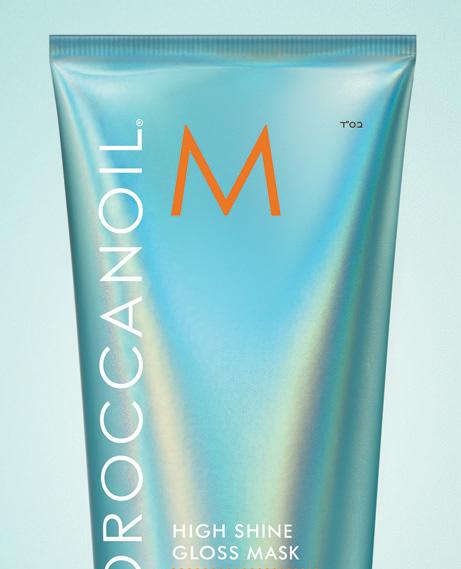



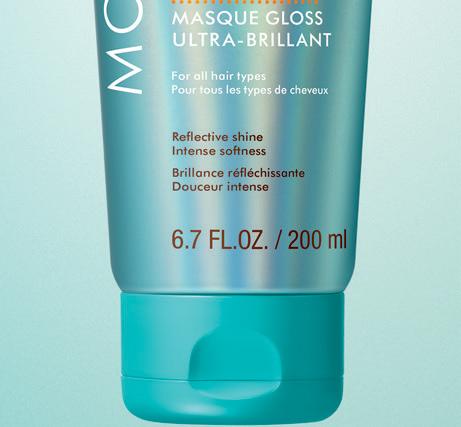










NEW High Shine Gloss Mask. After one use, 95% agreed hair has a gloss-like fi nish.*



*Study of 79 women ages 18-65, on the effects
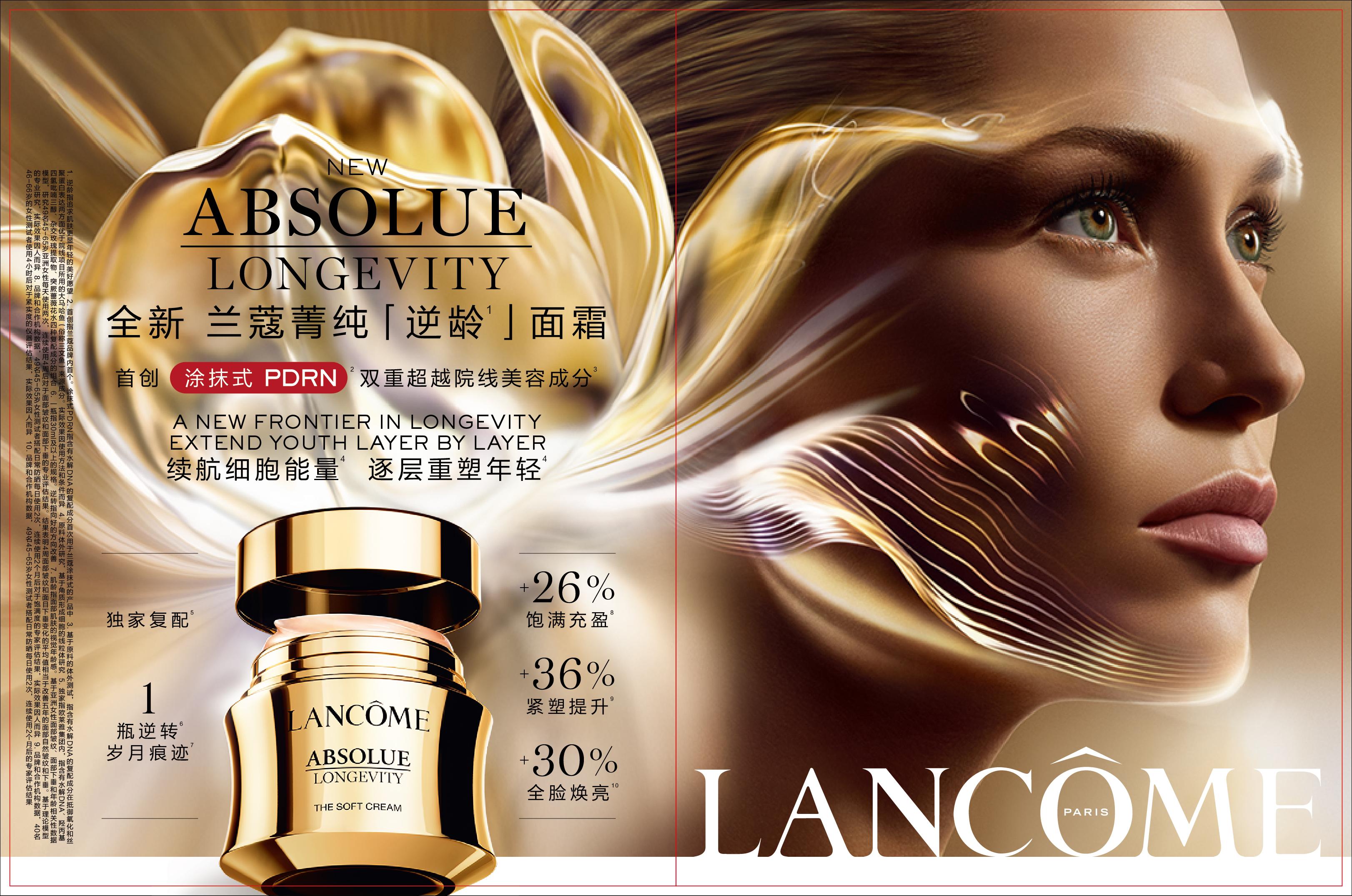





















NEW High Shine Gloss Mask. After one use, 95% agreed hair has a gloss-like fi nish.*



*Study of 79 women ages 18-65, on the effects


As we gather for TFWA Asia Pacific in Singapore, the region’s travel retail landscape reveals a fascinating study in contrasts. While passenger numbers have rebounded impressively, Asia’s recovery continues to unfold in unexpected ways, with market dynamics shifting significantly.
China, once the undisputed engine of Asian travel retail, is navigating economic headwinds, with Hainan experiencing marked sales declines. Beijing has responded with a strategic pivot, implementing unprecedented visa liberalization and innovative duty free initiatives to attract international visitors. The results are encouraging, with international arrivals increasing by over 40% since implementation, and cruise tourism emerging as a notable beneficiary.
Meanwhile, India has established itself as Asia’s most dynamic market. With the economy set to exceed US$4 trillion and overtake Japan this year, India’s travel retail industry is experiencing remarkable momentum. The imminent opening of Noida International Airport highlights the country’s urgent infrastructure expansion to meet surging demand.
After weathering significant disruption following the loss of Chinese group tourists and subsequent overreliance on daigou resellers, South Korea is undergoing meaningful transformation. With bulk sales restrictions reinstated in early 2024, the industry is evolving toward a more curated, customer-centric model. Recent regulatory reforms, including reduced licensing fees and the relaxation of liquor purchase limits, are creating a more supportive environment. Major operators like Lotte and Shilla are responding by enhancing their retail environments with immersive experiences and focusing on attracting individual travelers.
The industry’s key players are positioning for this evolving landscape. Avolta continues expanding its footprint across APAC with notable contract wins at Shanghai Pudong and Shenzhen Bao’an, along with its strategic acquisition of Hong Kong-based Free Duty. Meanwhile, homegrown players like Wangfujing Group are implementing innovative “Beyond Duty Free” strategies that blend traditional retail with rapidly expanding duty free enterprises.
As our industry convenes in Singapore, the resilience and creativity on display reinforce our conviction that despite ongoing challenges, Asia Pacific remains the powerhouse of global travel retail. TFWA Asia Pacific offers an unparalleled platform to explore these transformative trends, and we at Global Travel Retail Magazine look forward to joining you for what promises to be an inspiring event.

Kindest regards,

HIBAH NOOR Editor-in-Chief hibah@gtrmag.com
Global Travel Retail Magazine (ISSN 0962-0699) is published seven times a year by Paramount Publishing Company Inc. The views expressed in this magazine do not necessarily reflect the views and opinions of the publisher or the editor. May 2025, Vol 37. No. 3. Printed in Canada. All rights reserved. Nothing may be reprinted in whole or in part without written permission from the publisher. Paramount Publishing Company Inc.
GLOBAL TRAVEL RETAIL MAGAZINE Tel: 1 905 821 3344 www.gtrmag.com
PUBLISHER Aijaz Khan aijaz@globalmarketingcom.ca
EDITORIAL DEPARTMENT
EDITOR-IN-CHIEF Hibah Noor hibah@gtrmag.com
DEPUTY EDITOR Laura Shirk laura@gtrmag.com
SENIOR EDITOR Wendy Morley wendy@gtrmag.com
SENIOR CORRESPONDENT Atoosa Ryanne Arfa atoosa@gtrmag.com
SENIOR WRITER Alison Farrington alison@gtrmag.com
ART DIRECTOR Jessica Hearn jessica@globalmarketingcom.ca
ADVISORY BOARD
Gary Leong Thomas Henningsen
CIRCULATION & SUBSCRIPTION MANAGER accounts@globalmarketingcom.ca


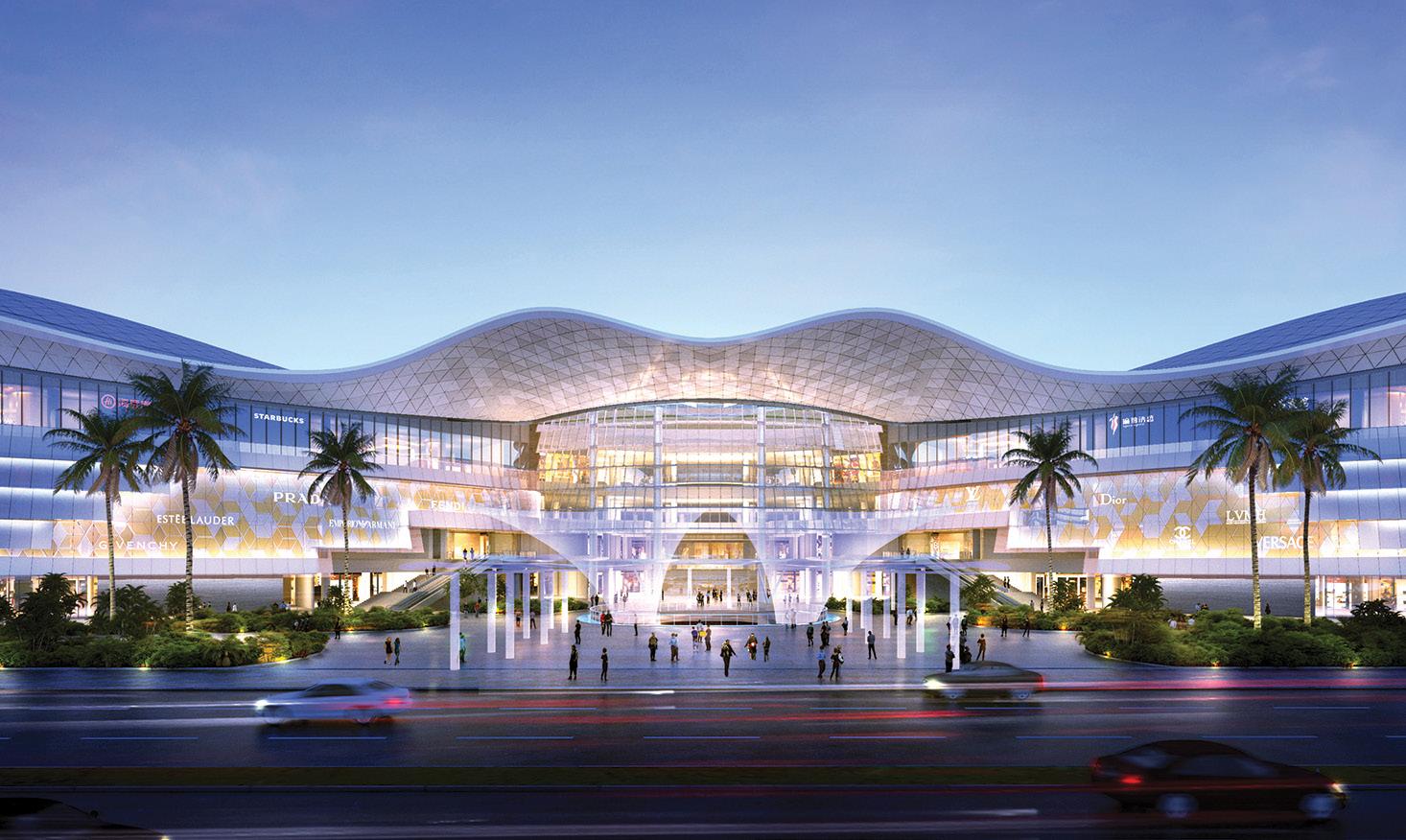
16 25 years of excellence
Qatar Duty Free (QDF) is preparing for an unforgettable 25th anniversary in 2025. Chief Retail and Hospitality Officer Thabet Musleh reveals how bold innovation and immersive, world-class experiences are powering QDF’s momentum, and how the very best is yet to come
26 Seoul-searching
South Korea’s duty free sector is moving beyond its reliance on bulk resellers toward a more curated, customer-centric model. As new policies take effect, operators are focusing on experiences and products that attract a wider range of travelers and drive sustainable growth
44 Redefining China’s retail frontier
Wangfujing Group is redefining China’s tourism and retail landscape with its “Beyond Duty Free” philosophy. This innovative, multi-format approach blends the company’s rich heritage in taxable retail with an expansion into the offshore duty free market
50 An urgent need to expand
With the opening of Noida International Airport scheduled for spring, Global Travel Retail Magazine speaks to CEO Christoph Schnellmann. He discusses the emergence of India as an aviation hub, as well as the prioritization of increased connectivity in the region
20 Driving global growth
Despite economic challenges and changing travel patterns, Asia Pacific remains the powerhouse of global travel retail, with emerging markets and demographic shifts creating significant long-term opportunities
30 China pivots
As economic headwinds intensify, China implements strategic visa-free policies and duty free initiatives to revitalize tourism and counter slowing luxury sales
34 Taking over APAC
Avolta’s growth in the Asia Pacific region is rooted in a “win-win-win” strategy that creates value for airports, brands, and operators alike, according to Freda Cheung, President and CEO of Asia Pacific at Avolta. With an ever-growing presence, a powerful new loyalty engine and a traveler-centric mindset, the company is laying the groundwork for long-term growth and success in the region
40 Blending exclusivity with accessibility
Delhi Duty Free’s focus on customer-centric offerings, digital innovation and sustainability is shaping the future of travel retail in India. Ashish Chopra, CEO of Delhi Duty Free, shares insights into the company's commitment to blend exclusivity with accessibility for its increasingly diverse customer clientele

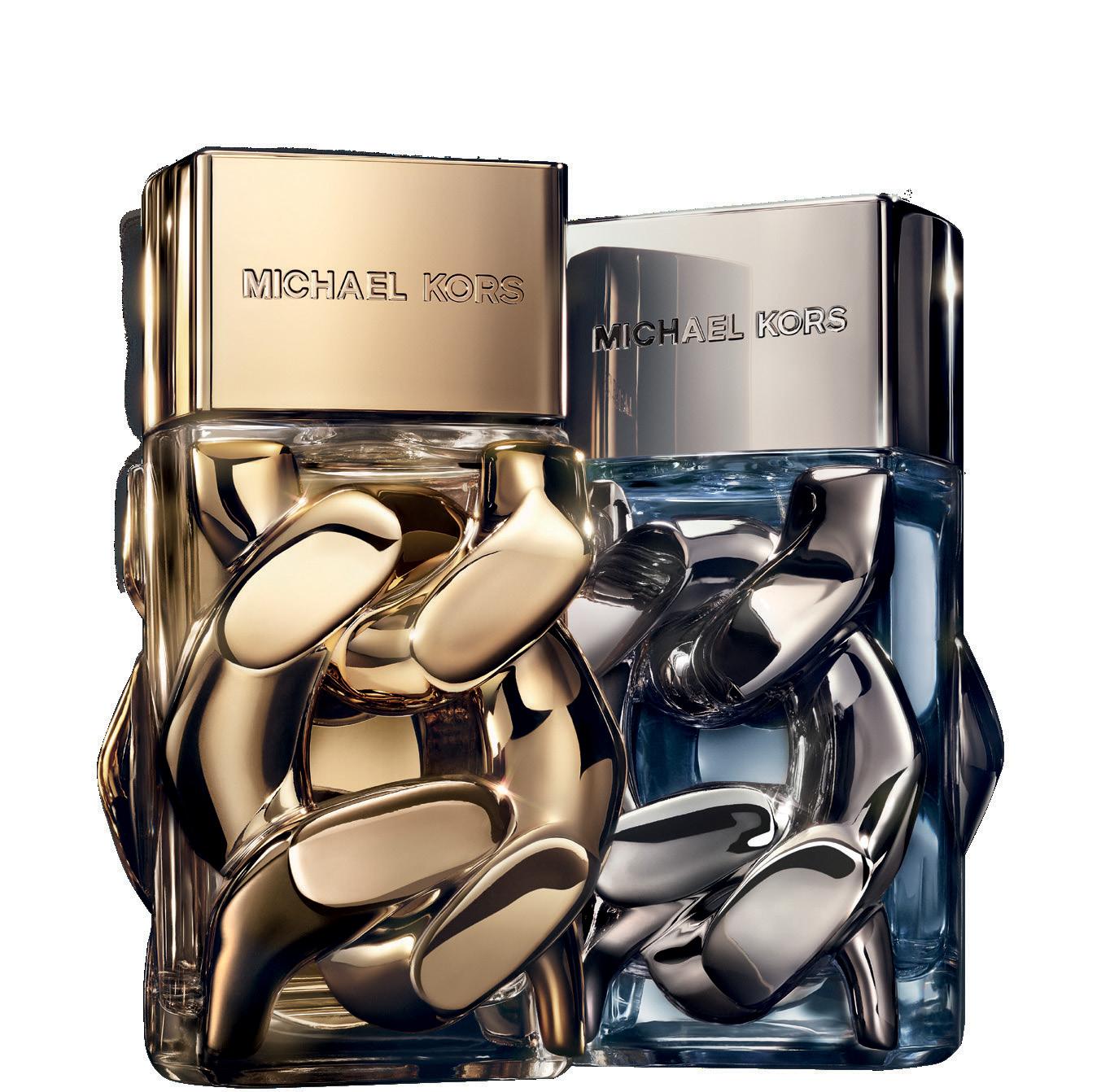
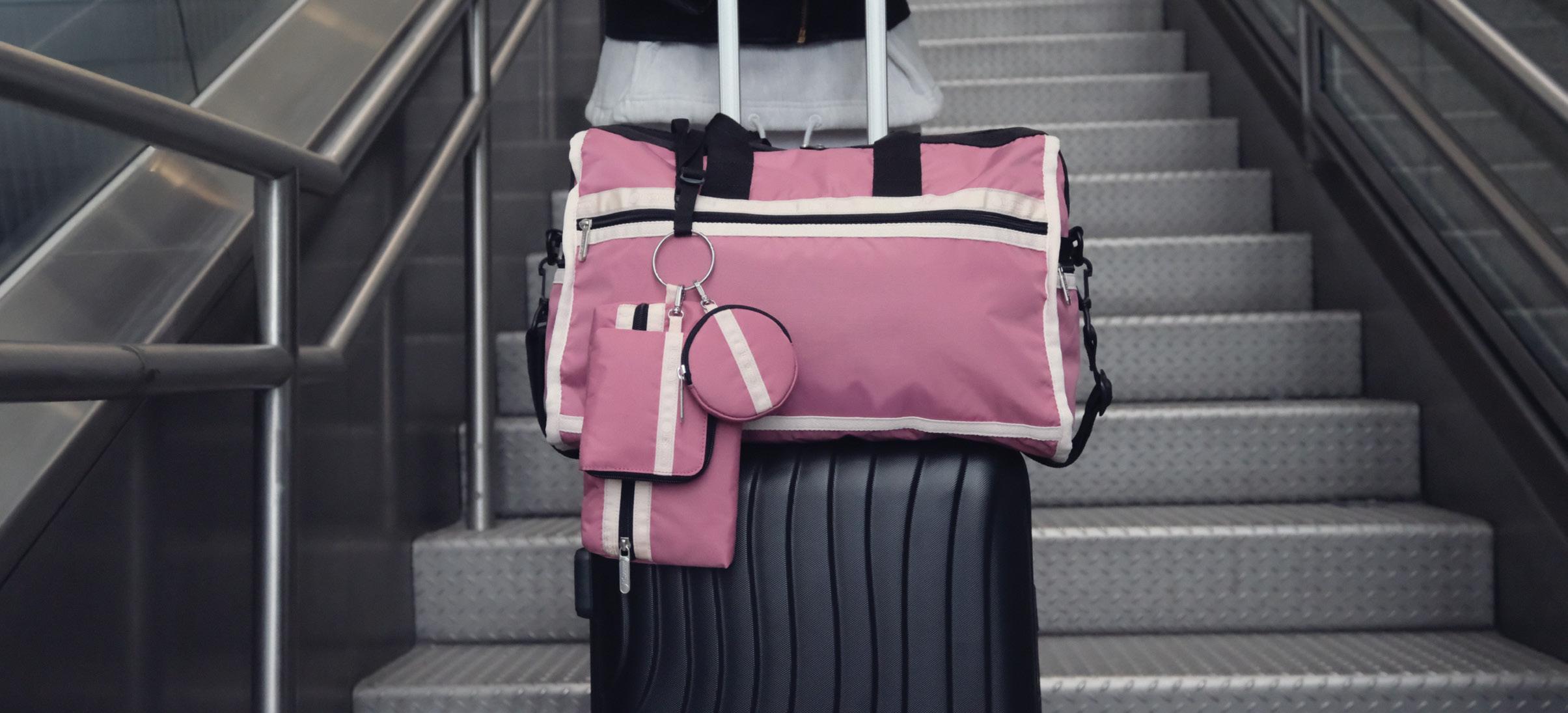
46 Preparing for the world stage
Kansai International Airport (KIX) has unveiled a major Terminal 1 renovation ahead of the Osaka-Kansai 2025 Expo, enhancing capacity, efficiency and the passenger experience. As the gateway to this global event, KIX is preparing to welcome millions of visitors with upgrades that reflect a commitment to innovation, comfort and operational excellence
56 Generation disruption
As this interview with Global Travel Retail Magazine reveals, Blueprint and m1nd-set’s workshop “The Asia Pacific Revolution” in Singapore will discuss how Chinese, Indian and Korean Gen Z travelers – set to become travel retail's dominant demographic by 2028 – are fundamentally reshaping the industry
60 The go-to partner for global brands
Coty enjoyed a robust net revenue growth of roughly 20% in travel retail in FY 2024, driven by a strong geographic footprint, multicategory expansion and effective collaborations with key retailers
62 New kids on the beauty block
Gen Alpha has become a major new demographic target for beauty and skincare brands, motivating industry names to adopt tech-first, playful approaches. Read on to learn about Mavala’s new brand identity and Elizabeth Arden’s packaging revamp
68 A moment of indulgence
Moroccanoil’s next steps in global expansion and a look at the future of the beauty category in travel retail
70 Holistic taste experience
From nutrient-packed snacks and better-for-you options to purposeful eating, we dish on the latest trends in confectionery and food; plus, more on the power of social media
76 Big on baggage in travel retail
In this Baggage Report, Global Travel Retail Magazine hears from category players about the importance of circular design, the latest on b-leisure travel in Asia and product development trends
80 Premium pursuit
As travel retail rebounds across Asia Pacific, spirits brands are navigating diverse market dynamics through premium offerings, exclusives and innovative approaches to capture the attention of a new generation of consumers with evolving preferences and increasing purchasing power
82 Keeping up with the diverse returning traveler
Key consumer-driven trends across the spirits category of premiumization, exclusivity and craftsmanship show no signs of slowing down. Global Travel Retail Magazine connects with leading names in the channel to discuss emerging segments, evolving trends and new developments
86 Curious connections
Philip Morris International (PMI) has revealed a collaborative installation and interactive platform, IQOS Curious X, as part of Milan Design Week, created in partnership with Italian design firm SELETTI. Global Travel Retail Magazine was on location at Milan Design Week to take part
88 Seeking an alternative
JT International (JTI) on its innovative brand Ploom and how the company’s vision extends further with the growth of its reduced-risk product category; plus, Mevius wins big with a strong festive season

We’re pioneering the travel experience revolution. Combining the best of Autogrill, Dufry, HMSHost & Hudson.


According to a new report from China Trading Desk, Chinese travelers are on track to make 200 million international trips per year by 2028, with 155 million expected in 2025 alone. The Q1 2025 China Outbound Travel Sentiment Survey reveals evolving travel patterns, including increased spontaneity with 77% booking less than a month in advance. High-spending Chinese tourists are transforming luxury retail and duty free sectors, with 28% budgeting over US$6,800 per trip. Singapore remains the top destination (17%), followed by Japan (16%) and South Korea (13%). Digital influence is paramount, with 61% of travelers guided by social media promotions when shopping at airports.
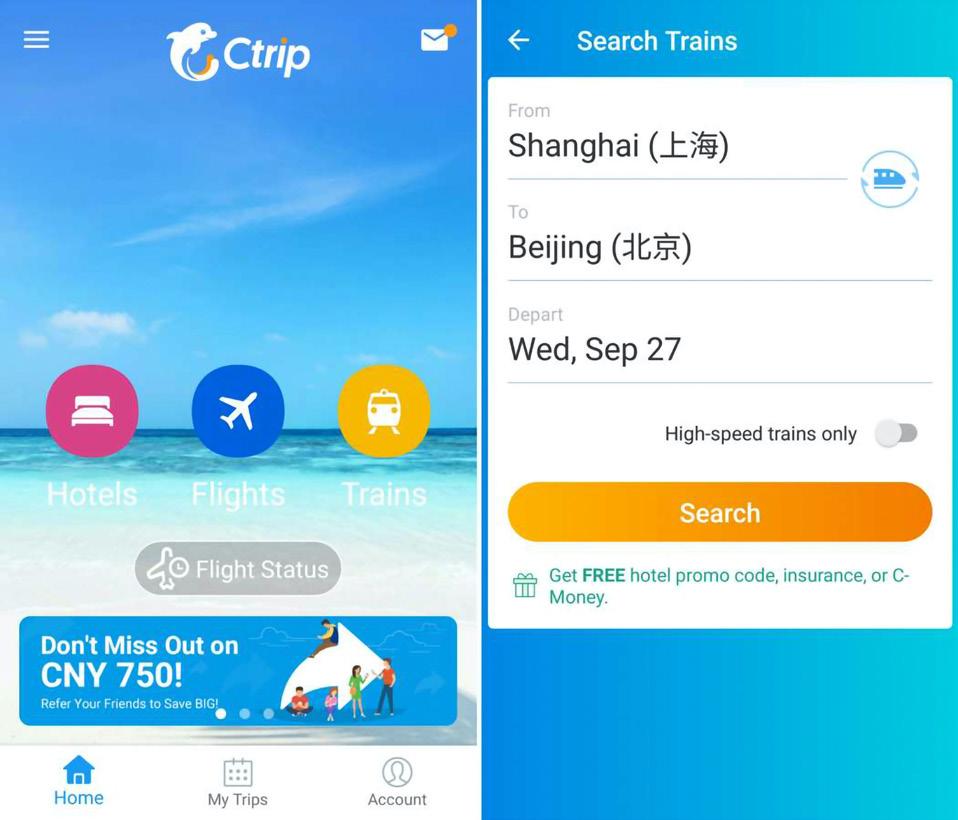
At the APTRA Conference in Mumbai, Sunil Tuli, President of APTRA and Group CEO of King Power Group, delivered a keynote on the dynamics shaping India’s travel retail sector and opportunities to expand revenue.
He began by addressing two key forces influencing the industry today: escalating global trade tensions and India’s growing momentum. Tuli humorously remarked, “Well, we’ve picked quite a time to tell you about the exciting opportunities of doing business in India.” While acknowledging the industry's lack of control over geopolitics, he encouraged the sector to focus on what it can control: capitalizing on the economic potential that India offers.
“Even before the current tariffs battle, the world economy was already throwing a range of diverse challenges at us,” stated Tuli, pointing to mounting pressures across key duty free categories, including:
Confectionery: Cocoa prices have doubled due to climate change and supply chain disruptions in Ghana and the Ivory Coast
Beauty: Inflation, supply issues, and evolving consumer expectations in line with CSR are weighing down the category
Spirits: Tariffs on China and European cognac are hitting high-value brands
Despite the category pressures, Tuli remains optimistic about India’s long-term outlook. Inflation is down, consumer spending is up, and India’s GDP is nearing US$4 trillion.
India is expected to surpass Japan’s economy this year and Germany’s by 2027. It’s also on track to overtake China in population by 2025, with Gen Z set to drive future consumption.
India is set to see a rise in passenger traffic, with yearon-year growth anticipated at 5-6%. The government’s US$11 billion plan to build 400 airports by 2047, combined with large aircraft orders from airlines including Air India, highlight the country’s growing aviation industry. Navi Mumbai International Airport, opening this year, expects an estimated capacity of 90 million by 2036.





Ospree Duty Free celebrated its first anniversary at this year’s APTRA Conference in Mumbai, marking a key milestone. The occasion followed Mumbai Travel Retail Private Limited’s rebrand as Ospree Duty Free at the APTRA India Conference in Delhi one year ago. This year, Ospree marked the anniversary as a Platinum Sponsor, hosting a vibrant dinner gala and generating social media buzz with the hashtag #OspreeTurns1. CEO Gaurav Singh reflected on a successful first year, remarking that “the journey has been fantastic” while highlighting Ospree’s strong momentum and ambitions in India’s travel retail sector.
In just one year, Ospree has rapidly expanded its presence across key Indian airports, including Mumbai, Ahmedabad, Amritsar, and Jaipur, backed by significant investments in both arrival and departure terminals.
Internationally, Ospree took its first step into overseas retail with Le Marché Duty Free at the Eurotunnel terminal in Coquelles, France. “We wanted to start small and test the waters,” Singh said, adding that the new outlet has seen double-digit growth in its first year.
Still, the company’s primary focus remains India. He emphasized India’s retail potential, citing a 21.5% CAGR over the next few years. “I see opportunity in terms of how the growth is driving the overall business,” Singh said.
Travel retail distribution specialist Blue Chip Group is celebrating new listings for two key brands.
The luxury fragrance brand Memo Paris featured with The Shilla Duty Free in Singapore Changi Airport, Terminal 1, Departure Hall East at the end of March, and Japanese skincare brand suisai will be introduced at Hong Kong International Airport’s East Hall South in May.
The Memo Paris launch, and its first standalone counter, at Singapore Changi signifies a strategic expansion for the brand in the APAC region.
Flora Lee, Managing Director of Blue Chip Group says, “Our ongoing partnership with Memo Paris reflects our shared vision of providing exceptional experiences in travel retail. We aim to elevate Memo Paris to a new dimension across the APAC region, connecting its craftsmanship with fragrance enthusiasts.
“With accessible pricing, proven effectiveness, and convenience for travelers, suisai offers an attractive proposition for those visiting Hong Kong Airport. We anticipate a strong synergy between the brand’s potential and the needs of the Hong Kong market.”
Blue Chip Group has previously launched other Kao brands in the same location.
PATA’s Asia Pacific Visitor Forecasts 2025-2027 analyzes 39 destinations under three scenarios. The report identifies Mongolia, Türkiye, Sri Lanka and Japan as standout performers expected to exceed pre-pandemic visitor numbers at the fastest rates.
Under the optimistic scenario, 950 million visitors are expected to visit the region by 2027, while even the
conservative scenario shows considerable growth to 690 million. Digital transformation, sustainable tourism developments and initiatives like Thailand's “Six Countries, One Destination” are helping to support the positive growth. The USA, Hong Kong SAR and South Korea rank among the top source markets for visitors to the region, with China maintaining its position as the largest contributor.

With activations such as Live the F1 Life, QDF transformed Hamad International Airport into an immersive Formula 1 experience, featuring an F1 car on display, racing simulators, themed dining, influencer surprise and delights, exclusive brand partnerships, celebrity appearances and much more
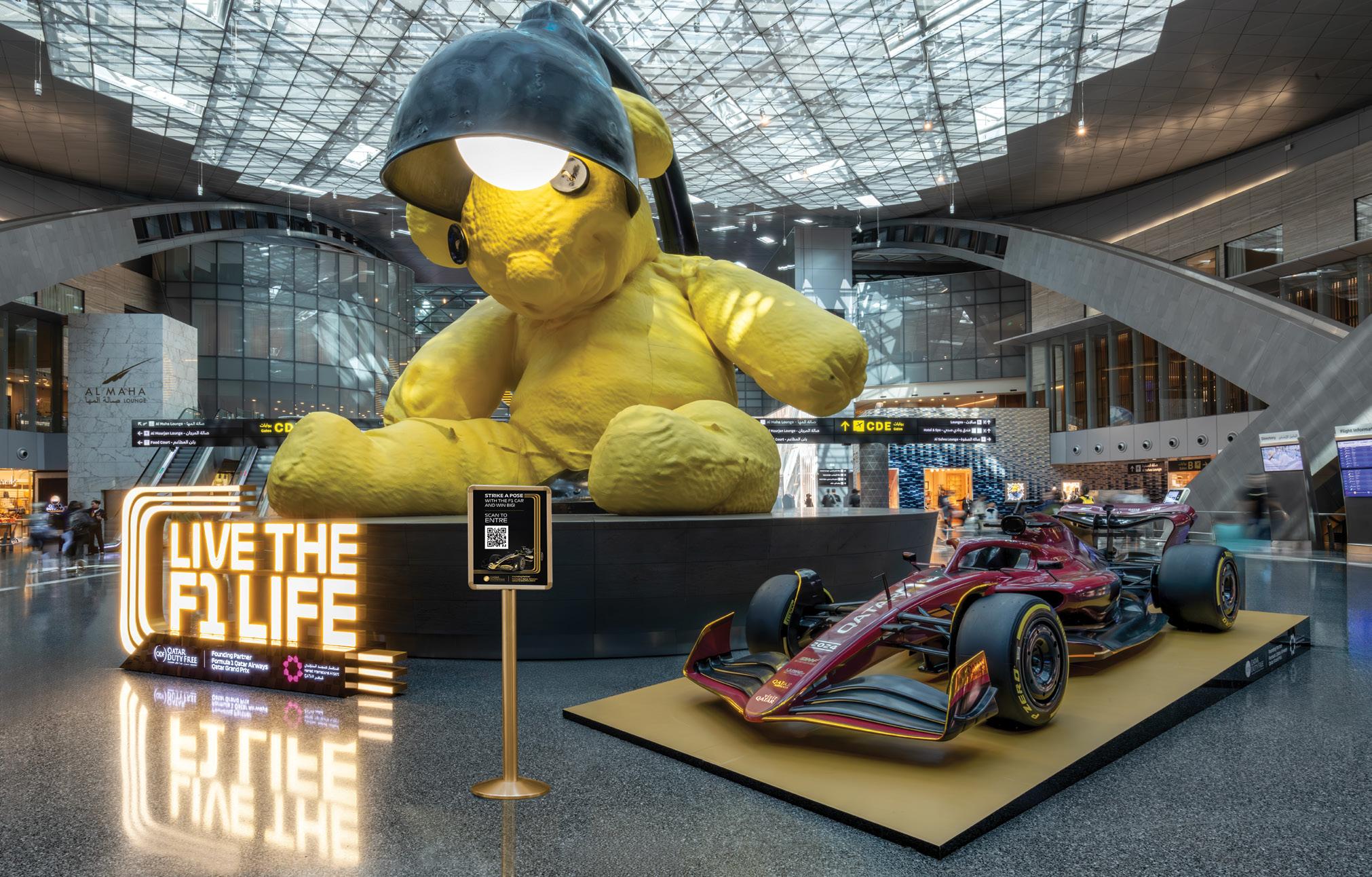
Qatar Duty Free (QDF) is preparing for an unforgettable 25th anniversary in 2025. Chief Retail and Hospitality Officer Thabet Musleh reveals how bold innovation and immersive, world-class experiences are powering QDF’s momentum, and how the very best is yet to come
by HIBAH NOOR
In 2024, Qatar Duty Free (QDF) recorded an impressive 18% year-on-year surge in sales for the annual year, surpassing the growth in passenger traffic at the awardwinning Hamad International Airport. “Growth like this doesn’t happen by chance,” says Musleh. “It comes down to keeping things fresh, relevant and exciting.”
Through a curated mix of global powerhouse brands, customer-centric experiences and a workforce that serves as the heart of its success, QDF is transforming the airport into a destination that goes far beyond a mere transit hub.
As QDF eagerly prepares to celebrate its monumental 25th anniversary, it’s ready to raise the bar even higher.
Milestone anniversary “2025 is our 25th anniversary, and we’re taking things up a notch,” says Musleh. In celebration of this symbolic milestone, QDF will unveil more than 25 new openings. This follows a standout 2024 that introduced industry firsts such as the world’s first Dior Luxury Beauty Retreat at an airport, the first-ever “pentarchy” campaign with YSL Beauty, and the first-ever full Chanel airport takeover.
While details are still under wraps, Musleh hints at headline-making debuts that will range from never-before-seen brand concepts to world-first partnerships, stating, “One thing’s for sure: we’re making this milestone one year to remember.”
2025 is already shaping up to be a landmark year. In April, Hamad International Airport was awarded SKYTRAX’s World's Best Airport Shopping for the third consecutive year. One month earlier, the airport marked a major milestone with the grand opening of Concourses D and E. These additions are part of a long-term terminal expansion strategy launched in 2018 to enhance both capacity and experience. With this latest phase, the airport now accommodates over 65 million passengers annually and introduces 2,700 square meters of brand-new, purposebuilt retail space, paving the way for a new era of shopping, dining and discovery.
“One of the biggest advantages we
Bringing in top-tier global talent is reflected in the recent appointment of six women executives, each bringing deep expertise and a passion for bold, boundarypushing ideas. As the 25th anniversary approaches, these fresh perspectives are shaping a new era of retail and hospitality

have is how seamlessly retail, hospitality and travel work together,” says Musleh. This integrated ecosystem that unites QDF, Hamad International Airport and Qatar Airways crafts an experience that flows through every stage of a passenger’s journey. “It’s a true trinity partnership,” Musleh notes, adding that the 25th anniversary will unfold across the end-to-end travel experience. “We can do things that simply aren’t possible elsewhere.”
QDF anchors its approach in a philosophy of experiencentricity, a commitment to turning travel moments into unforgettable memories. Whether it’s racing in a Formula 1 simulator during the Live the F1 Life campaign, indulging in a wellness layover at the Dior Luxury Beauty Retreat, or stepping into a Chanel winter wonderland, QDF’s experiences are curated to be remembered long after takeoff.
Powered by people
A dynamic and global team drives
QDF’s success. “We know that building something truly exciting starts with the right people,” states Musleh. “As we celebrate our 25th anniversary, this people-first approach remains front and center.”
Part of the strategy includes deliberately bringing in top-tier talent from around the world. “These individuals not only bring deep expertise in their fields, but also share our appetite for bold thinking and boundary-pushing ideas,” according to Musleh. With fresh perspectives and the ability to challenge the status quo, these appointments have helped turn ambition into reality as the 25th anniversary approaches. “In order to build a new era of retail, hospitality and experiences, we need a leadership team that’s not afraid to ask ‘what’s next’ and then go out and make it happen.”
In the past three years alone, QDF’s workforce has tripled, growing to over 5,000 people from 78 different nationalities. That global mix has helped shape QDF into a place where ideas are
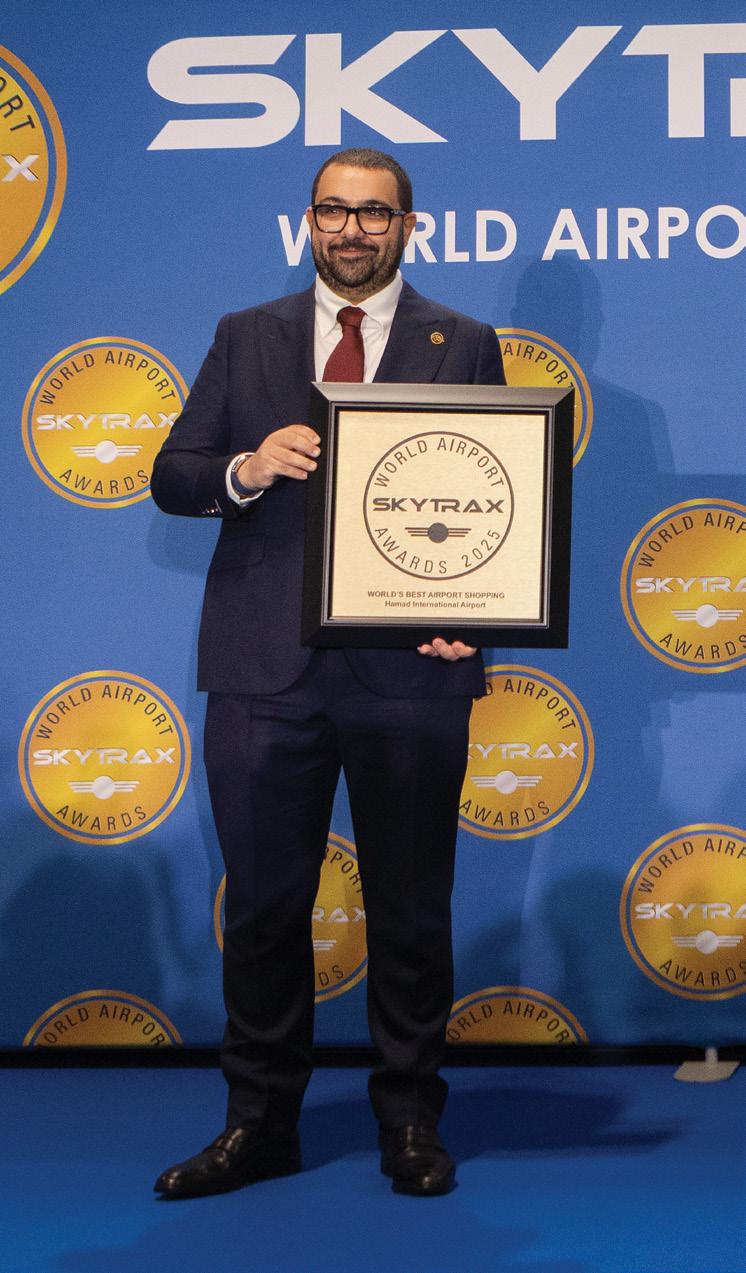
welcomed and where innovation is a shared mindset. “Our focus has always been on building a team that reflects the energy, creativity, and ambition behind everything we do,” according to Musleh.
Earlier this year, QDF expanded their leadership team with six top women executive appointments, a move that reflects its commitment to creating space for diverse talent to grow and lead. “The year is as much about our team as it is about our achievements, and we’re continuing to support and invest in the people who’ve made QDF what it is today,” says Musleh.
Sports serve as one of the most powerful ways QDF creates exclusive moments for passengers. Qatar has solidified its place on the global stage as a premier host of world-class sporting events, from the Qatar Airways Qatar Formula 1 Grand Prix to the Qatar ExxonMobil Open and the Commercial Bank Qatar Masters. QDF actively supports
This past winter, Chanel marked its firstever full airport takeover with its Chanel Winter Tale campaign, transforming the entire airport into an enchanting wonderland and showcasing QDF’s experiencentric approach to luxury retail

this momentum as an official partner and sponsor of these internationally recognized competitions. “As Qatar continues to attract more visitors, our goal is to make sure the airport experience matches the energy and ambition of the country’s tourism scene,” states Musleh.
True to that vision, QDF goes beyond traditional sponsorship. “We’re making sure that the excitement of sport doesn’t stop at the stadium. It starts the moment
travelers arrive,” Musleh says. Through activations such as Live the F1 Life, QDF transformed the airport into a Formula 1 universe, complete with a real F1 car, racing simulators, themed dining menus, and impactful duty free partnerships with brands such as Jack Daniels and Velo.
Legendary sports icons such as Lewis Hamilton and Novak Djokovic have also surprised passengers, turning
ordinary transits into once-in-a-lifetime moments. Ahead of the Qatar ExxonMobil Open, Djokovic rallied with young tennis talents on an airside court, while Hamilton previewed his new film near ORCHARD as the Formula 1 Grand Prix weekend kicked off.
Looking back on 25 years of success, Musleh reflects, “One thing we’re incredibly proud of is how our openings have transformed the landscape of travel retail.” The Louis Vuitton Lounge stands out as a prime example: an industry first that fuses high fashion, gourmet dining and luxury hospitality. “It was something that no one else had done, and it proved that airport retail could offer something special,” remarks Musleh. Innovations like these actively redefine what’s possible at an airport, showcasing that transit spaces can be destinations in their own right.
As QDF approaches its milestone 25th anniversary, its mission remains more ambitious than ever: to continue reimagining travel retail through fearless innovation, experiencetricity, and visionary concepts that resonate with every traveler while setting bold new standards for the future.
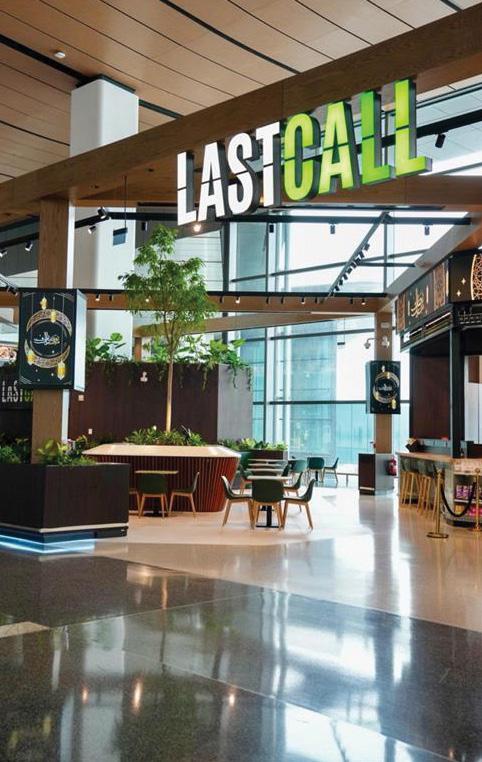
Last Call is a hybrid retail and F&B concept offering travel essentials, gifts, and grab-and-go bites in a nostalgic, airportinspired setting
ADVANCED CERAMIDE CAPSULES ARE PROVEN TO TAKE UP TO 10 YEARS OFF THE LOOK OF YOUR SKIN *
SEALED FOR OPTIMAL FRESHNESS & POTENCY

test, 25 women at 12 weeks.
by WENDY MORLEY
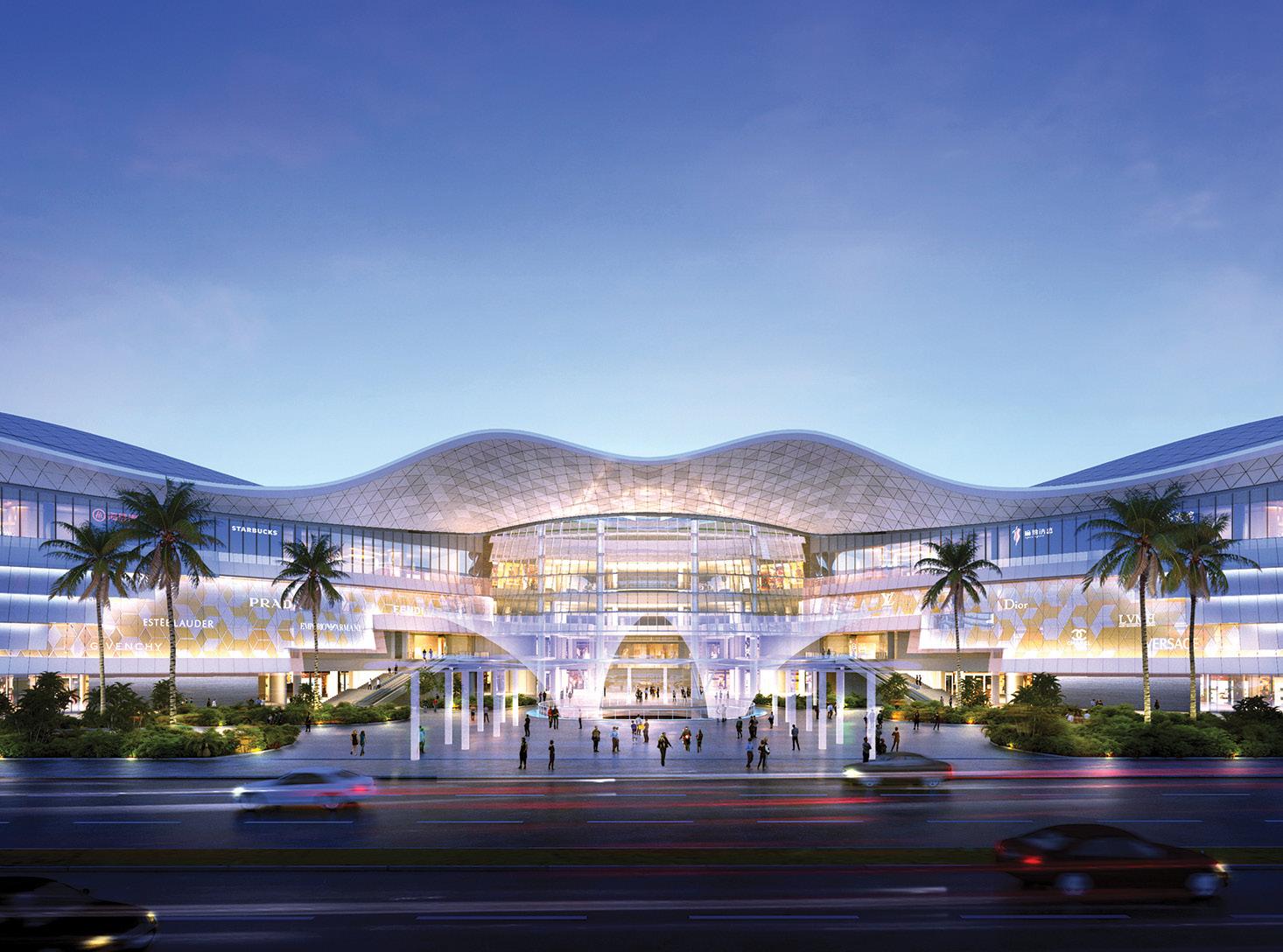
TDespite economic challenges and changing travel patterns, Asia Pacific remains the powerhouse of global travel retail, with emerging markets and demographic shifts creating significant long-term opportunities
he Asia Pacific travel retail sector continues to prove resilient despite facing significant economic pressures and shifting travel patterns across the region. From Hainan’s sales slump to India’s explosive growth, regional markets are following divergent trajectories that reshape the industry’s distribution of power.
“The travel retail market in Asia Pacific has, for many years, been the engine room of the global industry driving significant growth, and I have every confidence that it will continue to do so for decades to come, despite the changing behavioral dynamics amongst Chinese travelers and the economic downturn in other mature markets such as South Korea, Singapore and Hong Kong,” says Sunil Tuli, APTRA
President and Group CEO King Power Group (Hong Kong).
This confidence is supported by recent forecasts from the Pacific Asia Travel Association (PATA). Under that association’s “medium” scenario, international visitor arrivals to Asia Pacific are projected to reach 813.7 million by 2027, reflecting a continued upward trend from the estimated 648.1 million in 2024.
PATA CEO Noor Ahmad Hamid notes, “As global travel continues its strong recovery, the Asia Pacific region remains a key driver of growth. This latest forecast highlights the dynamic shifts in visitor flows, policy interventions and infrastructure improvements that will shape the region’s tourism landscape over the next three years.”

Regional diversity and demographic shifts
The Asia Pacific travel retail landscape extends across 45 distinct markets, from India in the west to Fiji in the east, encompassing mature economies like Japan and emerging powerhouses like


Vietnam and Indonesia. This diversity creates a complex market where retailers must simultaneously serve aging populations in developed countries while adapting to surging numbers of young consumers elsewhere.
“The underlying long-term growth for the region as a whole is underpinned by the rising Gen Z population in many significant countries that play a major role in reshaping geopolitics,” Tuli explains.
The expanding middle class across the region – particularly in India, Indonesia, Thailand and Vietnam – represents a powerful force in travel retail. These consumers have both the financial means and desire to explore international destinations, creating a natural audience for travel retail offerings.
“It’s an exciting opportunity and one that we must continually adapt and prepare for to ensure travel retail stays relevant to these younger adults, offer-
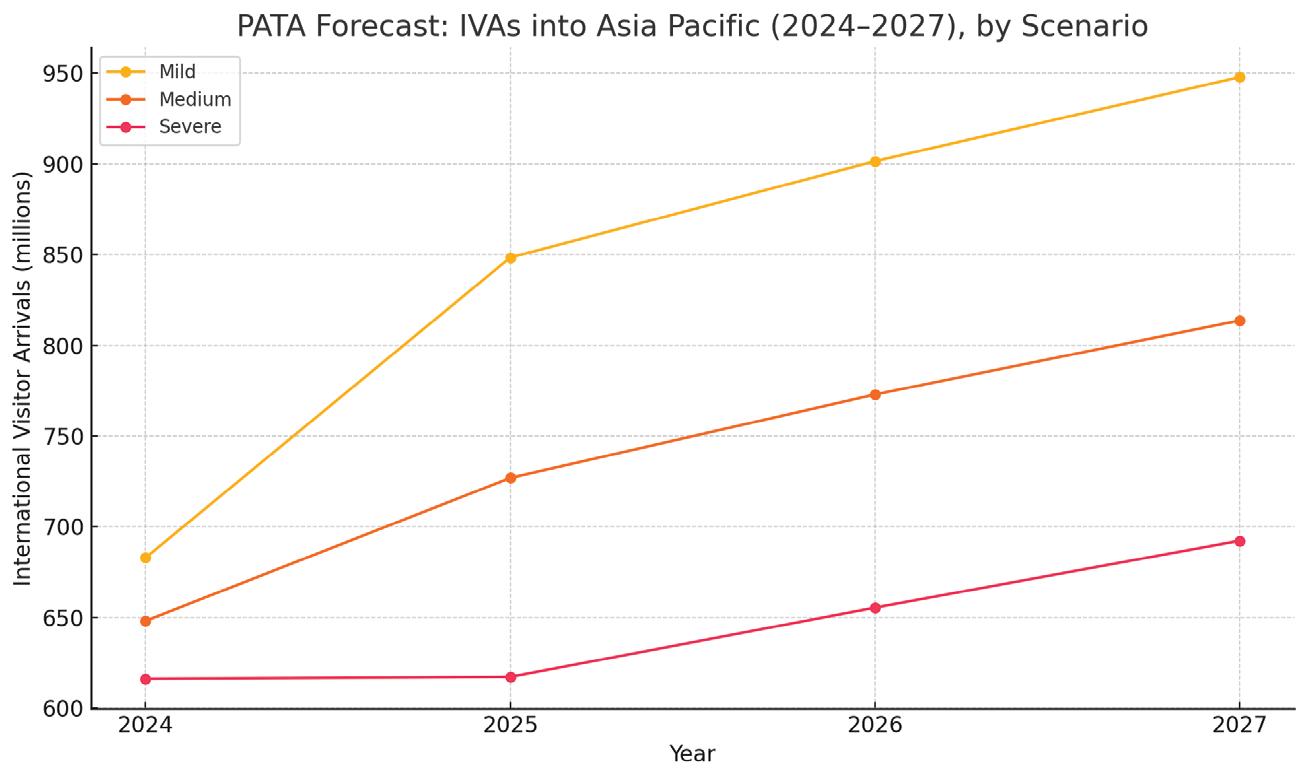
Pacific Asia Travel Association’s forecast for Asia Pacific visitor arrivals through 2027 under three scenarios: mild (optimistic recovery with minimal disruptions), medium (moderate growth with some market challenges), and severe (conservative projection accounting for potential economic headwinds)
ing them the right brands, perhaps new categories, memorable experiences and with integrated technology along their journey to maximize engagement and conversion,” he says.
China’s recovery and transformation
Chinese outbound tourism is set to exceed 155 million travelers in 2025, surpassing pre-pandemic levels, according to China Trading Desk data. Singapore (17%), Japan (16%) and South Korea (13%) maintain dominance as the top three preferred destinations, while European destinations have climbed to fifth place in popularity.
A notable trend is the rise of spontaneous travel, with 76% of Chinese travelers now booking trips less than one month before departure, up from 73% in Q3 2024. This spontaneity extends across all demographics – even 70% of high-net-worth individuals book within a month of departure.
Luxury preferences are strengthening, with 67% of Chinese travelers now preferring four-star hotels or higher. Nearly half (49%) plan to spend at least 25,000 RMB (US$3,500) per trip, with 24% budgeting over 50,000 RMB (US$6,850).
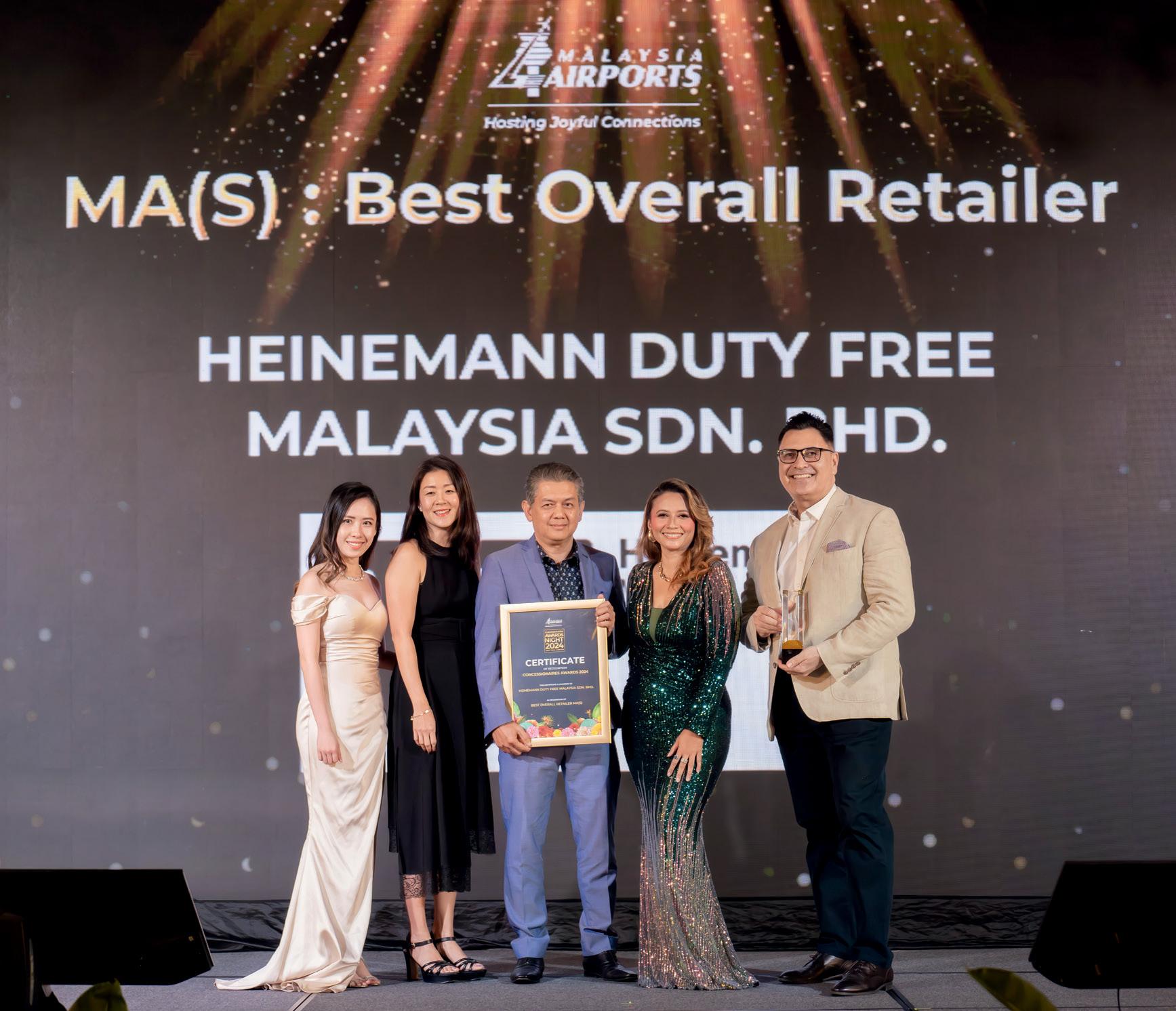
Our Heinemann Duty Free Malaysia team was awarded the Best Overall Retailer by Malaysia Airports Holdings Berhad at its 2024 Concessionaires Conference in 2024, recognizing our strong performance in product assortment, customer service, and partnership with Kuala Lumpur International Airport. This award would not have been possible without the close collaboration of our brand partners and we look forward to continuing to turn travel time into valuable time with you in 2025 and beyond.
“While the Chinese traveler is tending to stay closer to home and with many of them prioritizing personal experiences over luxury goods, there is still a huge potential in the market,” Tuli observes. “The winners will be travel retail operators and brands who pay close attention to their needs and expectations, broadening their assortment with an integrated digital strategy throughout consumer engagement touchpoints.”
Not all markets are thriving, however. Hainan, the Chinese island province popular with domestic shoppers, experienced a 29.3% year-on-year (YOY) decline in duty free sales in 2024 as China’s sluggish economy led to a reduction in tourism.
Visitor numbers decreased by 15.9%, falling to 5.68 million in 2024 from 6.75 million the previous year. Customs data revealed that visitors to Hainan spent 30.94 billion yuan (US$4.24 billion) on duty free items in 2024, down from 43.76 billion yuan (US$5.97 billion) in 2023.
According to a reliable industry source in China, “From the beginning of this year, it seems there is no good news from China and near countries in the travel retail industry. Hainan retailers sales decrease YOY every month; some retailers close to China, and brands in Asia, have begun to lay off employees.”
China is implementing strategic policy shifts to counter these challenges and boost tourism. The State Taxation Administration announced the nationwide expansion of its instant tax refund program for overseas travelers on April 8, enabling international shoppers to receive refunds at the point of purchase rather than at departure.
This policy builds on China’s unilateral granting of visa-free access to citizens from 38 countries, accompanied by extended stay durations for foreign travelers. According to data from China’s National Immigration Administration, the number of visa-free entries by foreign nationals in 2024 reached well over 20 million, more than double the previous year.
South Korea provides a case in point. Since the visa-free policy took effect, enthusiasm for travel to China has grown sharply among Korean tourists. According to the Shanghai Municipal Government, the number of South Korean visitors to the city rose by 91.18% YOY in November and 141.46% YOY in December 2024.
“Looking beyond China, ask any brand in travel retail right now and they will tell you that India is a priority market in Asia Pacific,” Tuli states. “India’s economy – as the fastest growing on the planet – is about to pass the US$4 tril-
lion mark – making it the world’s fifthlargest economy. It is set to overtake Japan this year and – if it maintains its growth path – it will overtake thirdplaced Germany in 2027.”
This monumental shift is reshaping the travel retail ecosystem. “With its mid-Asia position bridging east and west, India is front and center to the region in many ways,” explains Tuli. “The federation is fast accelerating and is set to grow exponentially, in part due to the government’s US$11 billion investment in greater aviation infrastructure and connectivity, with over 400 new airports opening by 2047 and with Indian airlines dominating the order books for new aircraft.”
Travel retail in India shows distinct category preferences among travelers. According to Tuli’s analysis of the current market, “Alcohol – led by whisky – has been the number one category for many years. However as consumer choices evolve and the cocktail trend in India continues, tequila is growing fast. Beyond Alcohol, there is a powerful sustained increase in perfume and cosmetics sales, with the Beauty category now chasing alcohol for pole position. Confectionery and Toys are also performing well and commanding more share of space.”
India’s scale presents staggering potential. “Every day, 40,000 new Indian passports are issued,” notes Tuli. “Our target audience is literally growing by the day, and we must not take them for granted.”



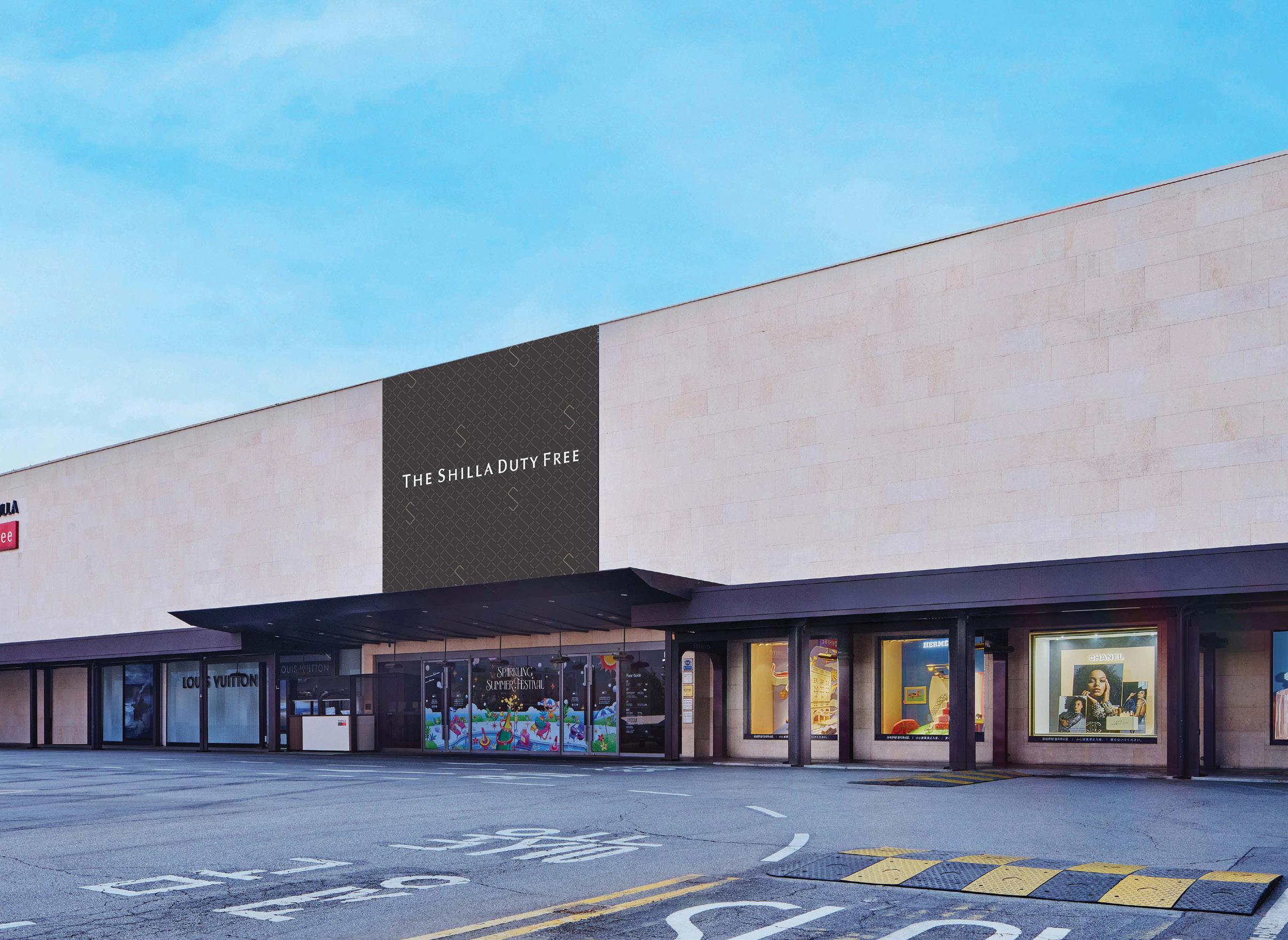
South Korea’s duty free sector is moving beyond its reliance on bulk resellers toward a more curated, customercentric model. As new policies take effect, operators are focusing on experiences and products that attract a wider range of travelers and drive sustainable growth
by ATOOSA RYANNE ARFA
South Korea’s government recently announced sweeping reforms designed to reinvigorate the duty free sector. Rolling out this spring, the changes create a more supportive regulatory framework for operators, including a 50% reduction in licensing fees and the removal of a longstanding two-bottle limit on liquor purchases. These moves form part of a broader national strategy to revitalize a market still stabilizing post-pandemic, amid shifting tourist dynamics and evolving shopping behaviors. Industry insiders welcome the reforms but stress







that further action will be needed to fully improve the sector’s potential.
The latest government interventions have provided a much-needed jolt of optimism to a sector still navigating turbulence since the pandemic. Halving licensing fees and easing liquor restrictions are expected to spur investment and encourage consumer spending. Leading players such as Lotte Duty Free and The Shilla Duty Free have voiced strong support for the changes so far.
Nam-Gung Pyo, Head of Marketing


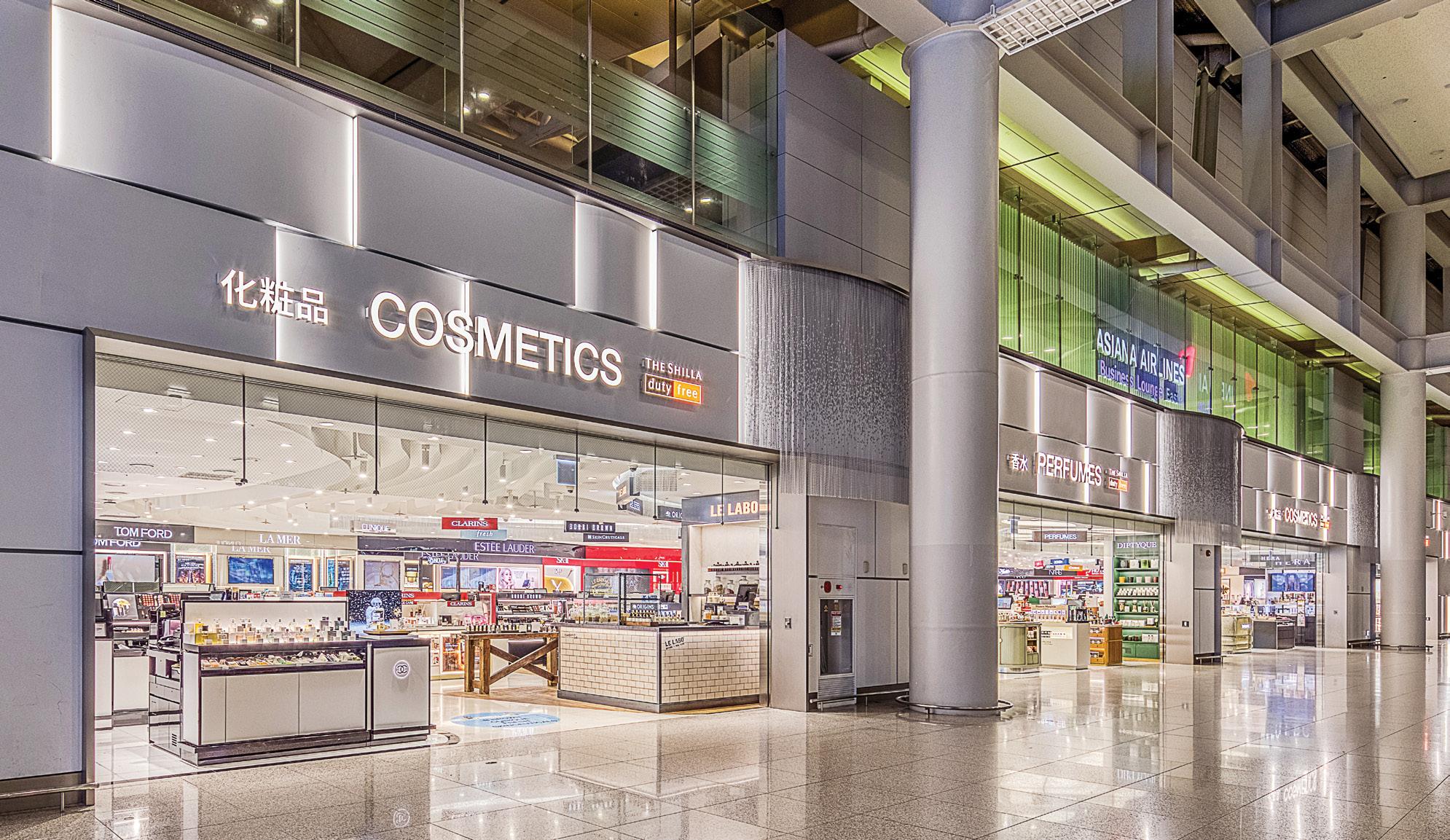
As demand shifts beyond K-Cosmetics, shoppers seek cultural and trend-driven experiences at the Shilla Duty Free
at Lotte Duty Free, believes that “the policy changes are expected to have a positive impact on both Lotte and the wider industry.” A representative at The Shilla Duty Free feels similarly, stating that “eliminating liquor bottle restrictions will significantly enhance the customer experience” and adding that the 50% reduction in licensing fees will also help address management challenges.
Yet key constraints persist. A US$400 exemption for liquor and US$800 overall duty free cap per traveler remain unchanged, an issue that continues to hamper growth. Brad Kim, Editor-inChief of South Korea-based TRNDF. com, suggests raising these limits to somewhere between US$1,200 and US$2,000 to boost spending.
In the interim, operators are recalibrating by offering smaller bottle

formats, bundling multi-bottle deals, and introducing interactive, experienceled campaigns to better engage customers under the new reforms and existing limits.
The latest regulatory changes arrive at a time of continued volatility for South Korea’s duty free sector. In 2024, the country welcomed 16.37 million foreign visitors, which is an encouraging 93.5% of pre-pandemic levels. Yet duty free sales remained sluggish, reaching just 57.2% of the sector’s 2019 peak, when revenues had hit a record KRW24.85 trillion (US$16.4 billion), driven largely by Chinese tour groups and bulk-buying daigou resellers.
“The loss of Chinese group tourists during the pandemic led to reliance on
bulk buyers, or daigou,” Kim explains. “The government temporarily lifted bulk sales restrictions, but with prepandemic regulations reinstated in early 2024, the industry is now moving away from daigou dependence.”
Fast forward to February 2025, and the picture remains mixed. Duty free sales (excluding inflight) rose 4.8% month-on-month to KRW1 trillion (US$680 million), while footfall fell 8.4% to 2.1 million customers. While the sales uptick signals some recovery compared to last year, overall performance still lags significantly behind the industry’s pre-pandemic peak.
In addition to pressures stemming from the previous reliance on daigou, several other factors are at play, including the rise of free independent travel (FIT) versus group tours and China’s

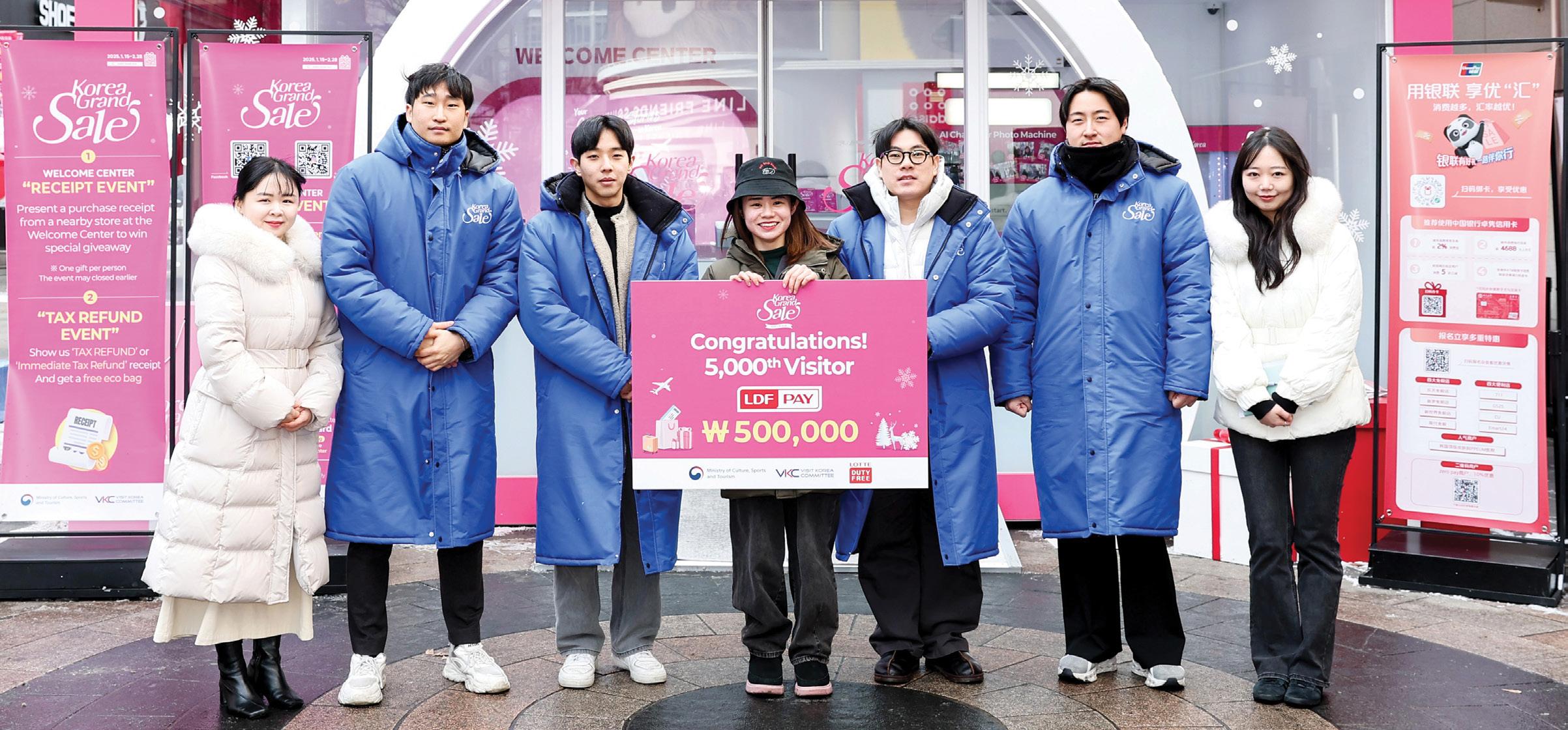
“guochao” trend that favors domestic Chinese brands over foreign brands.
Amid these shifts, operators are facing challenges. Shinsegae Duty Free shuttered its Busan downtown store in January, and Hyundai Duty Free will close its Dongdaemun outlet in Seoul this July. At the same time, high-end luxury brands such as Gucci, Cartier and Louis Vuitton have begun withdrawing their presence from duty free outlets.
From volume to value Eager to change the trajectory, duty free operators are shifting their focus from volume to profitability. Lotte Duty Free, for example, made a decisive move to halt bulk sales to daigou traders in January 2025. “While we grew through daigou sales during the THAAD crisis and COVID-19, rising commission rates hurt profitability,” states Pyo. Lotte is
now directing its efforts toward targeting new customer segments, fine-tuning its pricing and enhancing its product assortment. “We aim to transform the market structure and establish a more sustainable business model,” Pyo adds.
The Shilla Duty Free is also moving away from inefficient wholesale channels to a more targeted retail strategy. “We’re prioritizing agile responses to changing conditions and focusing on building internal stability,” says a representative from The Shilla. To that end, the company is expanding its brand portfolio, developing exclusive and premium product lines, and enhancing its retail environments with immersive pop-ups and interactive event zones.
Amid ongoing reforms, operators are leaning into innovation and strategic partnerships to attract a broader
traveler base. At Lotte Duty Free, newly appointed CEO Dong-ha Kim is leading diversification efforts, supported by a newly established marketing division focused on attracting both high-spending individuals and independent travelers. One initiative includes preparing for the anticipated return of Chinese tour groups once visa-free entry resumes later this year, with targeted promotions integrated into platforms such as WeChat Pay. The company is also broadening its brand portfolio through collaborations with labels such as Polo Ralph Lauren, Maison Kitsuné, and Dassai.
In parallel, Lotte is partnering with travel agencies to develop tailored Korean travel experiences. For example, a recent agreement with the Busan Tourism Organization aims to strengthen tourism in the region. These efforts are already showing early prom-






































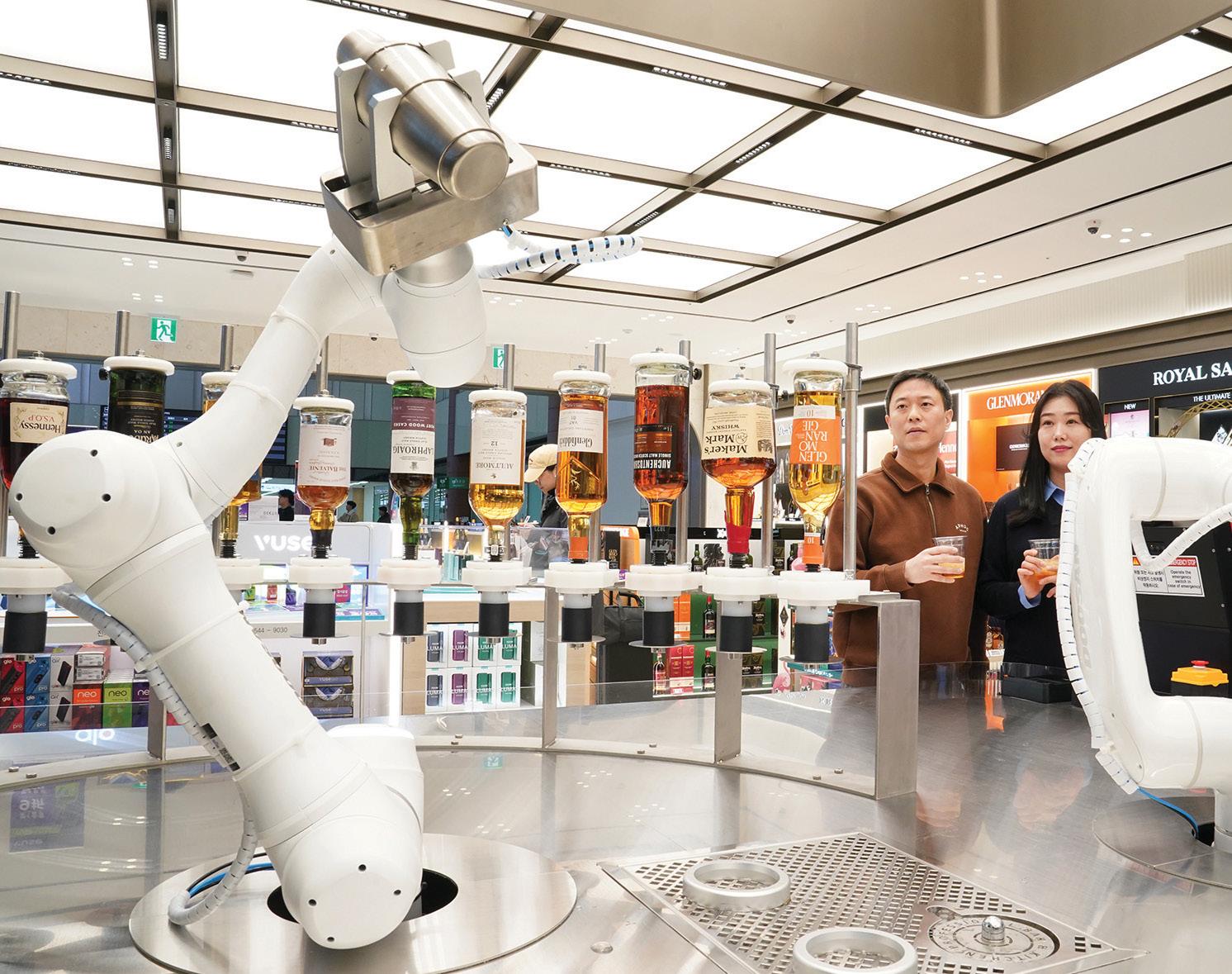
ise, with cruise passengers flocking to Lotte Duty Free’s Busan store, attracted by exclusive perks, including Gold membership cards and QRcode-enabled discounts across the rail network.
The Shilla is also evolving, securing coveted brands and enhancing services to reflect changing customer preferences. At Incheon International








Airport, The Shilla has introduced new collaborations with Augustinus Bader, Lancome, and LOEWE, and opened a TimeVallee Swiss watch boutique at its Jeju Island store. But shoppers are seeking a truly Korean experience, as well. “Demand has extended beyond K-Cosmetics to K-Fashion and Korean lifestyle items,” says The Shilla Duty Free’s spokesperson. “Shoppers now
seek immersive experiences tied to Korean culture and trends.”
South Korea’s duty free sector remains in recovery, but signs of reinvention are taking shape. With regulatory changes unlocking new strategic opportunities and operators pivoting from high-volume models, the industry is laying the groundwork for a more profitable future.

China welcomes a surge in international visitors as visa-free policies attract 9 million travelers in early 2025, marking a 40% year-on-year increase amid national economic recalibration efforts
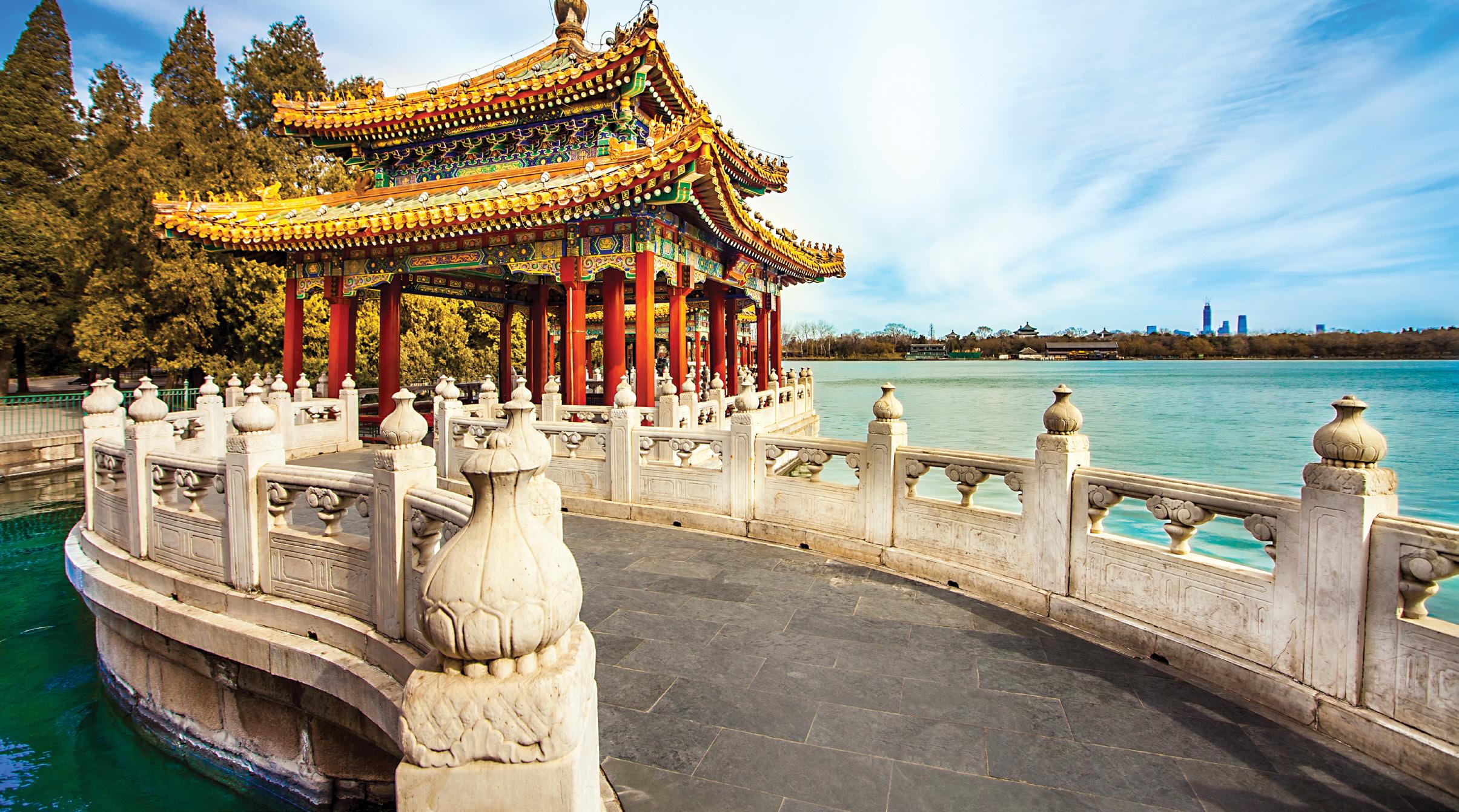
by WENDY MORLEY
China’s economy is showing unmistakable signs of strain, with slumping sales in Hainan’s duty free sector and weakened luxury and overall consumer demand prompting a bold pivot toward attracting international visitors. Industry experts note concerning trends across Asia’s travel retail landscape as economic pressures mount. Luxury companies including LVMH, Hermès and Burberry have reported substantial sales declines in the region during recent quarters, with fashion, leather goods and spirits categories particularly affected.
This downturn extends beyond mainland operations. The travel retail sector, particularly in Hainan – once touted as China’s domestic luxury shopping haven – has struggled throughout 2024/2025, with retailers reporting consistent monthly declines in year-on-year sales.
Industry insiders indicate that companies with significant exposure to Chinese markets have begun implementing workforce reductions as the slowdown persists.
The economic challenges appear structural rather than temporary. A reliable source in China explains that China’s economic weakness is the primary factor, with private businesses particularly vulnerable to failure and rising unemployment. The source indicates this negative trend shows no signs of abating. The deteriorating relationship between China and the United States further complicates the economic environment, with recent tariff escalations adding another layer of uncertainty.
In response to these economic challenges, Beijing has implemented an unprecedented series of visa liberalization measures. China has expanded unilateral visa-free access to citizens from
38 countries and extended its policy of visa-free entry for transit travelers from 54 countries, allowing stays of up to 10 days.
The strategy appears to be gaining traction. According to the National Immigration Administration, China welcomed more than 9 million inbound foreign travelers since the 240-hour visa-free transit policy took effect in December 2024 – a 40.2% increase year-on-year. Notably, 6.57 million entered visa-free, accounting for over 71% of the total.
This policy shift has helped drive an overall increase in cross-border movement. Chinese border officers handled 163 million entries and exits from January to March 2025, marking an increase of 15.3% year-on-year, with foreign nationals making 17.44 million border crossings – up 33.4% from the same period in 2024.
Cruise tourism surges
Maritime tourism has emerged as a major beneficiary of China’s relaxed entry policies. Shanghai’s international cruise terminal has reported a dramatic increase in both vessel arrivals and pas-
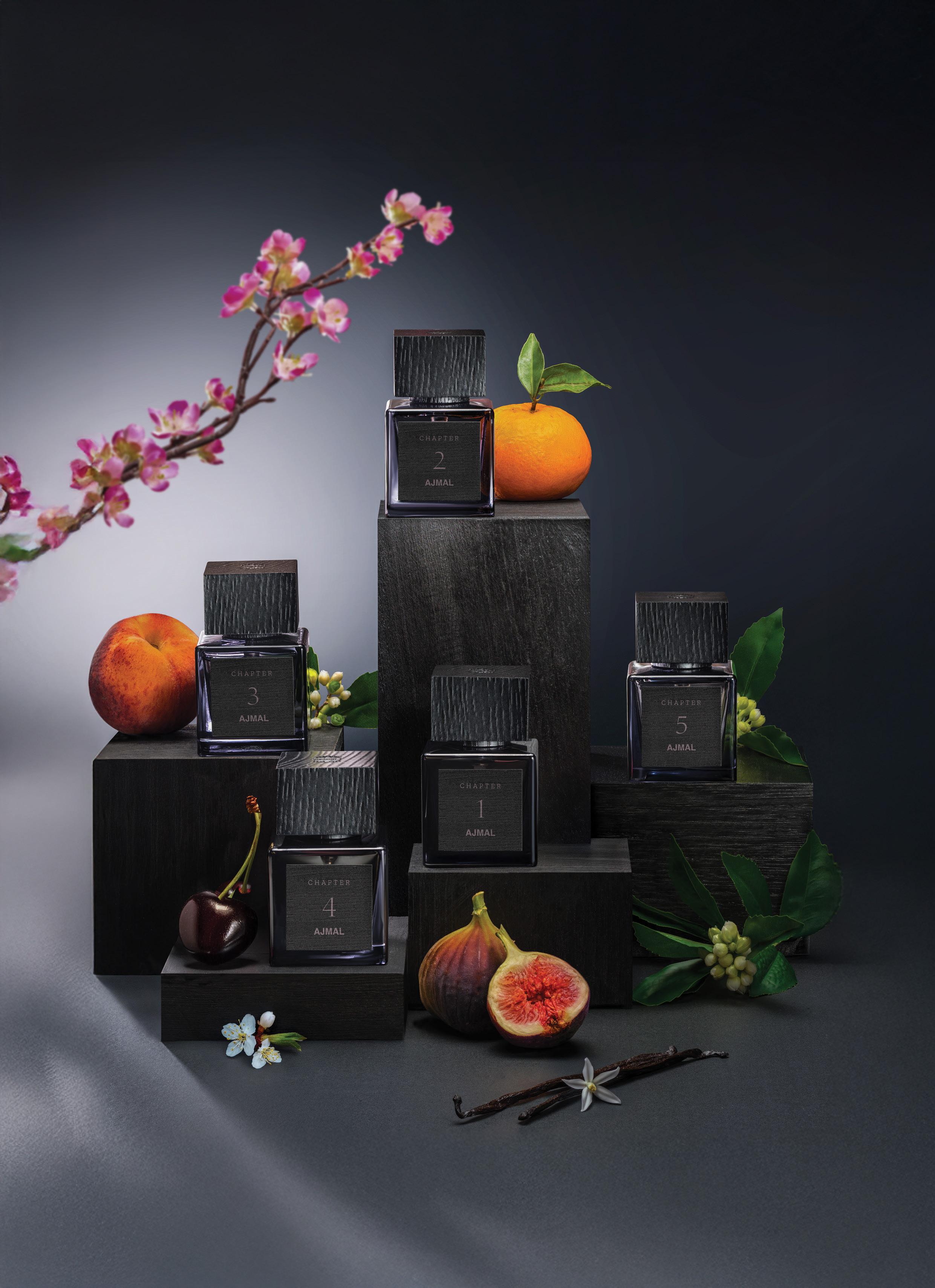
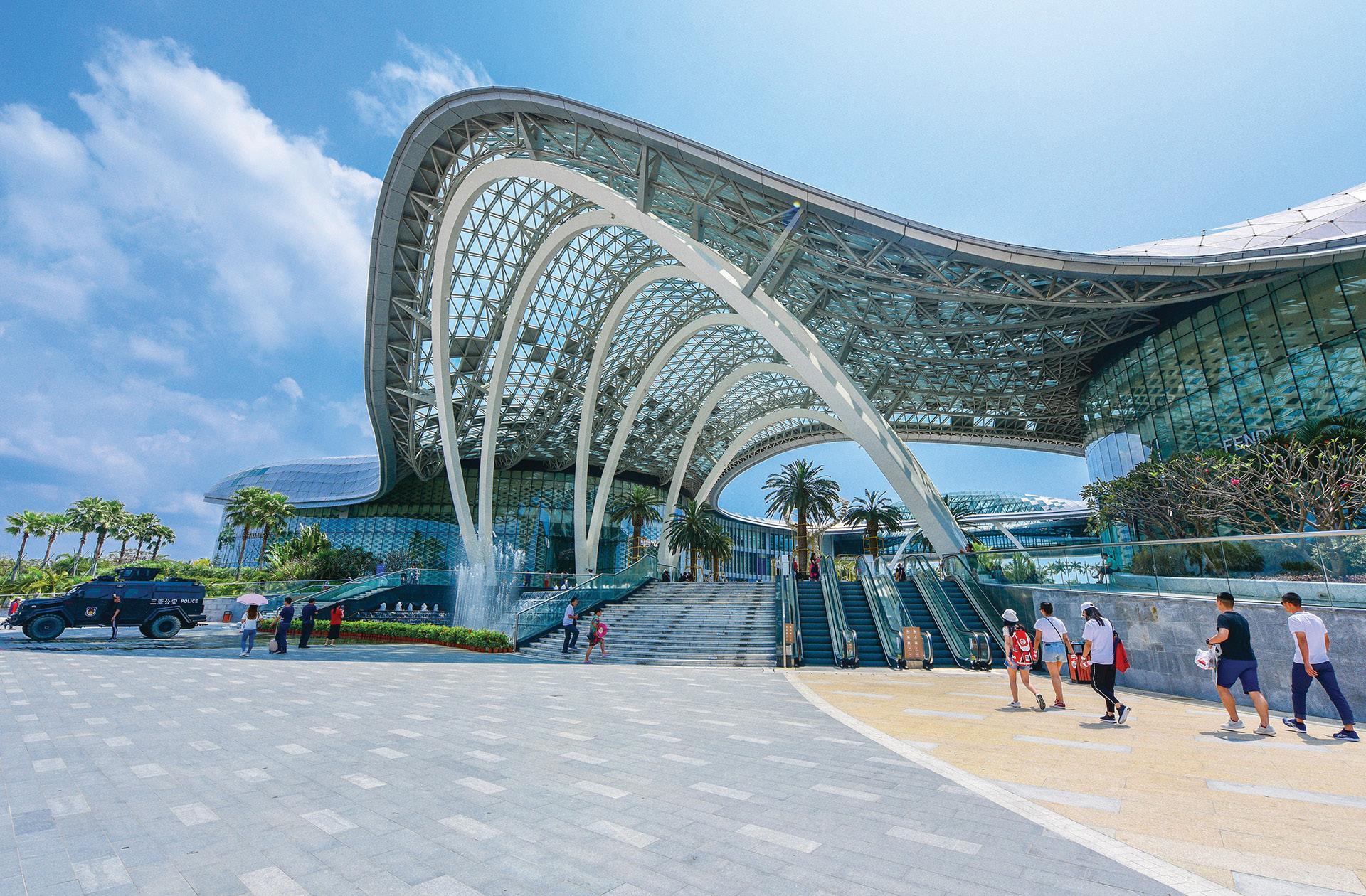
senger numbers during early 2025, with international visitors increasing nearly tenfold compared to last year.
The facility welcomed approximately 480,000 total travelers in the first quarter – more than double the previous year’s figure – and set a singleday record for international arrivals in March. These numbers represent significant progress toward pre-pandemic levels.
“Policies like the 240-hour visa-free transit have significantly boosted the appeal of cruise tourism,” says Peng Zhaoyun from Shanghai Wusongkou International Cruise Terminal Development Co., Ltd. “A spontaneous trip to China has become a real option for international travelers.”
Similar growth patterns are emerging in other coastal regions. Xiamen’s port welcomed five international cruise ships in early 2025, while Tianjin’s cruise facility is projecting substantial increases in vessel traffic during the first half of the year.
China is implementing additional policies designed to enhance the shopping experience for international visitors. The government has recently expanded its instant tax refund program nationwide, enabling overseas travelers to receive refunds at the point of purchase rather than waiting until departure. This streamlined process aims to remove friction from the shopping journey and increase spending by foreign tourists.
Simultaneously, authorities have made it easier for foreigners to navigate daily transactions within China. Foreign visitors can now conveniently link international credit cards to popular Chinese mobile payment apps like Alipay and WeChat Pay – previously a significant obstacle for tourists.
Our source also notes potential expansion beyond current duty free zones: “I also think China will convert more traditional shopping malls into tax-free retail zones in the future.”
The challenging market conditions have accelerated the adoption of new technologies across the retail sector. “Recently, more retailers and brands have started using our AI price tracking system. They’re now paying greater attention to price analysis, data collection, and leveraging AI to enhance their business operations,” the source reports.
The National Bureau of Statistics reported that foreign visitor entries to China totaled 26.94 million and revenue from international travelers reached US$94.2 billion last year, up 95.5% and 77.8% respectively from 2023. While these figures still lag pre-pandemic numbers, representing about 85% of 2019 levels for entries and 91% for revenue, they demonstrate substantial recovery potential if current policies continue to gain traction.

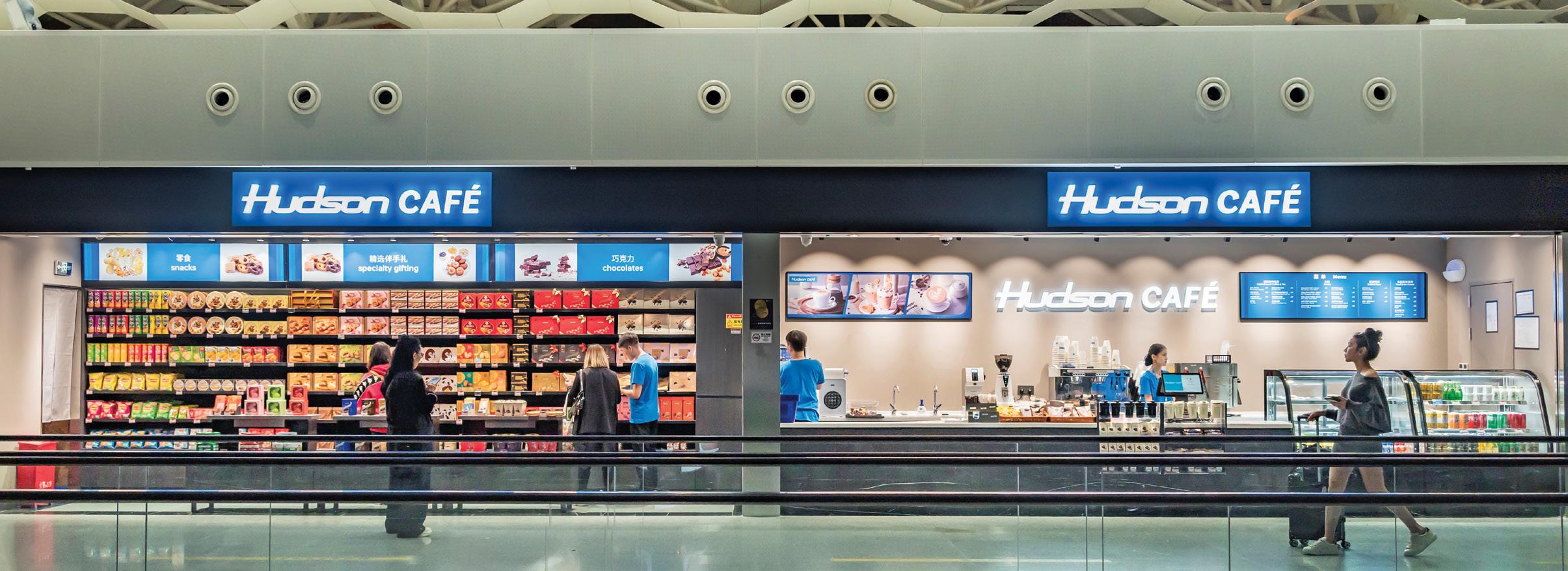
Avolta’s growth in the Asia Pacific region is rooted in a “win-win-win” strategy that creates value for airports, brands, and operators alike, according to Freda Cheung, President and CEO of Asia Pacific at Avolta. With an ever-growing presence, a powerful new loyalty engine and a traveler-centric mindset, the company is laying the groundwork for long-term growth and success in the region
by ATOOSA RYANNE ARFA
Avolta is accelerating its footprint across Asia Pacific, tapping into one of the most dynamic and complex travel retail markets in the world. Recent contract wins, strategic acquisitions and loyalty advancements showcase how the company is actively responding to the modern traveler’s changing expectations. Driving this momentum is a vision to build a future-ready retail and F&B ecosystem that delivers shared value for not only Avolta, but also airports, brands, and ultimately, travelers.
The appeal of Asia
“APAC accounts for more than 50% of the world’s population, more than 50% of the world’s global trade growth, and more than 50% of travel retail and travel F&B market share, so clearly this region has the highest growth potential,” says Cheung.
Given the immense scale, rich cultural diversity, and rapidly shifting consumer behaviors, the APAC region demands both agility and long-term vision. Strong economies and booming tourism hubs in the region drive high passenger volumes, but they also invite intense competition. That’s why Avolta embraces a demand-driven approach. “We believe in sustainable growth,” Cheung explains.
In addition to its presence in key markets such as India, Indonesia, Vietnam and Australia, Avolta recently expanded its already-existing footprint in China with significant contract wins at Shanghai Pudong International Airport and Shenzhen Bao’an International Airport. These wins bolster its presence in two of Asia’s most vital travel hubs.
At Shanghai Pudong, Avolta now operates over 2,000 square meters of

retail and F&B space, featuring notable names such as Wolfgang Puck Kitchen Counter + Bar, HEYTEA, T9 Premium TEA, and Kumo Kumo. Last November, the company secured a long-term partnership with Shenzhen Bao’an, China’s fourth-busiest airport, to add over 1,000 square meters of space, debuting China’s
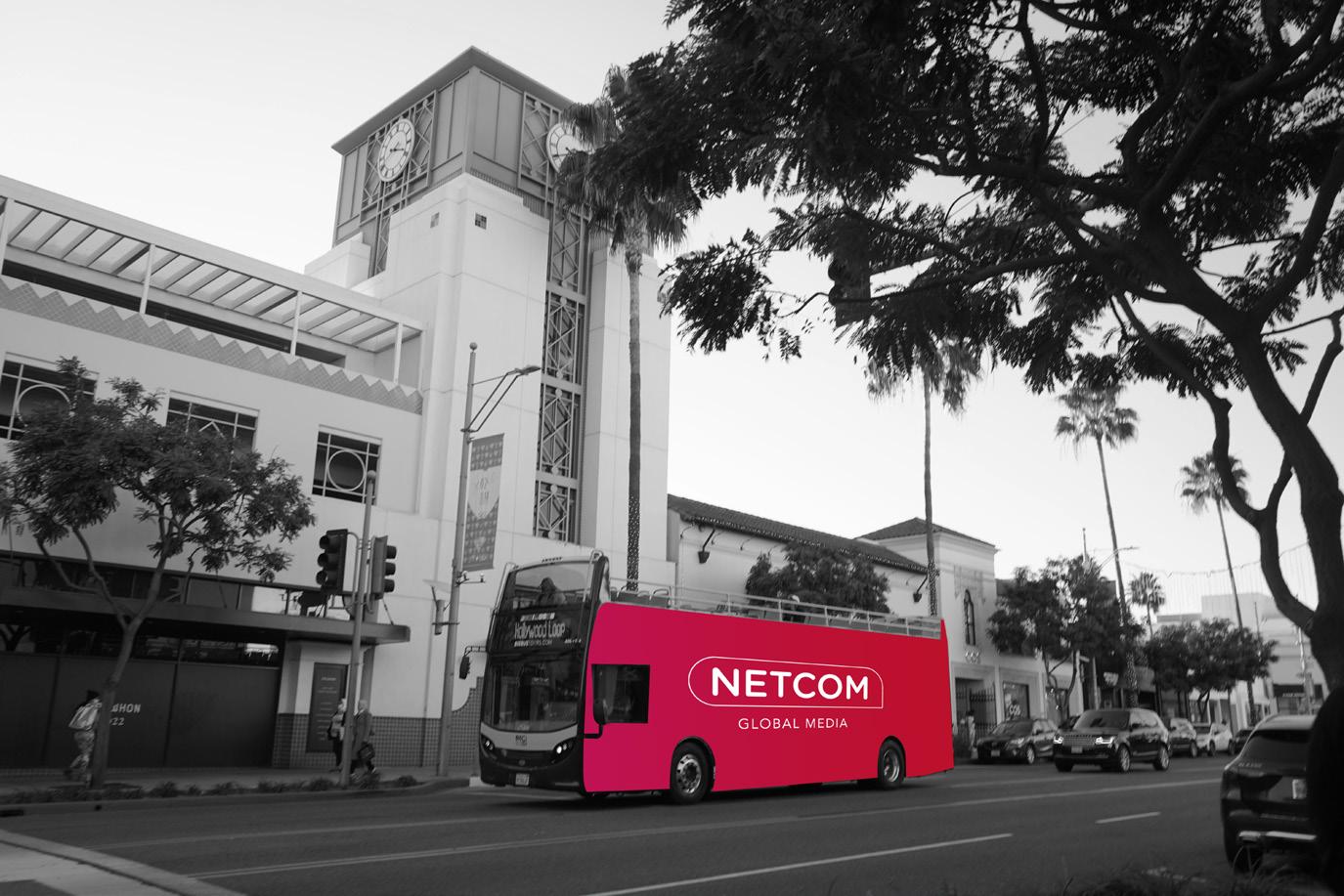
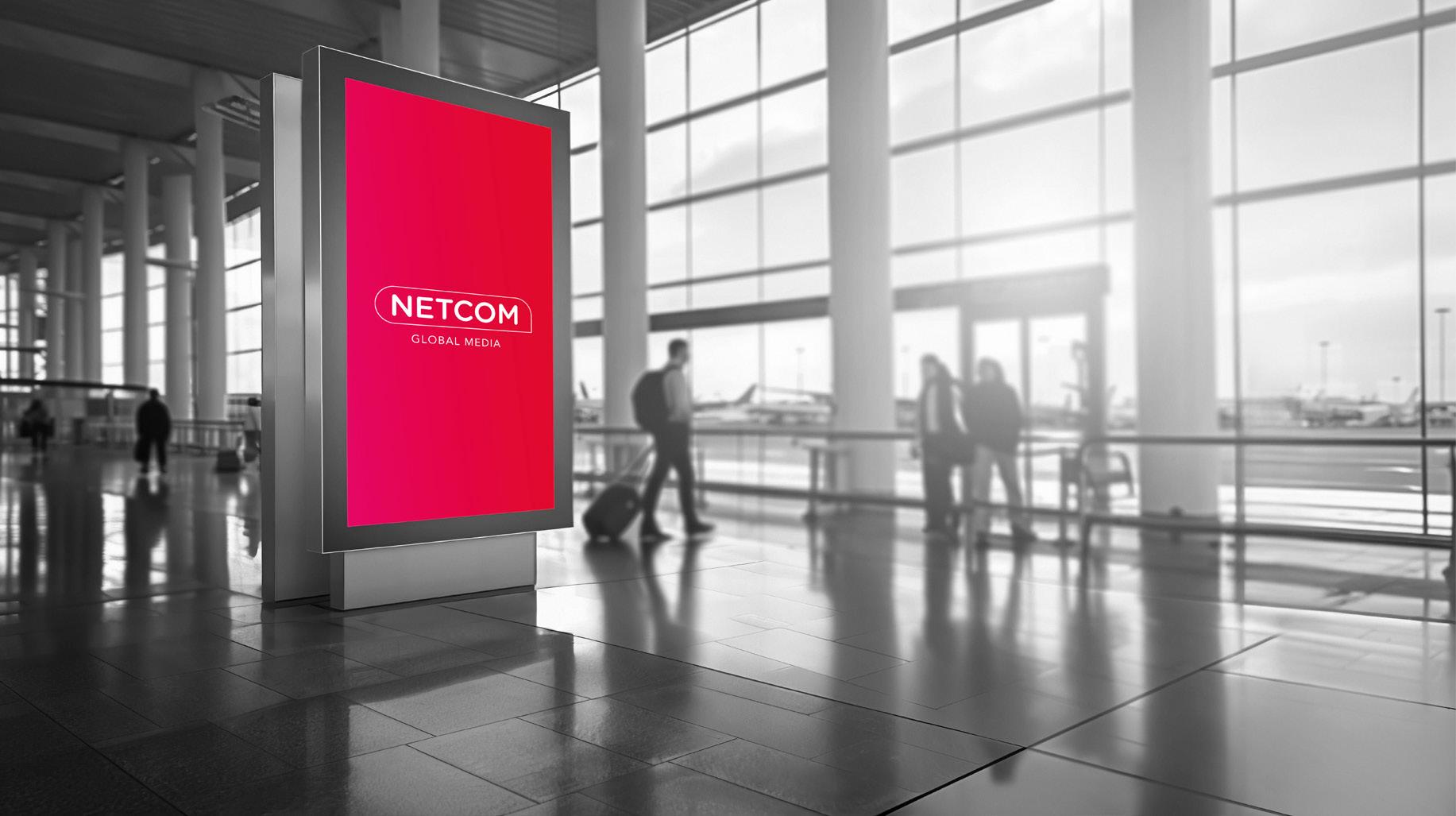
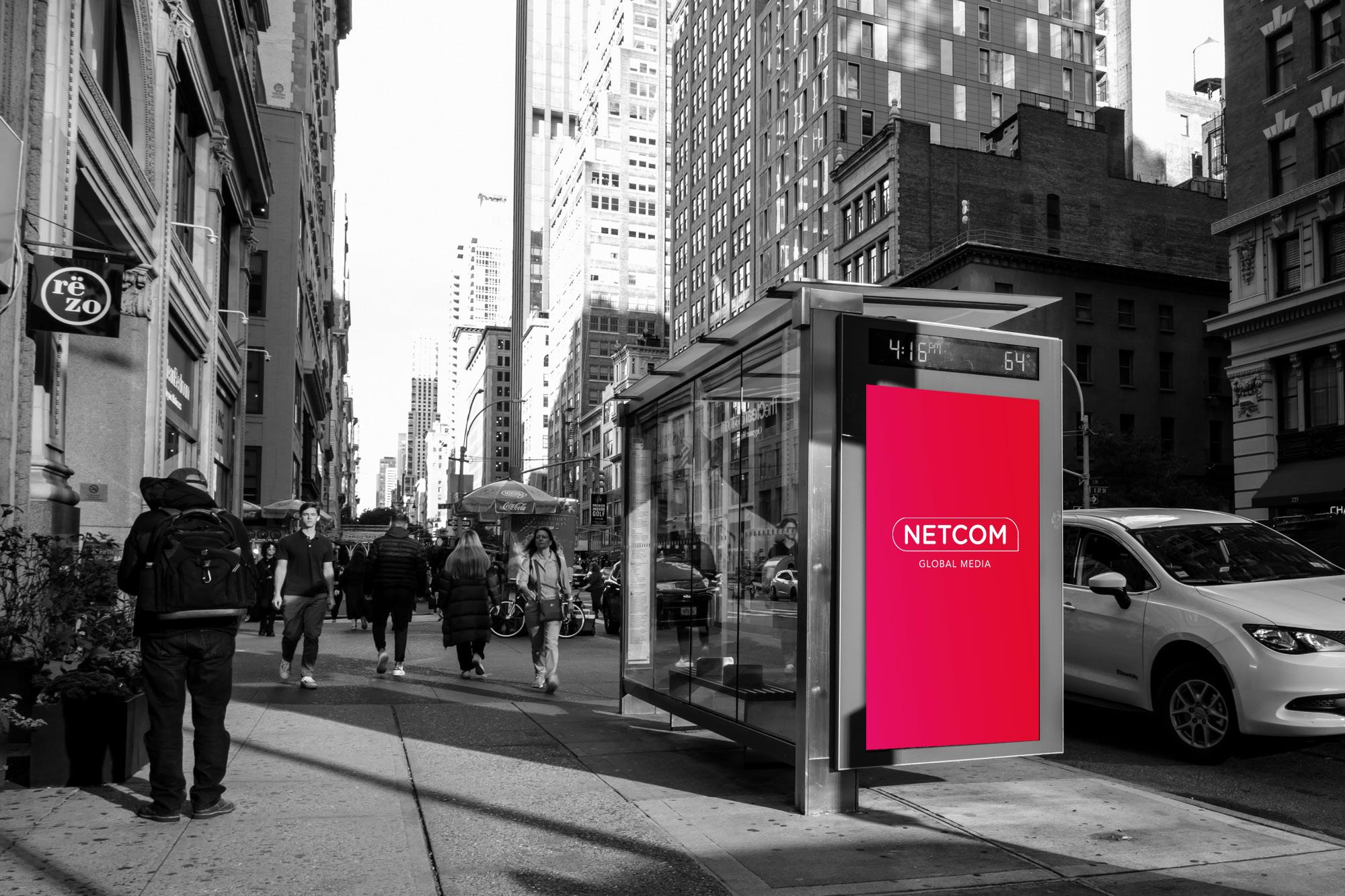
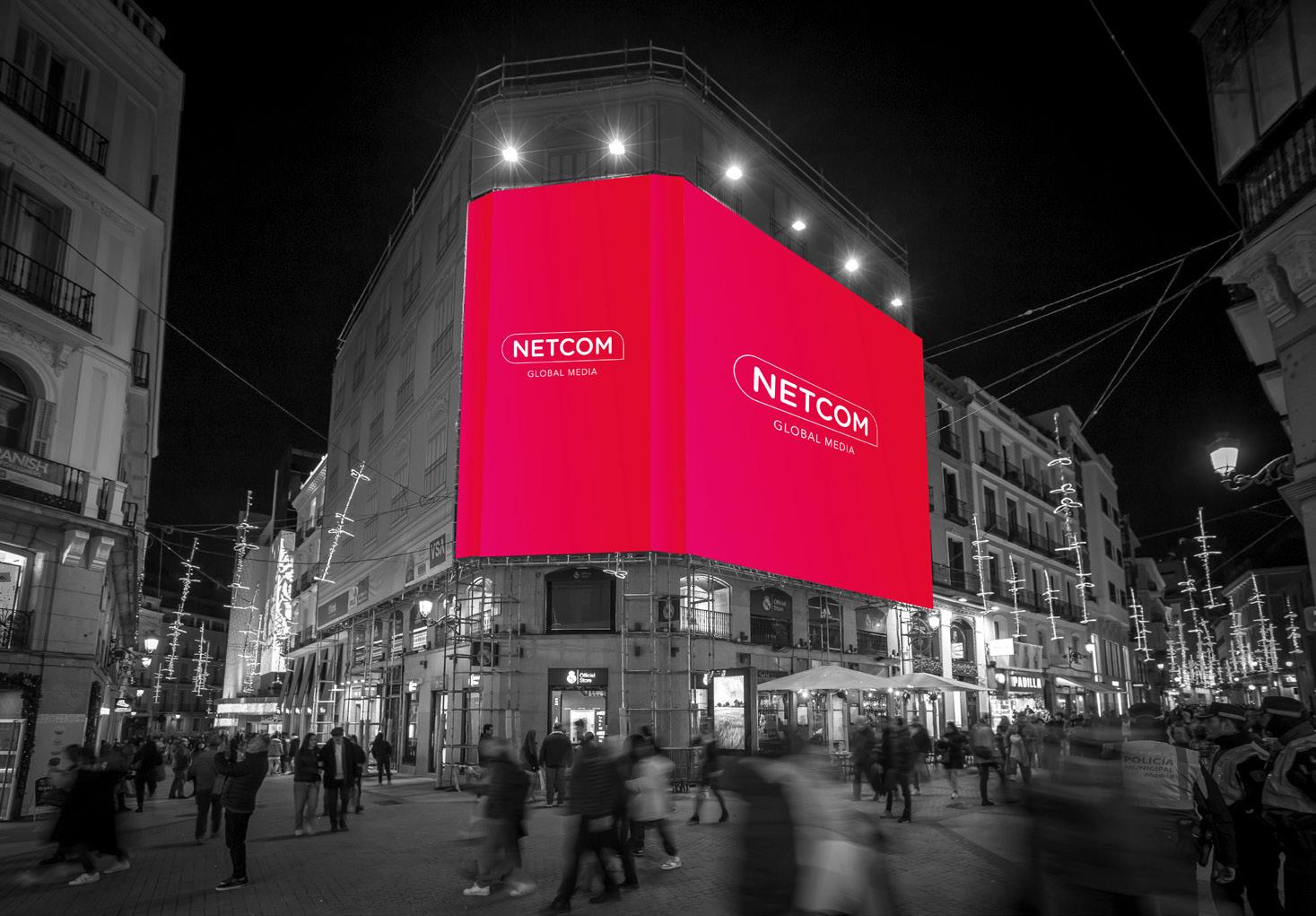

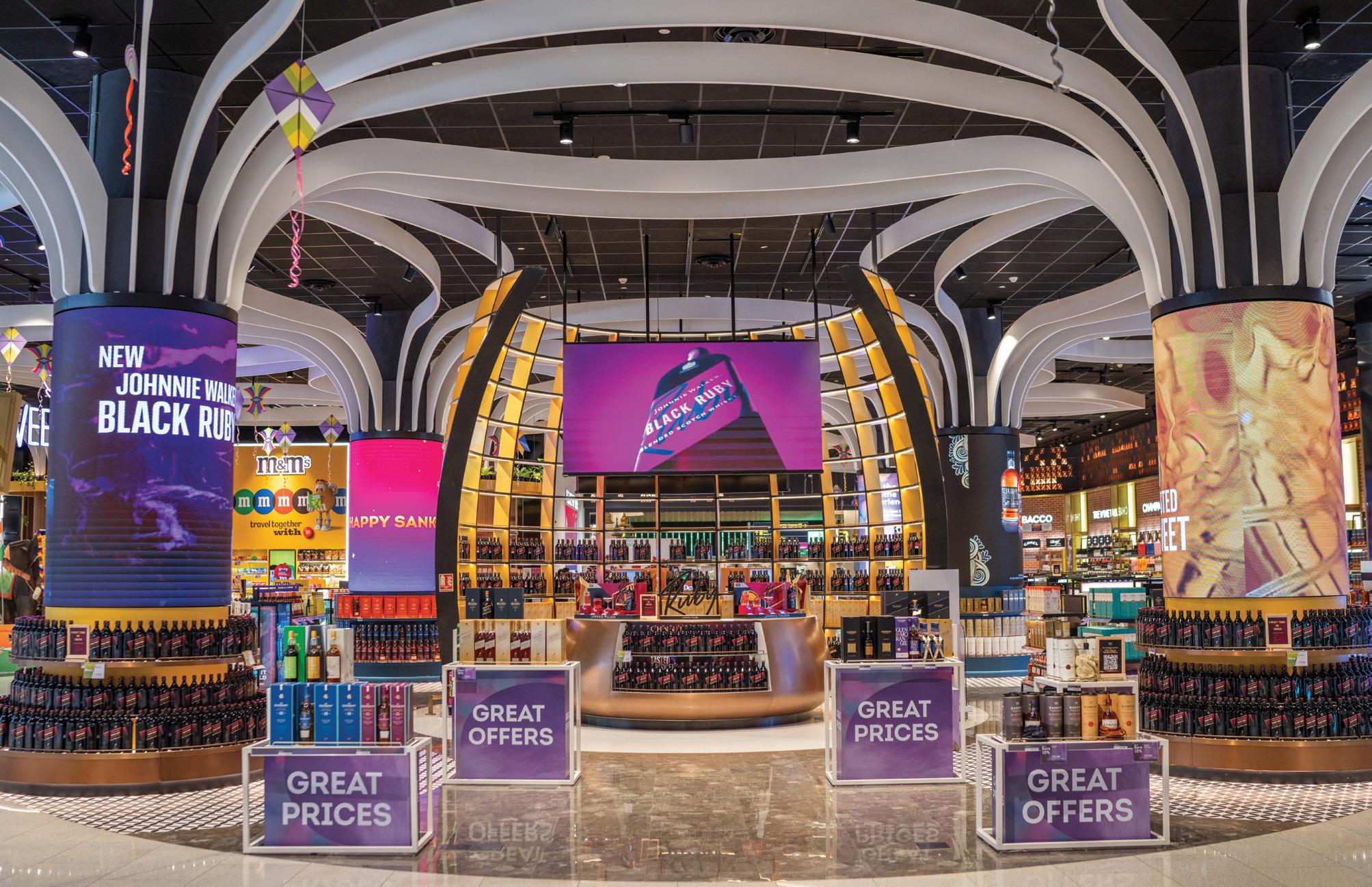
first Hudson Café hybrid concept alongside La Mian Xiao Long Bao from Michelin-starred Crystal Jade.
Further solidifying its presence in the region, Avolta recently acquired Hong Kong-based Free Duty, a leader in border retail, from NWS Holdings. This acquisition connects Avolta to over 150 million travelers across the Greater Bay Area and opens new multi-channel opportunities across air, land, and sea.
Still, the company remains focused and selective when it comes to acquisitions. “We make an acquisition only when we believe that there’s value creation,” says Cheung, emphasizing that Avolta’s growth strategy in APAC is a careful balance of natural expansion and selective partnerships that bring long-term value.
The Asia Pacific region offers some of the most dynamic and diverse travel retail opportunities in the world, and Avolta is keen to design its offerings
around these fast-evolving expectations. “APAC is a market that treasures convenience, speed, options, and control, mainly due to the fast-paced and sometimes hectic lifestyle,” says Cheung. “That’s why we prioritize technology that enables a traveler-centric journey and delivers all of the above.”
Operating across more than 70 countries, with a growing presence in key APAC markets, Avolta consistently builds around the traveler, not the transaction. “It’s at the heart of everything we do in each of our retail stores and F&B outlets,” says Cheung.
Leveraging its global scale, Avolta ensures brand consistency while still delivering hyper-local relevance. “We are committed to offering travelers whatever it is they want to buy, not what we want to sell,” she adds. This traveler-first philosophy shapes Avolta’s diverse and memorable product assortments. From duck neck in China and bear cookies in Hong Kong to artisan wellness goods in Indonesia, locally
produced whisky in India and manuka honey in Australia, Avolta delivers offerings that reflect the culture and desires of travelers in each part of the region.
Store design plays a role in enhancing the overall experience, featuring curated brand selections, immersive entertainment, competitive pricing and localized storytelling. Different markets require different strategies, according to Cheung. Mature markets demand breakthrough innovation, growth markets call for elevating offerings and standards, while infant markets present limitless opportunities to build from the ground up. “As we are the leading global travel retail and F&B player, we offer not only duty free and duty paid but also travel essentials and F&B,” states Cheung. “Therefore, we are flexible in how we match our offers to the needs of each market.”
In APAC, where travel retail often takes the spotlight over travel F&B, Avolta champions hybrid formats that merge the two together. A standout
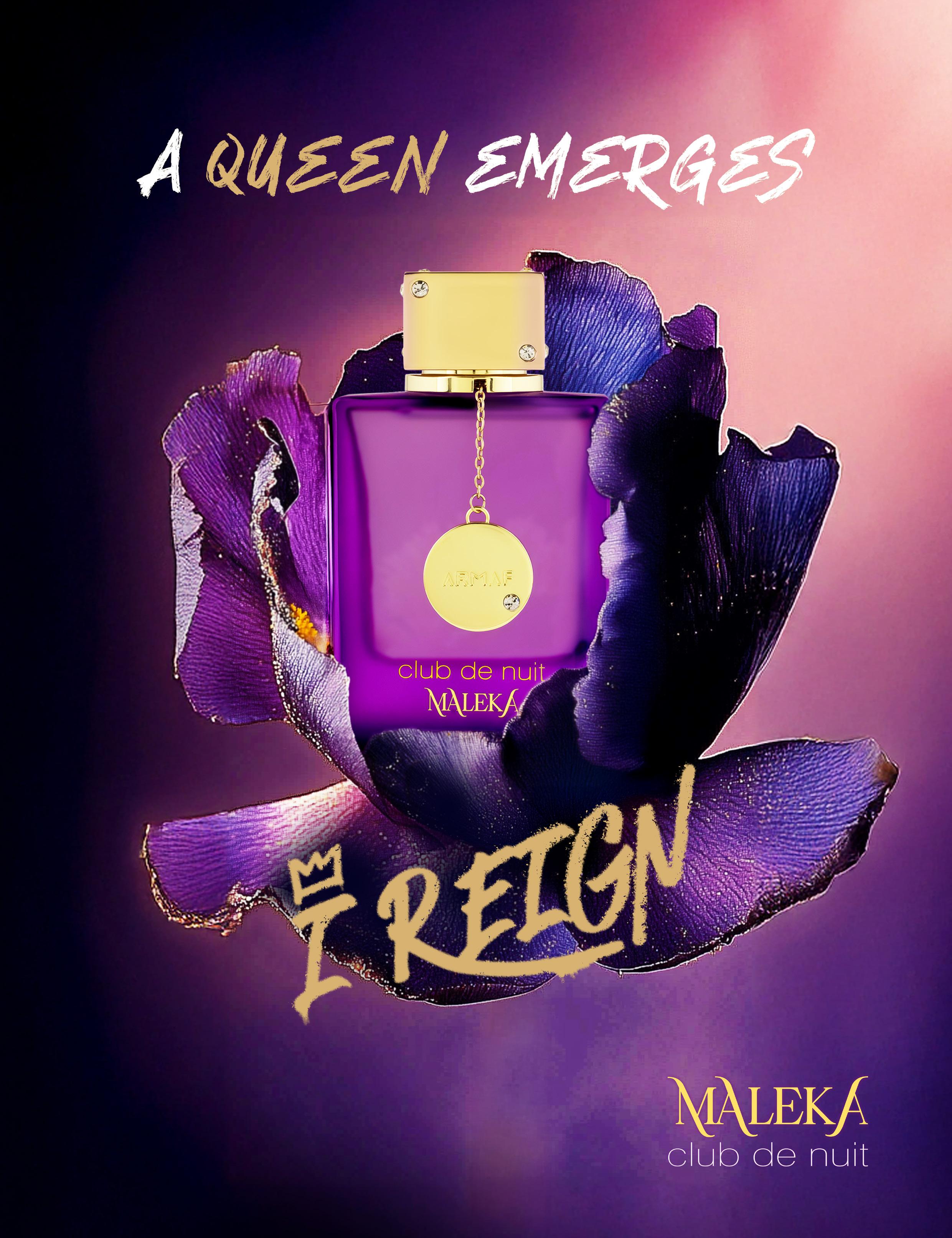
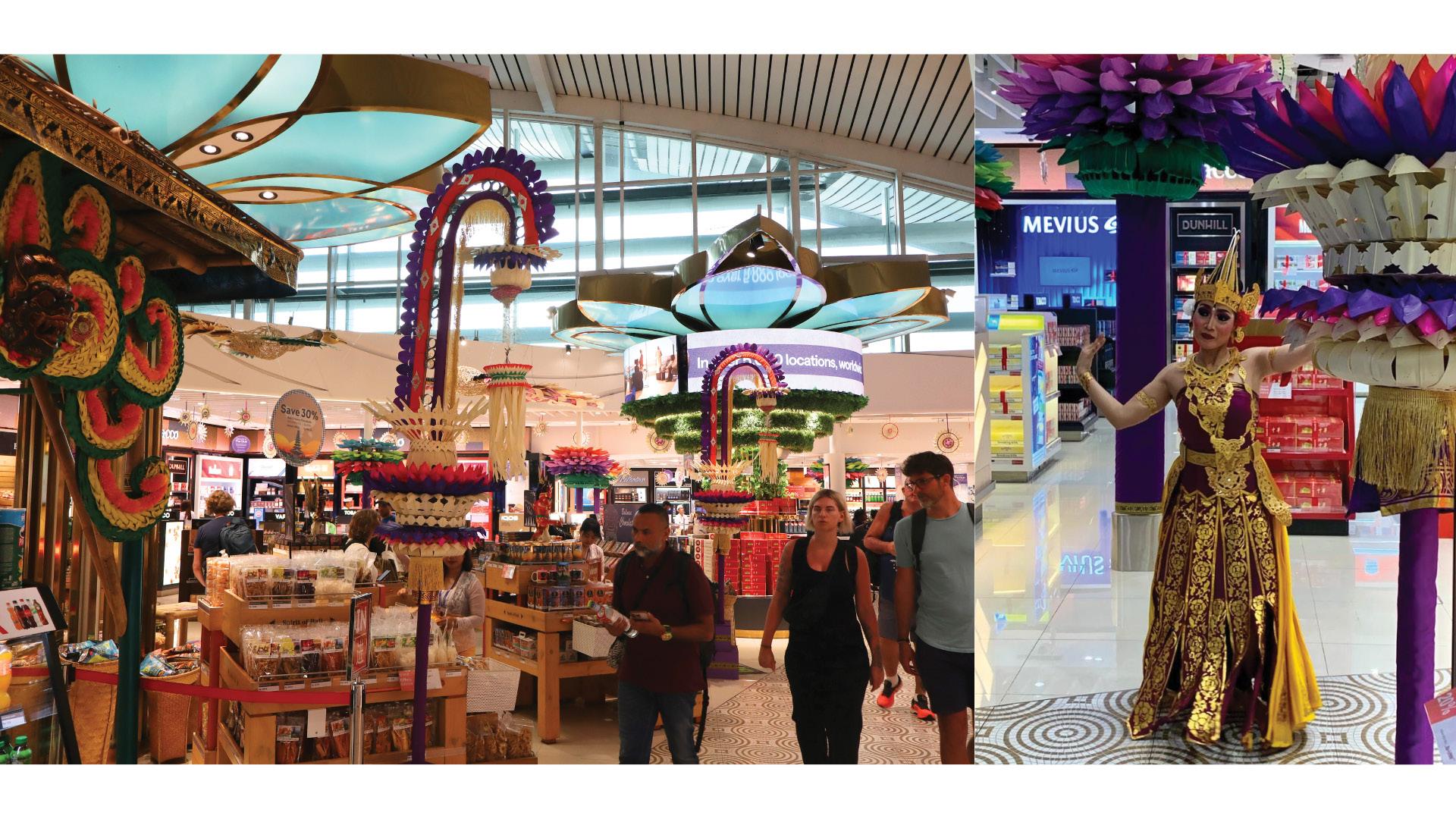
example is the debut of the first Hudson Café at Shenzhen Bao’an, combining the familiar worldwide airport convenience store concept with an innovative café bar twist. Meanwhile, the company is integrating digital touchpoints that put choice and control directly into travelers’ hands, from Reserve & Collect services to QR code menus and selforder kiosks.
Avolta’s latest technology-driven innovation, the Club Avolta loyalty program, made its debut last September at the TFWA World Exhibition and Conference in Cannes. This announcement was particularly significant for the APAC region, where the impact and importance of loyalty programs are especially pronounced.
In APAC, loyalty programs are omnipresent, spanning from luxury boutiques, convenience stores and fine dining to high-speed rail and ferries. “Loyalty programs are definitely an integral part of everyday life here,” shares Cheung. “This isn’t just because consumers want rewards, but also because they want a sense of belonging and to be part of a community with shared values
and common interests.”
At the global level, Club Avolta rewards its members wherever they shop within the company’s expansive network, which spans an impressive 5,000 points of sale across more than 70 countries. The program provides continuity, connecting travelers to a unified ecosystem no matter where their journeys lead. The company views Club Avolta as a “tool that turns a single purchase from a transaction into a habit, and from a habit into a lifestyle,” Cheung notes.
“Club Avolta has been very wellreceived in APAC,” shares Cheung with enthusiasm. “We’re excited to see how this community of like-minded travelers continues to grow.”
Overall, Avolta’s strategic expansion across APAC, from China and India to Vietnam, Indonesia and Australia, highlights its focus on cultural adaptability and operational excellence, with no signs of slowing down.
“APAC is truly an exciting region,” concludes Cheung. “The sky is the limit.”


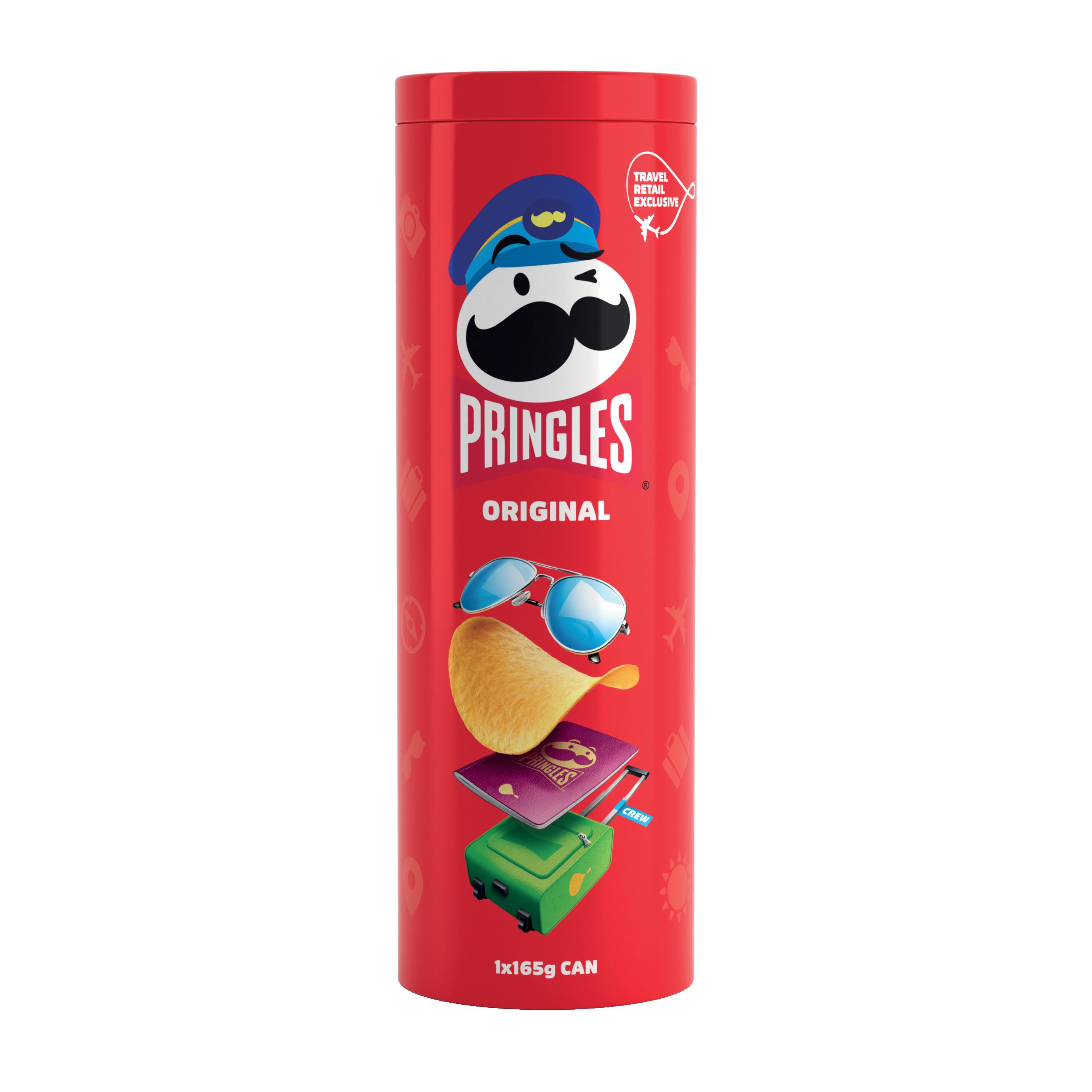

Delhi Duty Free’s focus on customer-centric offerings, digital innovation and sustainability is shaping the future of travel retail in India. Ashish Chopra, CEO of Delhi Duty Free, shares insights into the company's commitment to blend exclusivity with accessibility for its increasingly diverse customer clientele
by ATOOSA RYANNE ARFA

Aremarkable transformation is unfolding in India. The nation is rapidly emerging as a global powerhouse of innovation and luxury, propelled by an expanding middle class, an influx of international travelers and a new generation of tech-savvy consumers.
At the heart of this evolution, Delhi Duty Free is evolving to meet the changing preferences of today's travelers. Its record-breaking annual sales of ₹2,177 crores (US$261 million) for the financial year ending March 31, 2025, attest to this impact. And now the future looks even brighter, with the GMR Group poised to fully acquire Delhi Duty Free in August 2025, a move that promises to pave the way for even more opportunities for growth and innovation.
As India cements its reputation on the global stage, Delhi Duty Free is committed to advancing its offerings at Indira Gandhi International Airport.
“We’re proud to reflect India’s rise as a global leader in innovation and luxury,” says Chopra.
Delhi Duty Free strengthens its premium positioning through renowned global partnerships. In Terminal 3, it recently collaborated with Suntory Global Spirits to create a shop-in-shop concept that blends Japanese craftsmanship with modern design. Further enhancing its luxury appeal, the company launched Dior’s La Collection Privée pop-up, showcasing ultrapremium fragrances, and expanded its

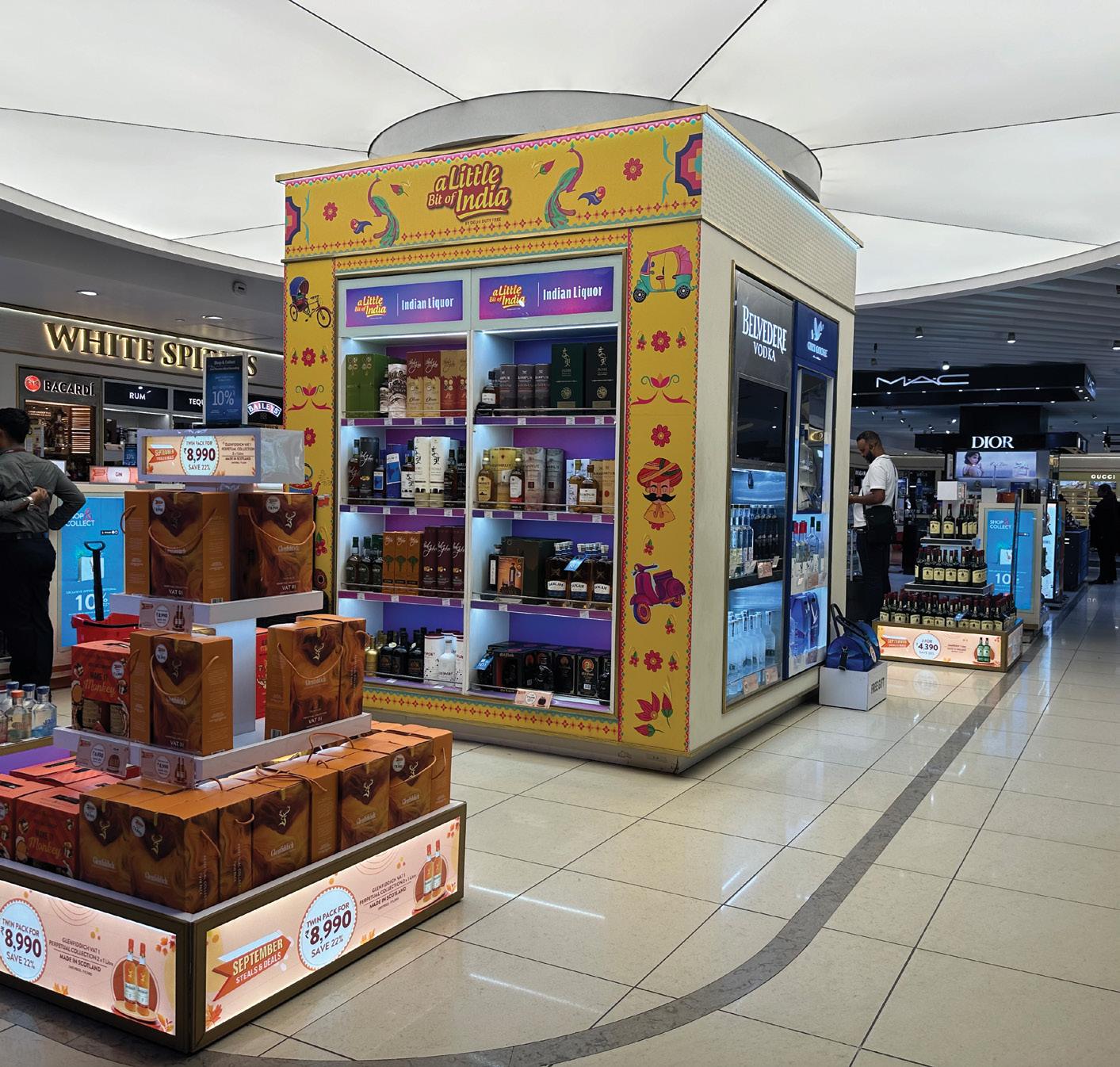
portfolio with English perfume house Penhaligon’s. It also unveiled the first Les Exclusifs de Chanel shop-in-shop located in the Indian subcontinent.
Alongside these international offerings, Delhi Duty Free highlights India’s heritage through locally sourced products. A curated selection of premium Indian whiskies, including Indri, Paul John, Rampur and Longitude 77, offers travelers a taste of the country’s artisanal excellence. “This balance ensures that international travelers have access to both the best global brands and India’s finest homegrown products, making their shopping experience more authentic and enriching,” Chopra explains.
With factors including increased discretionary spending by Indian residents and a renewed influx of international tourists, Delhi Duty Free recognizes varying tastes and needs by curating
an assortment that appeals to both value-conscious consumers and those with a taste for high-end exclusivity.
“The key is understanding our customer base and strategically segmenting our offerings,” explains Chopra. “Altogether, we focus on premiumization, exclusive collaborations, collectible items and sustainable products.”
By leveraging market intelligence, the company offers exclusive, high-value items such as the Royal Salute 25-YearOld Delhi Edition for its premium clientele, while also ensuring a varied range of more accessible options for a broader audience. This balance ensures a shopping experience that is both inclusive and aspirational.
Understanding that today’s travelers are highly connected through the power of technology, Delhi Duty Free has embraced digital innovation. “Today’s
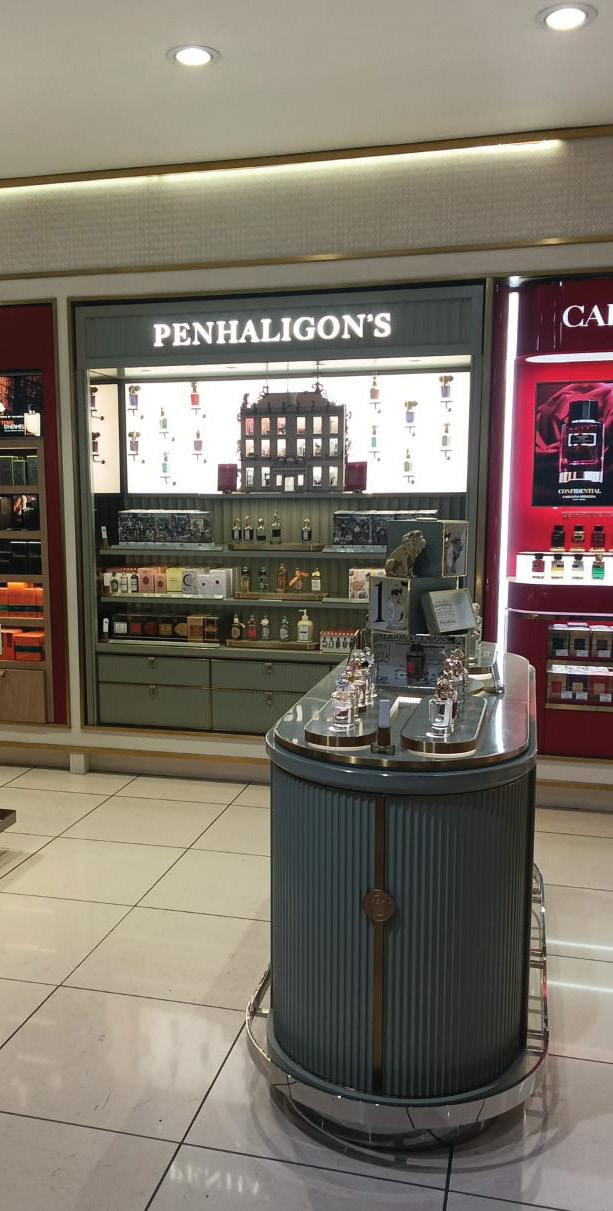
younger travelers are digitally savvy, seeking both convenience and exclusivity,” notes Chopra.
With this in mind, the company has introduced an advanced CMS platform that allows customers to effortlessly browse and reserve products even before they set foot in the airport. Once inside the store, travelers are greeted by interactive displays and dynamic video walls that create an immersive and captivating shopping environment. To keep things fresh and exciting, Delhi Duty Free frequently introduces exclusive digital product promotions and limited edition collaborations, catering to the demand for unique, standout offerings that create lasting memories.
Chopra proudly highlights the company’s early adoption of paper bags and its ongoing pilot of biodegradable, nonplastic alternatives. Additionally, Indira

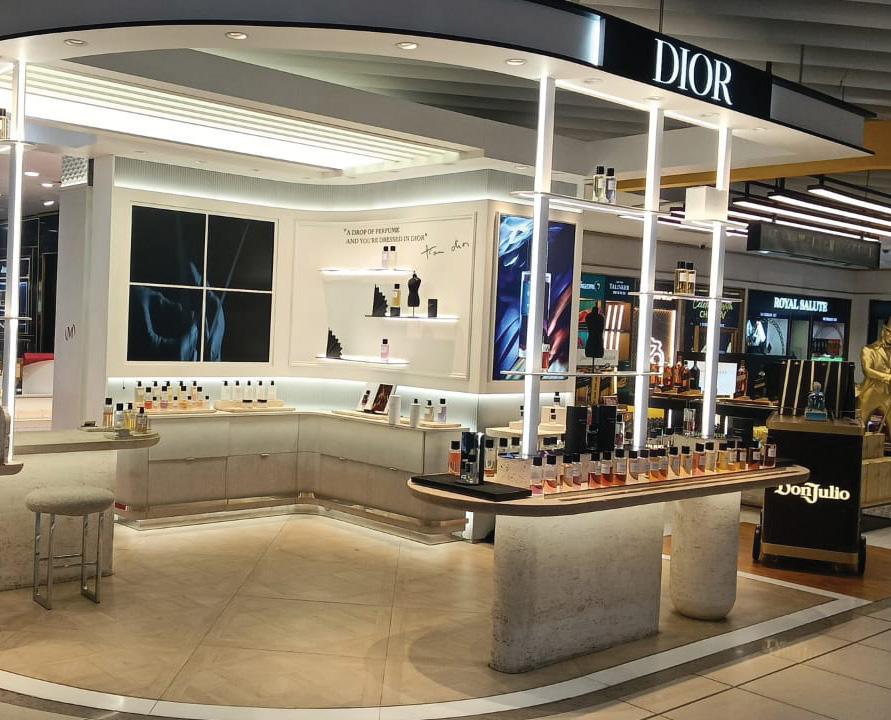
Gandhi International Airport, home to Delhi Duty Free, continues to lead by example in environmental stewardship as a single-use plastic-free airport.
Expanding its sustainability efforts, Delhi Duty Free has transitioned to 100% LED lighting across its retail locations and offices to further reduce its carbon footprint. It also champions green commuting by encouraging metro rail travel and offering shuttle services to connect employees to the workplace. “These efforts ensure that sustainability remains at the forefront of our operations, while offering eco-conscious shopping options for travelers,” notes Chopra.
Looking ahead, Chopra exudes confidence in Delhi Duty Free’s leadership in India’s travel retail sector. The essence of the strategy remains to create an experience that is as aspirational as it is accessible, ensuring that Delhi Duty Free continues to captivate a diverse global audience.
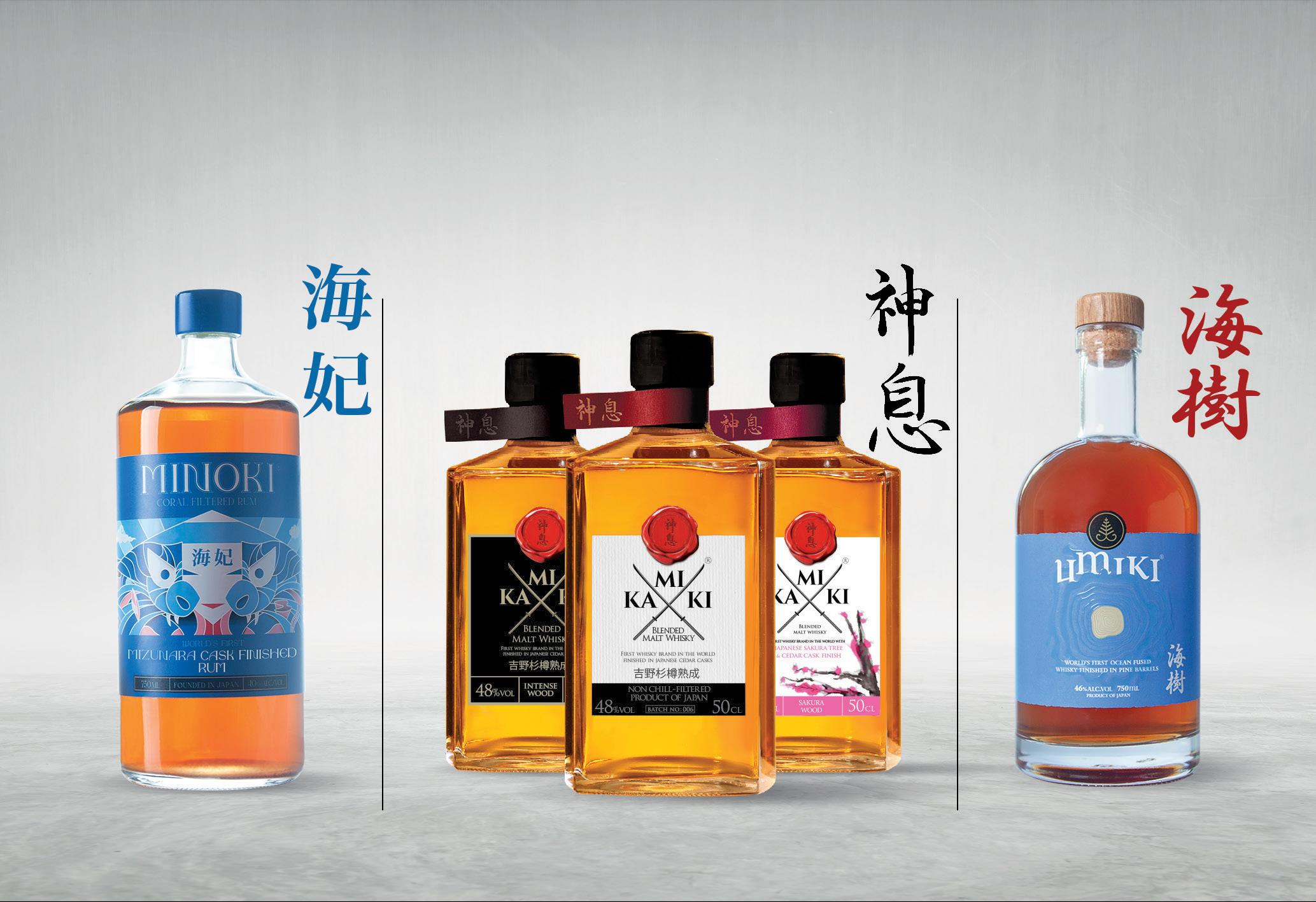
art of serıes “kı” the crafted by japan’s nature
Wangfujing International Duty Free Port in Wanning saw a 63% sales increase and a 77% rise in foot traffic, establishing itself as a premier duty free and premium outlet destination
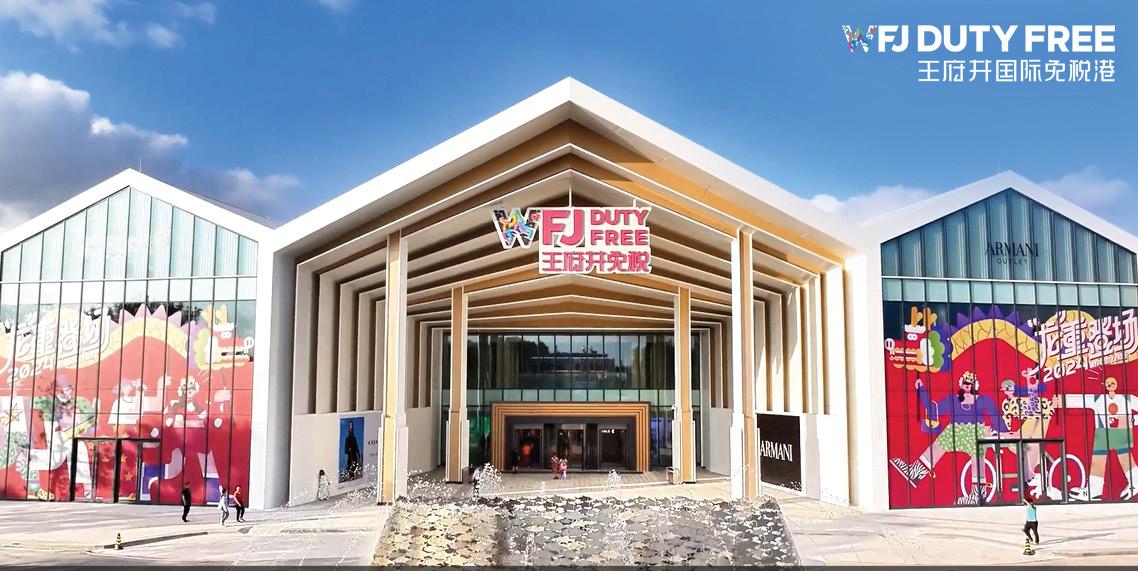
Wangfujing Group is redefining China’s tourism and retail landscape with its “Beyond Duty Free” philosophy. This innovative, multi-format approach blends the company’s rich heritage in taxable retail with an expansion into the offshore duty free market
by ATOOSA RYANNE ARFA
In June 2020, Wangfujing Group made history by becoming the first Chinese department store chain to secure a duty free goods operation license. This achievement set the stage for a core business model that leverages the company’s established success in taxable retail with a rapidly expanding duty free enterprise.
A dual-engine strategy
At the heart of this evolution is Wangfujing’s dual-engine strategy, which integrates both tax-paid and tax-free operations with the explicit goal of transforming China’s retail and tourism sectors. The company blends two
distinct but complementary business models into one cohesive vision, driving both innovation and growth.
“We adhere to the philosophy of ‘Beyond Duty Free,’” shares the public relations spokesperson for Wangfujing Duty Free. “By aligning strategies and clarifying priorities, we aim to establish a multi-format, multi-polar duty free ecosystem, driving rapid expansion and implementation of duty free projects.” Through this approach, Wangfujing not only strengthens its traditional retail roots but also positions itself to respond swiftly to shifting market conditions and evolving consumer preferences.
Offshore innovations
The 2023 debut of the Wangfujing International Duty Free Port, which is positioned as both a duty free and premium outlet destination, signaled the early success of this strategy, which has already delivered outstanding results. The location reported a 63% year-on-year increase in total sales as of January 2025, along with a 77% surge in customer footfall. These impressive figures showcase the power of the dualengine strategy and demonstrate how effectively it drives substantial growth.
Located in Wanning City near popular surfing resorts such as Riyue Bay and Shimei Bay, the 170,000-square-meter Wangfujing International Duty Free Port offers nearly 800 international and domestic brands across nine product categories, including luxury goods, sports gear and fragrances.
But this Hainan destination goes beyond traditional retail. It is also designed to provide experiential attractions that cater to travelers seeking
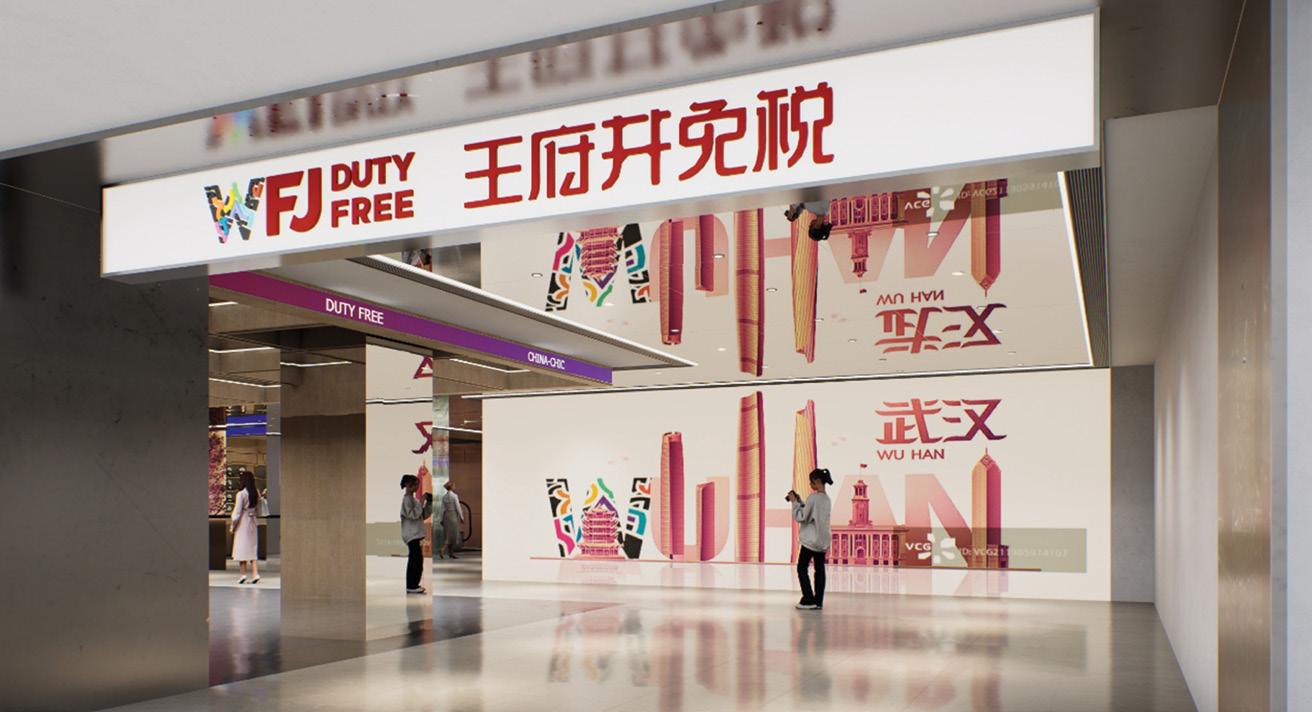
active lifestyle experiences. Notable highlights include a competition-grade skatepark and Hainan’s first dedicated duty free sports section for surf and skate enthusiasts, making it the island’s largest sports hub.
In addition, Wangfujing has partnered with prestigious brands such as MAX MARA and Penfolds to offer customers an elevated shopping experience, while a drive-in cinema adds an element of entertainment that further enhances the destination’s appeal.
Wangfujing Group has also expanded its retail footprint at major Chinese travel hubs in Heilongjiang Province’s key cities. In August 2024, the company secured agreements to operate departure duty free stores at Harbin Taiping International Airport and Mudanjiang Hailang International Airport. These stores represent the company’s ability to create retail environments that enhance the transit experience of departing passengers, offering a wide range of products from fragrances and cosmetics to wines and luggage.
These airport duty free spaces also ensure that travelers not only shop, but also engage with the region’s cultural identity, creating a unique sense of place. In Harbin, for example, where operations began in January 2025, Wangfujing has developed a space that reflects the city’s iconic cold-climate
heritage, highlighted by its renowned Harbin Ice Festival. “The designs blend Harbin’s urban identity and ice-snow culture with airport layouts, creating functional, locally themed shopping spaces,” states Wangfujing Duty Free’s spokesperson.
Urban retail
In addition to its successes in offshore and airport locations, Wangfujing Group is redefining urban retail by introducing easily accessible duty free spaces in major cities, blending modern shopping with local cultural heritage.
One standout project is located in the bustling Wushang Mall in Wuhan, where Wangfujing Duty Free obtained operational rights in December 2024. Developed in collaboration with Wushang Group, this urban duty free space integrates iconic architectural elements such as the Yellow Crane Tower and the Yangtze River Bridge, merging traditional Chinese symbolism with ontrend retail offerings.
Similarly, another innovative Wangfujing Duty Free project that began operations in January 2025 is located within the flagship Wangfujing Department Store in Changsha. This space combines cultural emblems such as Yuelu Academy, a historic learning center dating back to the Song Dynasty, with Xiang embroidery, a traditional craft known for its intricate and colorful designs.

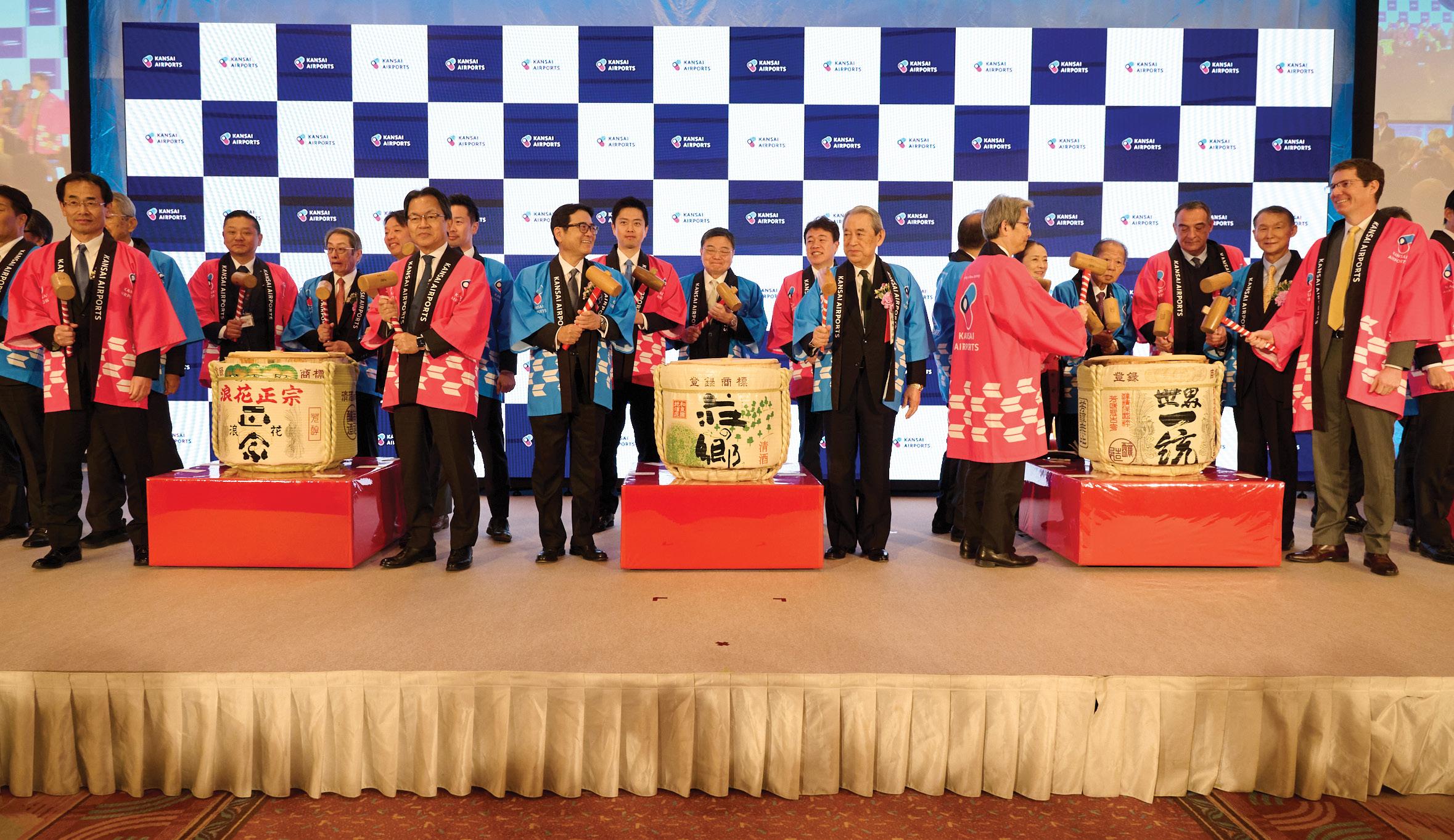
Kansai International Airport (KIX) has unveiled a major Terminal 1 renovation ahead of the Osaka-Kansai 2025 Expo, enhancing capacity, efficiency and the passenger experience. As the gateway to this global event, KIX is preparing to welcome millions of visitors with upgrades that reflect a commitment to innovation, comfort and operational excellence
by ATOOSA RYANNE ARFA

Kansai International Airport (KIX), the gateway to western Japan, marks a major milestone with the unveiling of its most significant renovation since 1994, in time for the Osaka-Kansai 2025 Expo. This upgrade enhances passenger flow, modernizes retail offerings and delivers an elevated travel experience that combines advanced technology with refined Japanese aesthetics.
Landmark renovation
On March 27, 2025, KIX reached a historic juncture in its multi-phase renovation that began in 2022. Terminal 1 reimagines the space to support a growing international traveler base,
featuring innovations such as a consolidated international security checkpoint, eGate immigration control, expanded duty free zones and a spacious airline common lounge.
The reception on March 15, 2025, celebrated both the revamped Terminal 1 and the airport’s 30th anniversary. Attended by 450 guests, including government dignitaries, airline executives and industry stakeholders, the event highlighted the support from Kansai Airports’ shareholders, VINCI Airports and ORIX, which together are driving initiatives that enhance connectivity, promote sustainable growth and boost the Kansai region’s appeal.
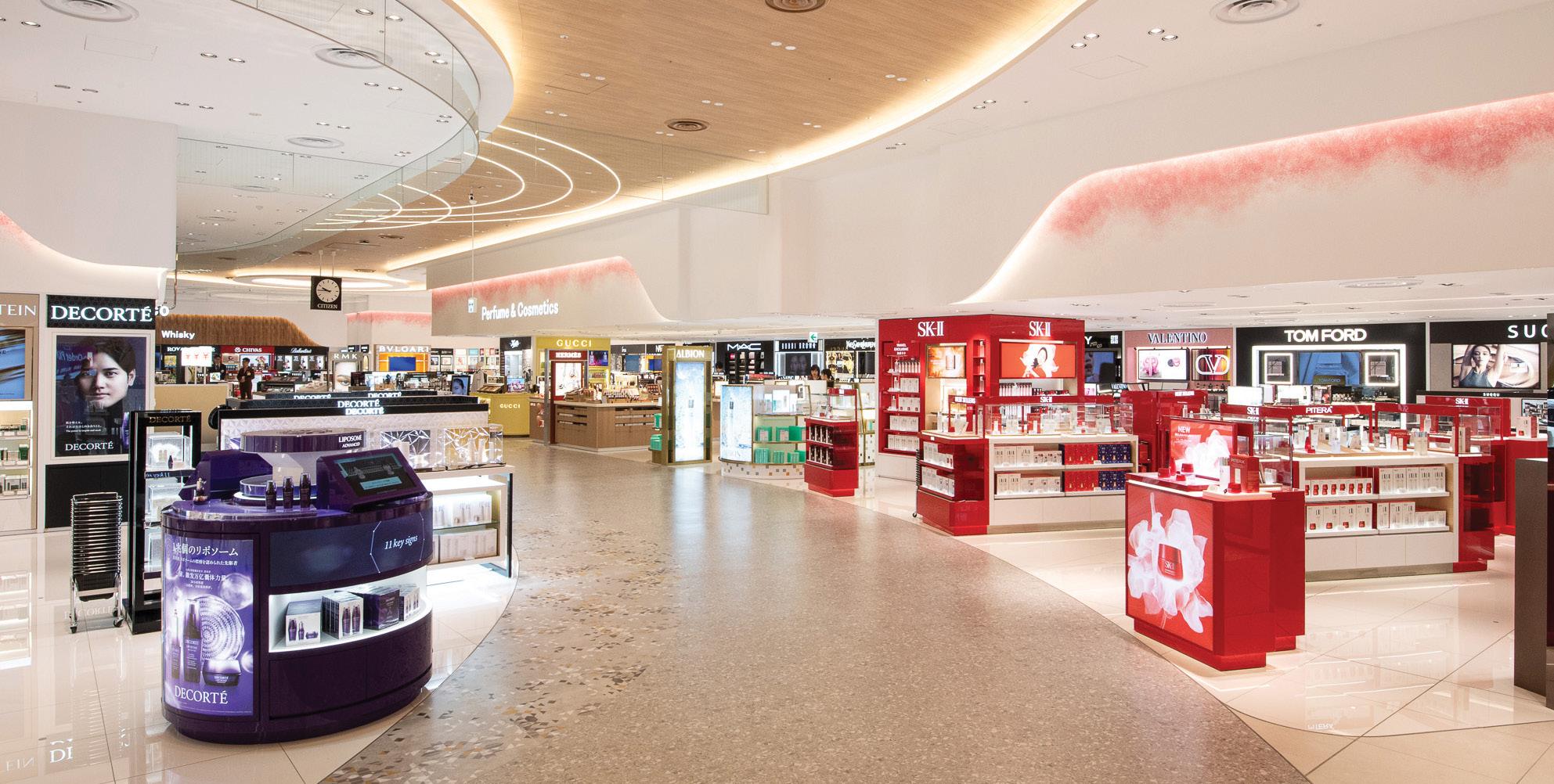

KIX serves a diverse mix of passengers, with major nationalities including Japanese (21%), Chinese (20%), Korean (19%) and Taiwanese (11%) in 2024. Since 2015, the airport has seen a significant shift in passenger demographics. Originally designed for a 50/50 split between domestic and international travelers, the terminal saw international traffic share surge to 78% by 2018.
Fumio Owada, Chief Commercial Officer of Non-Aero at Kansai Airports, explains the need for Terminal 1’s reno-
vation, “In 2018, international passengers reached 21 million, far exceeding the 12 million originally planned and leading to severe congestion.”
The new terminal incorporates technological upgrades to streamline passenger flow. Features like smart security lanes, self-check-in kiosks and automated bag drop stations make travelers’ journeys smoother. Expanded security checkpoints ensure 90% of travelers pass through security in under ten minutes. Additionally, Japan’s largest walkthrough duty free store and expanded dining
options offer a shopping and culinary experience that blends local and global influences.
In 2024, KIX served over 30.6 million passengers. With expanded capacity to handle 40 million international passengers annually, the airport is poised to welcome more visitors during the Osaka-Kansai 2025 Expo.
The renovation of Terminal 1 has been carried out in four stages. The first, completed in 2022, expanded and updated
The newly expanded airline common lounge accommodates over 1,000 passengers, offering a more comfortable and spacious experience
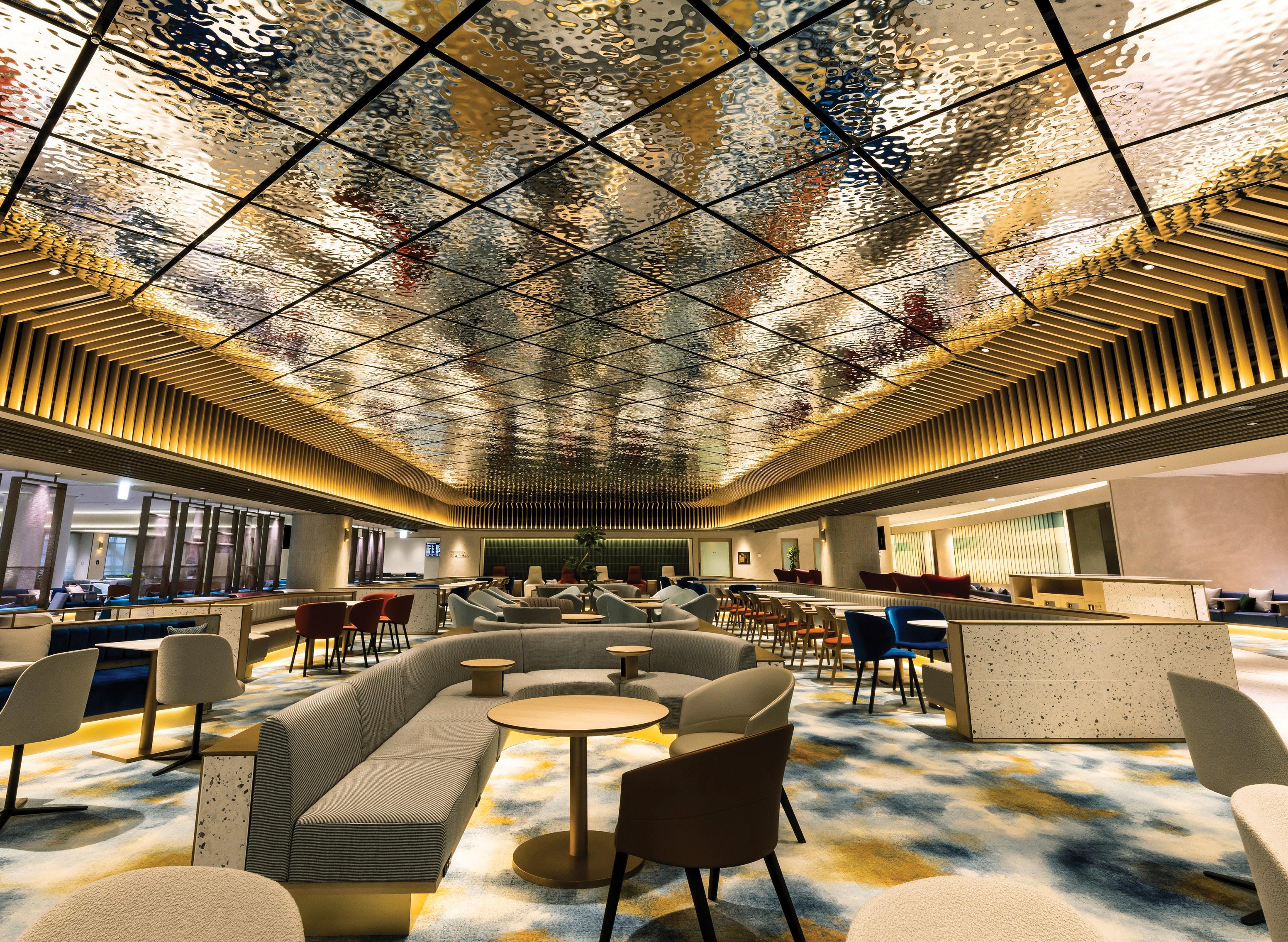
the domestic terminal. In 2023, the second stage moved the international area and redesigned shopping and dining on the second floor. The third stage, recently completed, created a larger security area, improved lounges and refreshed shopping on the fourth floor. The final phase, due by summer 2026, will add 20 new stores, including luxury boutiques and a larger food offering.
for every mood
KIX has transformed transit time into a memorable journey with its innovative “Mood Areas.” Reflecting on the transformation so far, Owada’s greatest pride revolves around this innovative space as he explains that “passengers are invited to spend time in the new area
according to their mood.” These themed zones offer personalized experiences for travelers seeking vibrant energy, cultural discovery, functional ease or tranquil relaxation.
The retail redesign blends commerce with culture and leisure, integrating traditional Japanese aesthetics through natural wood finishes and signature colors. Recent retail additions include Gacha Matsuri, a capsule toy shop featuring Japan’s beloved gachapon collectibles. New duty free arrival shops offer a wide variety of tobacco, liquor and confectionery, attracting mainly Chinese and Japanese travelers.
Innovation and sustainability Sustainability drives KIX’s transfor-
mation. The renovation incorporates numerous green initiatives designed to drive the airport toward net-zero emissions by 2050. By optimizing energy efficiency, deploying electric and fuel-cell vehicles and utilizing seaweed beds as CO₂ absorbers, KIX has attained Level 4 Airport Carbon Accreditation. It also boasts the largest solar power generation capacity among Japanese airports. The transformation at KIX remains far from over. While the Terminal 1 renovation marks the airport’s most significant upgrade to date, discussions are currently underway regarding the reorganization of Terminal 2, the airport’s low-cost carrier (LCC) terminal.
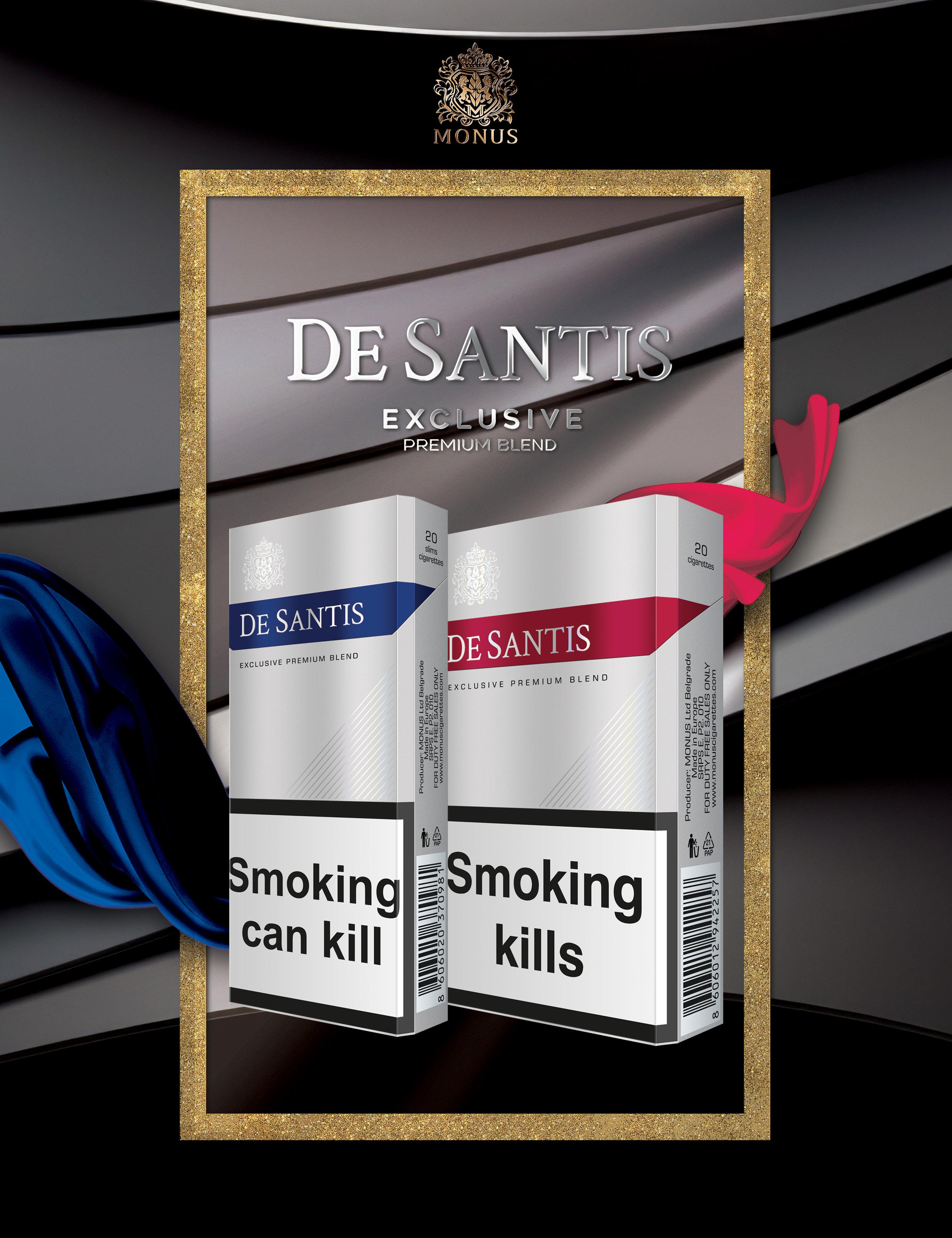

With the opening of Noida International Airport scheduled for spring, Global Travel Retail Magazine speaks to CEO Christoph Schnellmann. He discusses the emergence of India as an aviation hub, as well as the prioritization of increased connectivity in the region

Hby LAURA SHIRK
aving started construction in June 2022, Noida International Airport (NIA) is making steady progress toward operational readiness. Located in the Indian town of Jewar, Greater Noida, Uttar Pradesh, NIA is on track to become a major center of aviation in the National Capital Region (NCR).
According to Christoph Schnellmann, Chief Executive Officer at Noida International Airport, the next major milestone is the granting of its aerodrome license, which is expected to take place in May.
“The Airports Authority of India is advancing its work in the air traffic control tower, while construction of the passenger terminal and associated infrastructure is progressing well. The airport will begin operations with domestic flights, with international routes to follow in the subsequent months,” says Schnellmann. “Discussions are ongoing with the state and central government regarding the start of commercial operations.”
Noida International Airport is being built by Yamuna International Airport Private Limited – a fully-owned subsid-

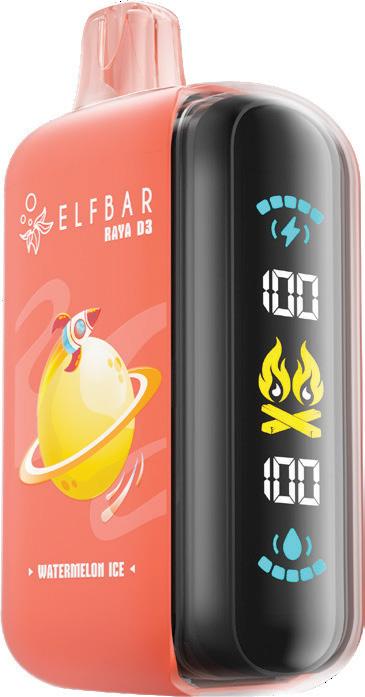




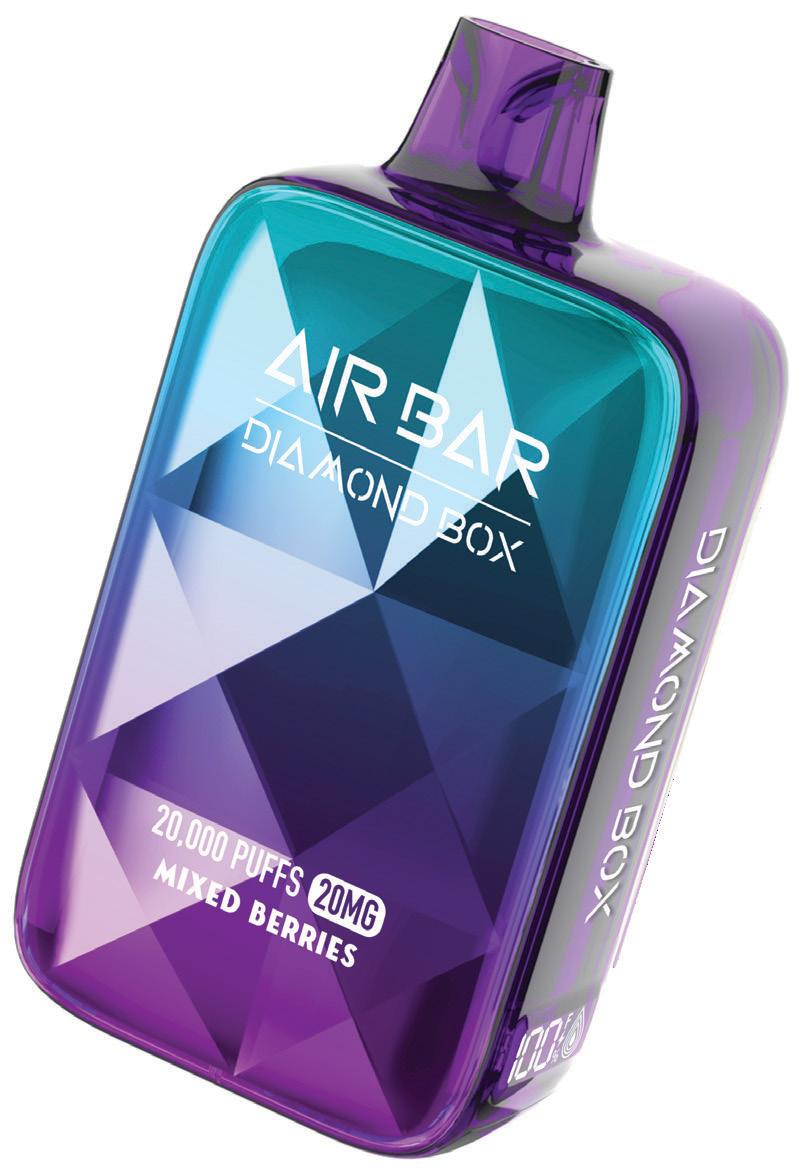


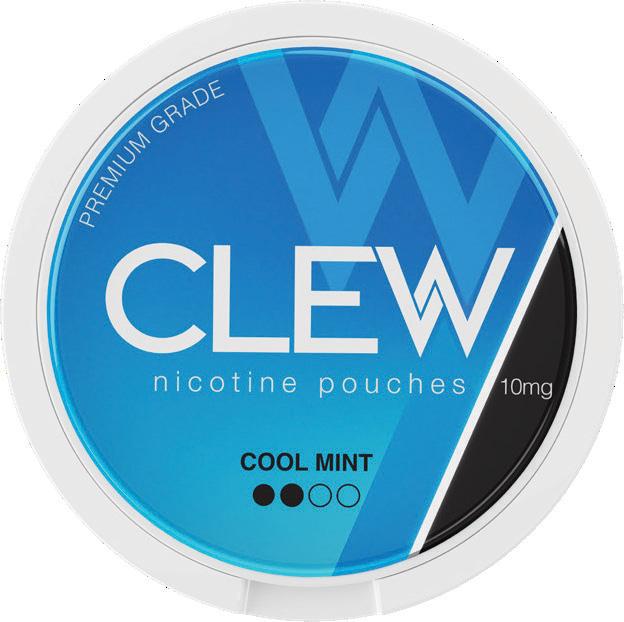



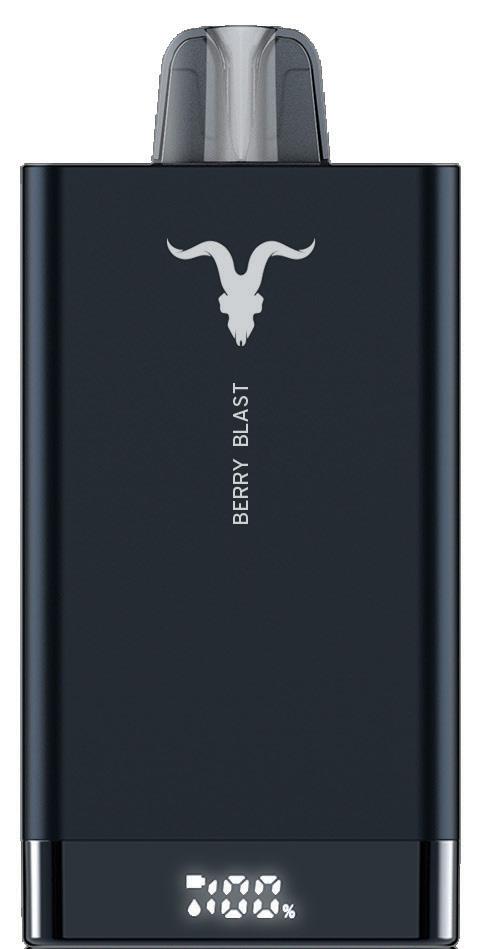






iary of Zurich International Airport AG. At the time of opening, it will have one runway and a terminal building.
Expected to ease congestion at Delhi’s Indira Gandhi International Airport, NIA is set to handle up to 12 million passengers annually. Speaking about India’s emergence as an aviation hub and how increased connectivity (both air and road) serves as a priority, Schnellmann explains, “The aviation sector in India is witnessing remarkable growth, highlighted by the substantial aircraft orders placed by major carriers like IndiGo and Air India. This surge in demand underscores the urgent need to expand airport infrastructure to accommodate increasing air traffic.
“In particular, the Delhi-NCR region requires additional capacity to handle the rising demand for air travel. Noida
International Airport is poised to play a vital role in addressing these concerns. By developing world-class commercial real estate, NIA will not only support the expansion of the aviation sector but also contribute to the economic growth of the region.”
According to Schnellmann, by prioritizing enhanced activity, NIA will serve as a catalyst for economic growth, a driver of tourism and a gateway to opportunity for the people of Uttar Pradesh and beyond. He adds, “We are committed to working with all stakeholders to realize this vision and make NIA a world-class airport that meets global standards in safety, efficiency and passenger service.”
In March, the Yamuna Authority passed a proposal related to the connectivity of NIA. It was determined that 250 buses will run from the airport to 26 districts and several other states. Plus,



a high-speed metro corridor between Jewar and the city of Ghaziabad is in the works.
Drawn from Indian architecture, Noida International Airport’s design and development has been future-focused from the start. “The passenger terminal will feature intricate ornamental lattice screens,” remarks Schnellmann. “Design elements will also include flights of steps at the terminal forecourt, like the famous ghats of Varanasi and Haridwar. Emulating the look and feel of a haveli, a courtyard will allow fresh air and sunlight into the terminal building. Inspired by important rivers of the region, a white, translucent, wavy roof will give the effect of a flowing water body.”
Smooth transit throughout the airport will be supported by a state-ofthe-art digital platform that ensures an elevated end-to-end digital experience. This platform will reach travelers via
all available digital touchpoints and provide flight information, wayfinding, F&B opening times and more.
Considering the airport’s ambitious net-zero emission philosophy, sustainability also played a significant role in the design of NIA. Sustainability and environmental impact were some of the criteria based on which planning and design teams, construction partners and concessionaires have been selected.
“The airport planning, construction, operation and development has been undertaken while minimizing impact on the environment. We are implementing technologies and processes like zero-emission fuels and green (renewable) electricity, waste-water management and environmental management systems to realize this goal,” he says.
On the dynamic mix of retail, dining and lounge options that will be available at NIA, the airport has partnered with
Travel Food Services to offer diverse multi-cuisine dining options and a firstrate lounge including both premium and luxury zones. Specifically created for NIA, Schnellmann believes “Braj Ki Galiyan” will be a hit among visitors. “Featuring dishes inspired by Indian cities like Vrindavan and Mathura, [“Braj Ki Galiyan”] is aimed at providing a delightful and diverse culinary experience to vegetarians and those seeking plant-based options. These outlets will provide an aspirational yet affordable dining experience, offering a sense of novelty and freshness,” he comments.
Additionally, HMSHost India will operate a variety of restaurants and cafés within the terminal, ensuring a strong sense of place and blend of local and global flavors. Promising a memorable shopping experience, the airport previously awarded the duty free concession to a consortium of Heinemann Asia Pacific and BWC Forwarders.


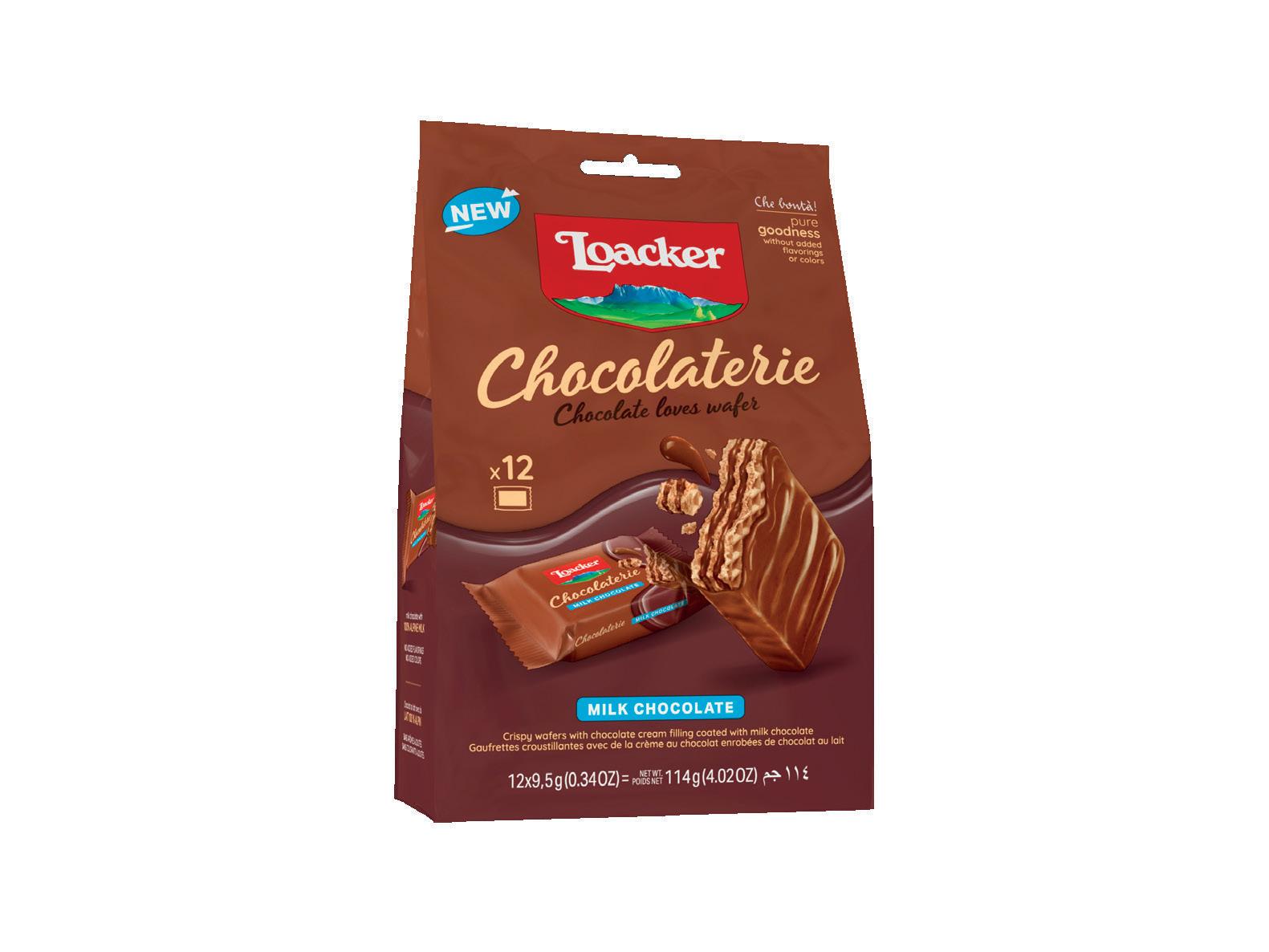


As this interview with Global Travel Retail Magazine reveals, Blueprint and m1nd-set’s upcoming workshop will discuss how Chinese, Indian and Korean Gen Z travelers – set to become travel retail's dominant demographic by 2028 – are fundamentally reshaping the industry with behavior driven by social media, experiential demands and evolving market dynamics, and how the industry should respond
Global Travel Retail Magazine (GTR Magazine): “The Asia Pacific Revolution” is the third installment of insights workshops that Blueprint has co-organized with m1nd-set. Can you tell us about the reasons and motivations behind these seminars?
Blueprint: The idea for these seminars arose during industry events where Blueprint and m1nd-set teams would exchange perspectives on how the Gen Z lifestyle is shaping travel retail. Their unique shopping behavior shaped by experiential retail, social media algorithms, technology and sustainability, particularly in travel retail, stood out. Our client discussions, echoed these findings. m1nd-set also noted growing interest from clients seeking deeper insights into this demographic.
We recognized the need for dedicated seminars to offer case-based, practi-
cal and data-driven insights. m1nd-set would share bespoke consumer data from global shopper interviews, while Blueprint would present real-world case studies from travel retail, high street retail and e-commerce on how to engage Gen Z.
After positive feedback from our clients, we launched the first “GenZ RedY” insights workshop in Cannes in 2023, followed by an Asia Pacific edition in Singapore in 2024. As experiential retail emerged as a major trend, we introduced the “EX.CEL Experiential Retail Workshop” in Cannes last year. Parallel to these workshops, we have held tailored seminars for leading companies.
Our goal is to explore evolving consumer behavior, identify key drivers of change, and offer actionable recommendations to help industry stakeholders adapt.
m1nd-set brings a wealth of experi-
ence and bespoke research to the table. The past 18 years m1nd-set has conducted more than three million interviews and sits on the most sophisticated consumer research database in the industry.
GTR Magazine: So the next collaborative workshop will highlight evolutions among this shopper segment too?
Blueprint: Absolutely. The Asia Pacific region is undergoing significant changes, particularly with the dominance of three key nationalities: Chinese, Indians and South Koreans. International departures among these groups rose by 30% last year, expected to grow by another 19% this year. Together, they account for 37% of all international departures in the region with over 455 million flights, a staggering number of travelers.
As younger generations from these nationalities travel more, their shopping

behavior – distinct from older generations – is reshaping attitudes toward travel and travel retail. It is crucial for industry stakeholders to understand the market size and evolving attitudes, as well as the needs and expectations of these travelers to remain relevant.
GTR Magazine: Can you expand on some of the changes you're seeing among these travelers?
Blueprint: The speed and intensity of change have now accelerated to a level where industry stakeholders must revisit their travel retail playbook. At Blueprint, we help these companies adapt to a constantly changing marketplace, as it is essential to focus on market opportunities.
For instance, m1nd-set data shows that footfall among Chinese travelers is below average; fewer than four in ten enter stores. This figure drops even further among older travelers, with less than a third of seniors visiting retail spaces.
Indian Gen Z travelers are on the rise. Last year, nearly one in five (19%) Indian passengers belonged to Gen Z – 5% above the global average. This marks a significant increase from previous years, where they represented 8% and 12% of passengers in 2022 and 2023, respectively.
During the workshop, we’ll explore these evolving trends and discuss practical strategies to attract key traveler segments and convert browsers into shoppers.
GTR Magazine: Can you give us a sneak preview of some of the recommendations you will be sharing at the workshop?
Blueprint: Without revealing too much, we’ll be discussing extraordinary cases influenced by social media, social commerce, experiential retail, artificial intelligence, geopolitics and much more. Most of these megatrends are powered by the influx of Gen Z lifestyle shoppers who are changing the travel retail landscape as we speak. As we approach 2028, these
younger travelers will represent 1.2 billion shoppers and become travel retail’s biggest customer profile.
The recommendations will be relevant to industry stakeholders including airports, operators, retailers, brands and industry associations on how to drive






footfall, dwell time, conversion, satisfaction and spend.
“The Asia Pacific Revolution” will take place at the MBS Expo Centre, Level 4, on the afternoon of Sunday, May 11, between 15.00 and 17.30 before the official TFWA Asia Pacific opening cocktail commences. Seats can be reserved at the following link: https://asia-pacificrevolution.eventbrite.ch

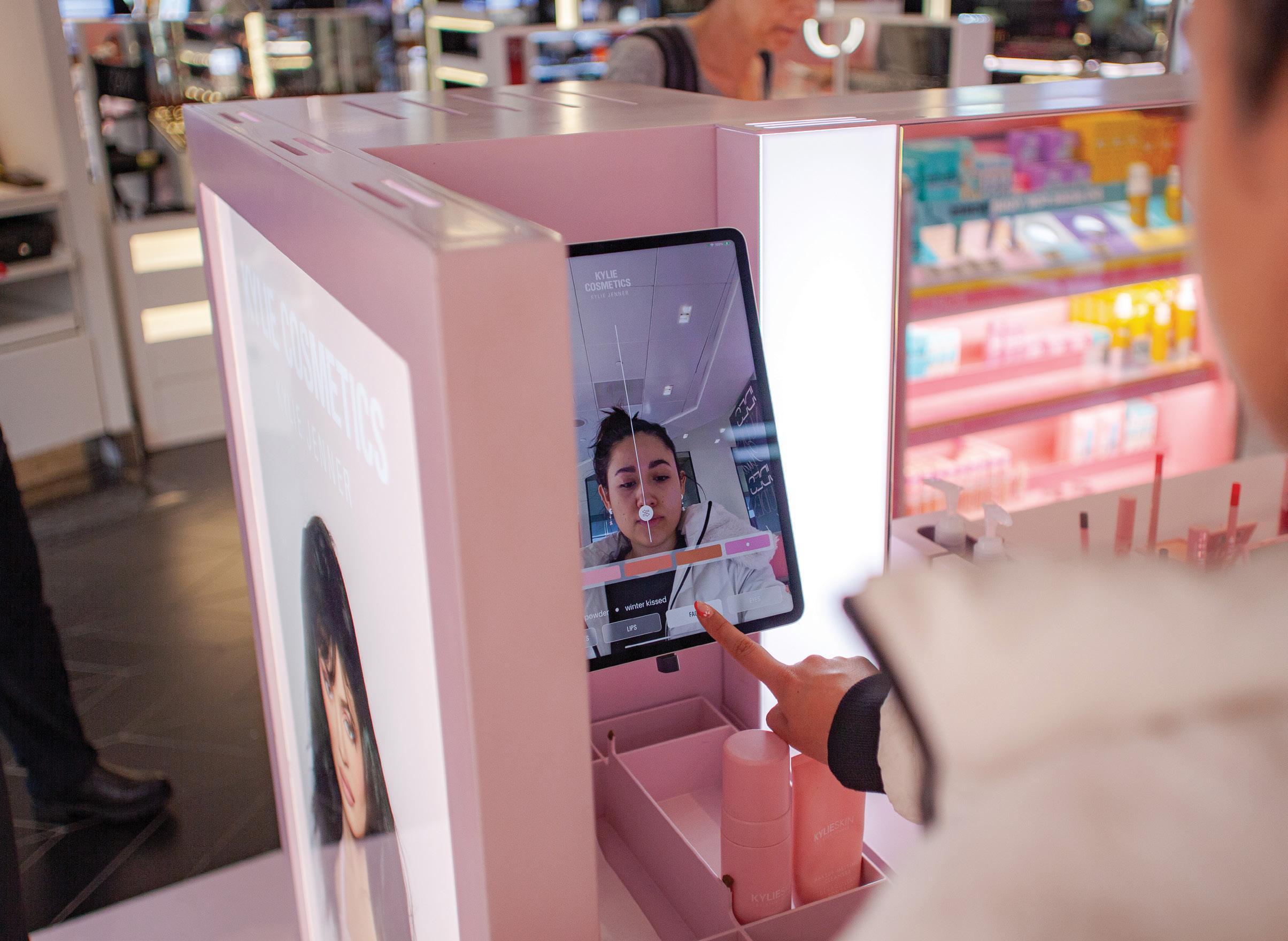
Coty enjoyed a robust net revenue growth of roughly 20% in travel retail in FY 2024, driven by a strong geographic footprint, multi-category expansion and effective collaborations with key retailers by HIBAH
Exclusive activations, immersive concepts and increased customer engagement: three key aspects of a travel retail strategy keeping Coty a major player at the top of the sector’s Beauty category, according to the company’s Chief Commercial Officer, Caroline Andreotti.
Considering Coty’s growth in travel retail in FY24, she says this success was driven by its broad-based geographic footprint, multi-category expansion and strong partnerships with key retailers.
Andreotti highlights standout FY24 launches such as The Heart of Leo Eau
NOOR
de Parfum, part of the Gucci The Alchemist’s Garden collection; Marc Jacobs Daisy Wild; BOSS Bottled Triumph and Absolu; and the avant-première launch of Gucci Flora Orchid. Coty also welcomed the continued momentum and success of Burberry Goddess.
“These launches were underpinned by exclusive activations and immersive concepts designed to bring our brands’ values and stories to life, ensuring we engage customers effectively with the right offerings at the right moments,” Andreotti says.

Transformation driven by Gen Z and Millennials
Andreotti notes how Gen Z and Millennials are transforming the global beauty industry, increasingly looking for shopping experiences that seamlessly traverse online and offline channels.
Omnichannel activations are key to Coty’s global strategy, engaging consumers from online discovery to
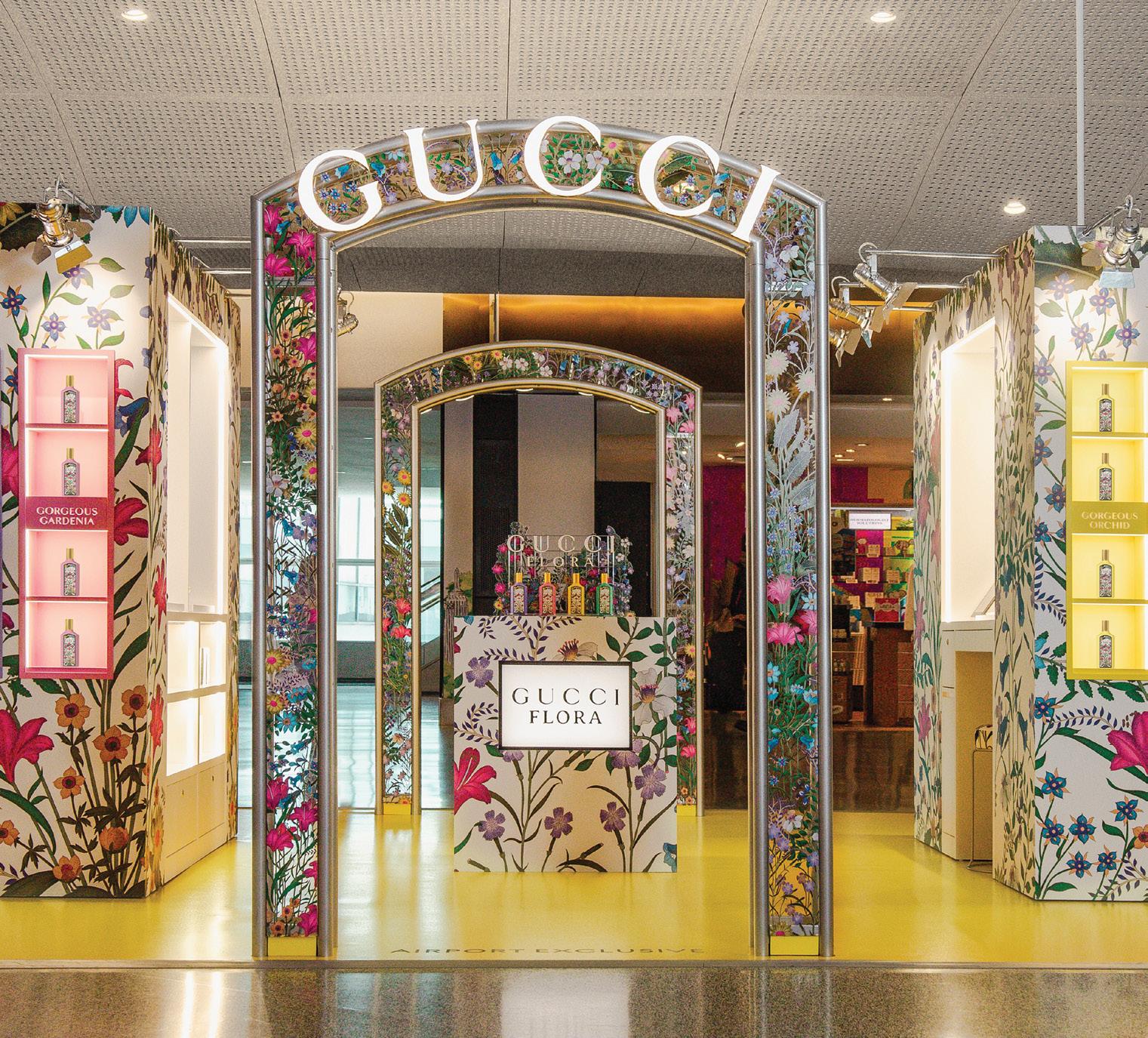
in-store purchases. “For example, we recently unveiled the avant-première launch of Marc Jacobs Daisy Wild Eau So Intense in major international airports across the Americas, Europe and Asia Pacific, combining digital innovation with in-store activations to take travelers on an exciting journey into the world of the fragrance,” she adds.
Andreotti explains how Coty is tapping into white-space opportunities in fast-emerging markets. “In 2024, we saw great success introducing Kylie Cosmetics to new markets such as India, Thailand and Singapore. The launch of Cosmic Kylie Jenner 2.0 in global travel retail earlier this year is testament to this continued momentum, building on the success of the debut fragrance Cosmic Kylie Jenner, a bestseller in the US and the UK,” she says.
Andreotti also underlines Coty’s focus on retailtainment, combining exclusive launches with creative on-the-ground activations, from cross-category pop-
ups to themed “brand takeovers” at major travel retail destinations.
Coty collaborates closely with its partners to “co-create dynamic customer experiences that accelerate product discovery, engagement and conversion through cutting-edge technology.” This includes AI-powered make-up try-on tools from brands such as Burberry, Kylie Cosmetics and Gucci, as well as digital technologies and interactive displays in physical stores.
Andreotti spotlights Coty’s partnership with Changi Airport Group and The Shilla Duty Free Singapore in 2024 to unveil the first-ever BOSS cross-category pop-up store in the Asia Pacific. “The pop-up brought fragrance and fashion together in a seamless, interactive experience,” she says. Coty has since expanded the concept to key airport locations across Europe and the Americas, showcasing a collaboration between BOSS fragrances, the HUGO BOSS fashion house and Safilo, which produces the BOSS eyewear line.
She also highlights Coty’s new long-
term license agreement with Swarovski, which “reinforces Coty’s reputation as the go-to partner for global brands looking to create or elevate their beauty portfolios.” The first fragrance under this licensing agreement is expected to launch in 2026.
Andreotti says Coty is guided by its “Beauty that Lasts” sustainability strategy, aiming to create new, different and “simply better” products that embody desirability and sustainability.
“This can be seen in how we apply principles of eco-design to new product innovations, evaluating their sustainability profile using our internal ‘Beauty that Lasts’ Index and reviewing packaging using the SPICE Lifecycle Assessment tool,” she says.
The glass bottle is lighter and crafted with 25% post-consumer recycled (PCR) material, while the cap is made with 96% PCR plastic.
In travel retail, Coty actively explores ways to reduce the environmental impact of its operations, from products to displays and the use of innovative touch-less fragrance testers in some locations.
“In travel retail, we want to create experiences that engage and excite our consumers, enabling them to interact with our products in new ways,” Andreotti says.
The Marc Jacobs Daisy Wild Eau So Intense launch in March demonstrates Coty’s expertise in creating unique omnichannel experiences. “To celebrate this launch, we recently unveiled Marc Jacobs’ first-ever cross-category activation at Sydney Airport. Combining the worlds of fragrance and fashion, the pop-up features a dynamic multi-sensory experience,” Andreotti says, adding that Coty has a number of exciting launches and activations planned for 2025.
Revealed through a social media campaign, Mavala’s new rebranding upholds its desire “to celebrate young women and men with confident, self-assured personalities in their natural and unique beauty”

Gen Alpha has become a major new demographic target for beauty and skincare brands, motivating industry names to adopt tech-first, playful approaches. Read on to learn more about Mavala’s new brand identity and Elizabeth Arden’s packaging revamp
by LAURA SHIRK
As Gen Alpha (2010-2024) becomes a driving force in consumer behavior, beauty brands are tailoring their products, promotions and communication styles to match this tech-savvy and social media-focused generation. As shared by Carly Ettinger, US Trends Analyst at strategic foresight consultancy, The Future Laboratory, from its new “Generations Now & Next 2025
Gen Alpha” report, this generation is highly influenced by online content, with Mintel revealing that 66% of beauty users aged 12-14 discover new products through social media (source: Cosmetics Business). In 2023 alone, Gen Alpha spent almost US$4.7 billion on beauty products, outspending every other demographic (source: ATYM).
“Gen Alpha has become a major new demographic target for beauty and
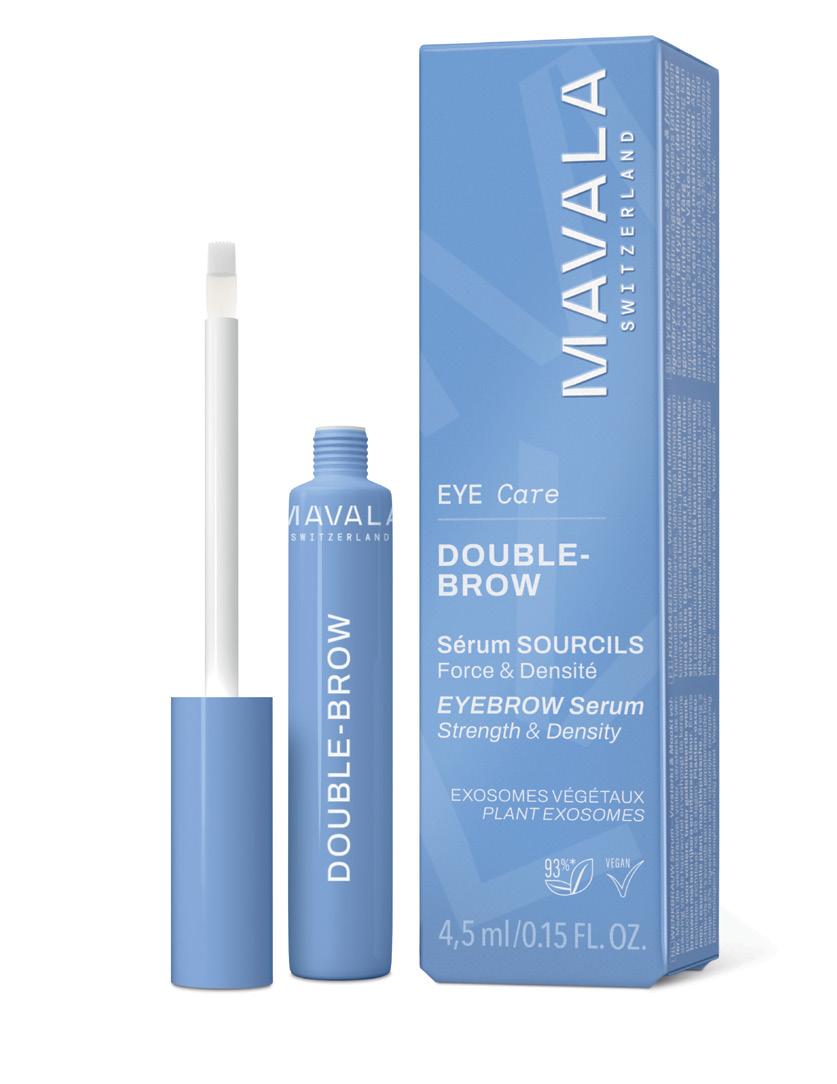































Eyebrow Serum Strength and Density
With plant exosomes, resurrection plant and pistachio mastic tree.



CLINICALLY PROVEN EFFICACY*: fuller, better-defined eyebrows with a naturally deeper colour.





















“Social media, gaming platforms and virtual experiences are essential touchpoints for connecting with [Gen Alpha] highlighting the shift toward interactive and youthfocused consumer engagement,” says Carly Ettinger at The Future Laboratory

skincare brands courtesy of the ‘Sephora Kids’ trend of 2024. We believe they are more brand conscious than ever and this cohort seek online education from social media. Their top priorities when it comes to pre-purchase decision-making are brand name, ability to address skin concerns, price (and value for money), ‘clean’ ingredients and formulas that are ethically sourced or made and inclusive values,” explains Ettinger.
Gen Alpha’s influence, she continues, is motivating beauty brands to adopt tech-first, playful approaches. “Social media, gaming platforms and virtual experiences are essential touchpoints for connecting with this generation highlighting the shift toward interactive and youth-focused consumer engagement.” However, it is worth noting, even before
social media, this age group is primarily influenced by their peers at school – where new-era social tribes drive both their aesthetics and attitudes.
Mavala’s new brand identity
In March, Mavala unveiled its new brand identity opening a new chapter in its history with a new logo, a new communication, a new website and a new manifesto: Mavala. Your care. Your style. With a portfolio of over 850 products, Mavala has been an international player in beauty and skincare since 1959. According to the team, the company seeks to connect more closely with its audience through a more distinctive and readable visual identity and adapt its communication by prioritizing ageappropriate self-care, education and
gentle formulations versus traditional content. “Our approach encourages healthy habits such as hydration, protection and simple self-care rituals, fostering a fun and responsible introduction to beauty for the future generations,” says Head of Marketing & Communication, Kathleen Eymery.
Mavala revealed its new image through a social media campaign. “The campaign features a group of young women and a man brought together through dance, guided by an experienced choreographer,” reads the updated press kit. “Together, they embody the brand’s expertise in a positive and modern way.”
“This rebranding upholds the brand’s commitments and its desire to celebrate young women and men with confident, self-assured personalities in their natural and unique beauty,” adds Eymery. “A reimagined identity with the same dedication to excellence.”
Through this new brand identity, Mavala will create digital-friendly content that prioritizes social media platforms. With a focus on contemporary, light and stylish elements, its content strategy includes communication assets designed specifically to appeal to a younger audience, as well as dedicated educational content in the form of fun and engaging videos that emphasize self-care and wellness, rather than cosmetics. It will also highlight influencer collaborations and user-generated content that deliver authentic connections and meaningful engagement.
According to Eymery, households in both the United States and Asia show a growing interest in beauty products among Gen Alpha consumers, influenced greatly by current cultural norms, AI advancements and the evolving perceptions of beauty.
“In Asia, particularly in South Korea and Japan, early skincare education is even more ingrained, with an emphasis on hydration, sun protection and barrier care. While the US market prioritizes


Elizabeth Arden is introducing its new HydraPlay Collection under the Eight Hour range, targeted as multi-beneficial simplified skincare for the next generation
ingredient transparency and minimalism highlighting a growing awareness of gentle self-care, the Asian market leans toward advanced hydration and multistep routines, even for younger consumers,” she comments. “Mavala ensures its skincare and nail care products are tailored to global preferences, prioritizing safety and suitability for young skin, while offering a responsible and effective approach to beauty.”
Elizabeth Arden revamps packaging
Elizabeth Arden is currently re-inventing the packaging of its iconic cult skincare brand, Eight Hour, which it says is a fit for the whole family. In addition to the revamp, the company is introducing its new HydraPlay Collection under the Eight Hour range, targeted as multibeneficial simplified skincare for the next generation.
“The campaign is vibrant, modern and speaks to a diversified multi-
cultural younger age group. The use of colorful fun icons to shout out product benefits help the products to catch the eyes of our new younger fans,” comments Yumie Chia, General Manager Travel Retail Asia Pacific.
“Importantly, the range is noncomedogenic, vegan and free of ‘nasties’ such as paraben. These traits are highly valued by Gen Alpha. Much of the marketing campaign for our Eight Hour range takes place via social media, the definite platform to be on to be seen by younger consumers.”
According to Chia, in Asia consumers start using skincare from a much younger age than the West. Tweens and teenagers are heavily influenced by their mothers, caregivers, peers and what they see on social media, hence their awareness toward self-care and beauty regimen comes at an earlier age. “[Alpha Gen] is especially concerned about cleansing, moisturizing, acne care and sun care,” she says.
Beauty and skincare brands are increasingly integrating shoppable video content into their marketing strategies and interactive experiences. Elaborating on how “shoppertainment” is transforming the ways in which consumers engage with brands, Chia points out social media engagement is linked to impulsivity and a direct shoppable click in the purchase link prompts stronger conversion rates. “We have recently created a piece of shoppable video content targeted at our travel-easy capsules serum in collaboration with The Shilla Duty Free via iShopChangi shopping platform,” adds Chia.
As visual media becomes a leading driver of e-commerce engagement and sales, Mavala has embraced this digital innovation through its new identity. “With video content focused on ageappropriate self-care products, these interactive assets not only entertain but also educate, fostering a deeper connection with the brand,” explains Eymery. “By ensuring that young consumers can make informed choices, Mavala makes beauty discovery both fun and responsible.” The team hopes that by integrating these multimedia approaches it will specifically enhance consumer engagement and brand awareness via its new website.


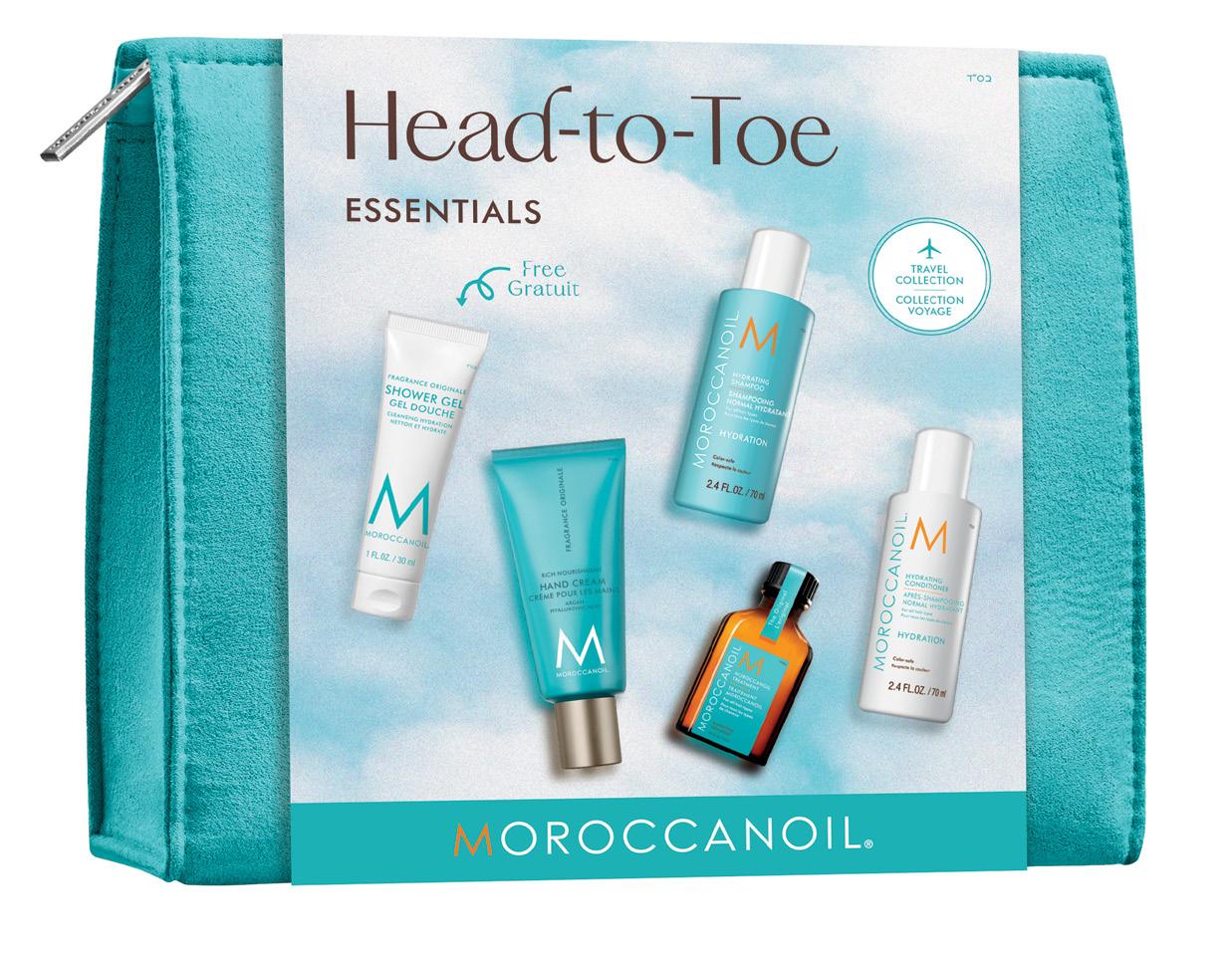
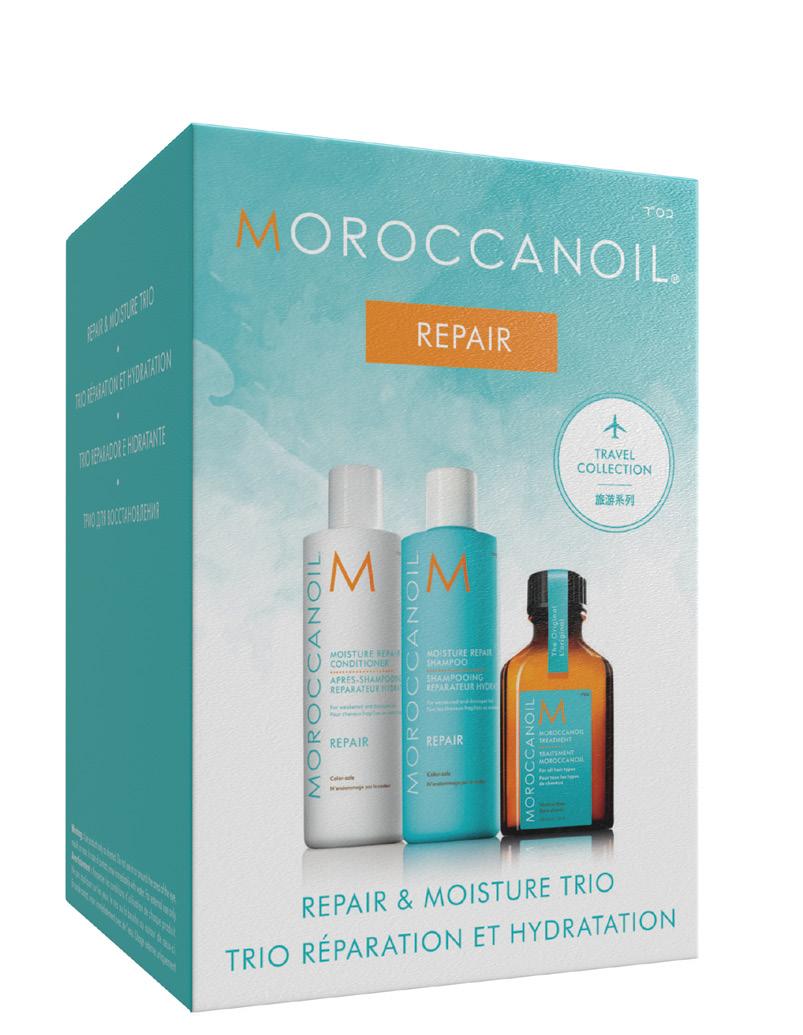
As consumers increasingly prioritize scalp health and professional-grade formulas, one of the most notable category trends in Asia travel retail is the “skinification” of haircare
Moroccanoil’s next steps in global expansion and a look at the future of the beauty category in travel retail
by LAURA SHIRK
Describing Moroccanoil’s expansion in Asia’s travel retail market over 2024/2025 as a promising journey, Violet Sainsbury, Senior Manager, Travel Retail Asia Pacific, explains navigating market nuances requires a tailored approach for each region. With Chinese travelers returning slower than expected and Southeast Asia emerging as a powerhouse for travel retail, securing prime visibility in competitive airport environments remains a key focus for the brand. The team is continually evolving its approach to experiential retail to increase traveler engagement.
Sainsbury remarks, “A critical first step is ensuring inviting on-shelf product discovery, where travelers
can experience the signature Moroccanoil fragrance and product textures firsthand. Ultimately, we aim to create a moment of indulgence in the travel retail space – turning a transit experience into a beauty discovery.”
According to Sainsbury, beauty remains one of Asia travel retail’s most resilient and fast-growing categories, with substantial recovery across key markets. She says, the return of Chinese travelers is fueling momentum, but Southeast Asia and India are also emerging as influential beauty destinations, shaping the future of the category.
“Our presence in Bangalore repre-

sents a strategic entry point into the fast-growing Indian travel retail space, marking an exciting step in Moroccanoil’s global expansion,” comments Sainsbury. “There’s a strong demand for premium, results-driven beauty products, with Indian travelers actively seeking high-performance brands they can trust.”
Looking to meet this demand, Moroccanoil is focused on offering retail expressions that bring the brand to life, including exclusive travel sets and tailored product assortments. Additionally, the brand is prioritizing strategic partnerships such as its collaboration with Avolta, which is in place to ensure premium visibility in high-traffic locations.
Beauty at sea
Post-pandemic Moroccanoil’s cruise business has reached new heights, nota-

bly with Starboard Group. As shared by Sainsbury, to generate brand awareness and sales onboard, Moroccanoil’s strategy is centered around exclusive travel sets and gift with purchase offers –creating cruise-exclusive offers tailored for travelers looking for luxury and convenience. “Luxury cruises cater to experience-driven, high-spending travelers, making it an ideal environment for a brand like ours – where indulgence, self-care and premium beauty go hand in hand,” says Sainsbury.
“We intend on making the most of Starboard [Group]’s push in Asia, that will clearly benefit us, as we combine our channel expertise with our regional developments. With the cruise industry booming in Asia, this channel presents incredible growth potential, and we’re excited to elevate the beauty offering for travelers at sea,” she continues.
When it comes to bringing beauty
to sea, Moroccanoil has “lofty” goals of creating the ultimate experiential retail activations featuring onboard styling sessions and tutorials that showcase its hero products.
The “skinification” of haircare As consumers increasingly prioritize scalp health and professional-grade formulas, Sainsbury points out one of the most notable category trends in Asia travel retail is the “skinification” of haircare. “This aligns perfectly with Moroccanoil’s positioning and our latest launch, the Scalp Collection, which was developed in Japan with scalp experts and features a refreshing, scalp-optimized fragrance and formula tailored to evolving consumer needs,” says Sainsbury.
Driven by a favorable exchange rate and an influx of visitors, the travel retail sector in Japan is experiencing signifi-
Earlier this year, Moroccanoil released its first-ever fine fragrance, L’Originale Eau de Parfum. This transportive fragrance captures the essence of a luxuriant escape – blending sweet florals, velvet woods and spicy amber –and invites consumers to experience the Mediterranean.
To mark this launch, Moroccanoil signed American actress, Adria Arjona, as the muse of its advertising campaign. According to the brand, the visuals, shot in Puglia, Italy, by renowned photographer Mikael Jansson, transport viewers on a journey to explore pockets of paradise that hold the secrets of the Mediterranean.
“After years of customers asking for us to develop an Eau de Parfum featuring our iconic scent, we are thrilled to finally share the brand’s expansion into the fine fragrance category,” says Co-founder Carmen Tal.
Housed in a sleek, crystal-clear glass bottle – featuring a gentle curvature, golden amber hue and regal turquoise cap (a Moroccanoil signature) – L’Originale is designed to embody timeless elegance.
Moroccanoil L’Originale Eau de Parfum is available in three sizes (100-ml, 60-ml and 10-ml) and for purchase via the Sephora app, online at Moroccanoil.com and Sephora.com, and in-store at select travel retail.
cant growth. “Moroccanoil saw tremendous momentum in the channel last year and anticipates continued expansion in 2025, with new openings and an increased retail presence,” she adds.
From nutrient-packed snacks and better-for-you options to purposeful eating, we dish on the latest trends in confectionery and food; plus, more on the power of social media
by LAURA SHIRK
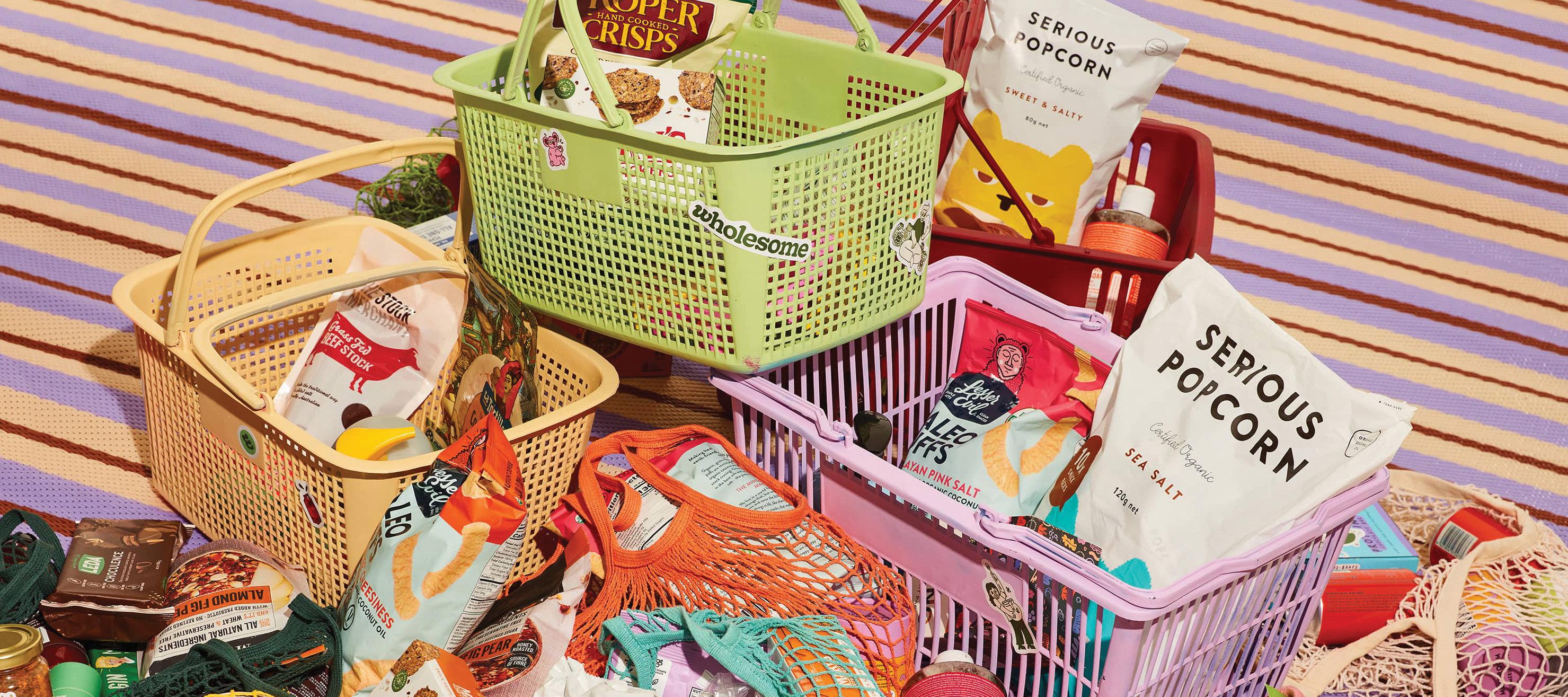

Consumer demand continues to drive healthy, delicious and sustainable food trends in 2025. Fundamental nutrition and functional snacking have taken the lead as consumers are taking a closer look at how to best meet their daily essential nutrient needs via a balanced lifestyle. This means nutrient-packed snacks and product innovations are in the mix, in addition to better-foryou alternatives to support mindful snacking and purposeful eating. The prioritization of natural ingredients and eco-friendly initiatives continues to influence purchasing decisions, as shoppers seek novel flavors and textures that offer a holistic taste experience in spite of rising costs.
In the world of travel retail, the universal appeal of confectionery and
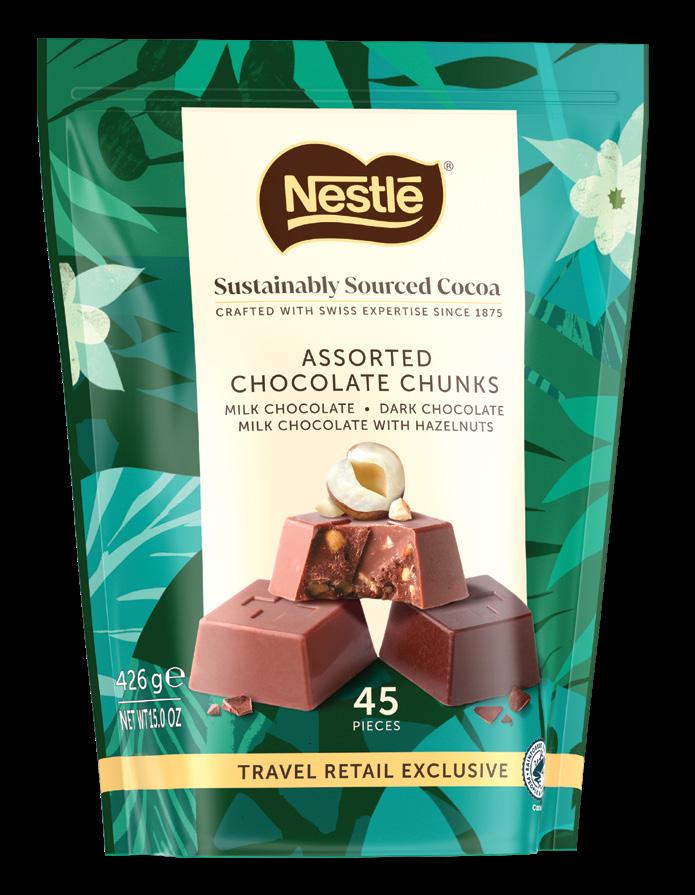
Disruptive campaigns for brands like KitKat and Nestlé Sustainably Sourced leverage gamification, retailtainment and a sense of place across multiple touchpoints – online, in-store and at airports
food provides resilience in the face of declining basket sizes and inflationary pressures. According to the TFWA Global Duty Free Buyer 2025 Report, confectionery is the category with the highest conversion rates, driving the greatest number of items purchased. The category is purchased by more than one
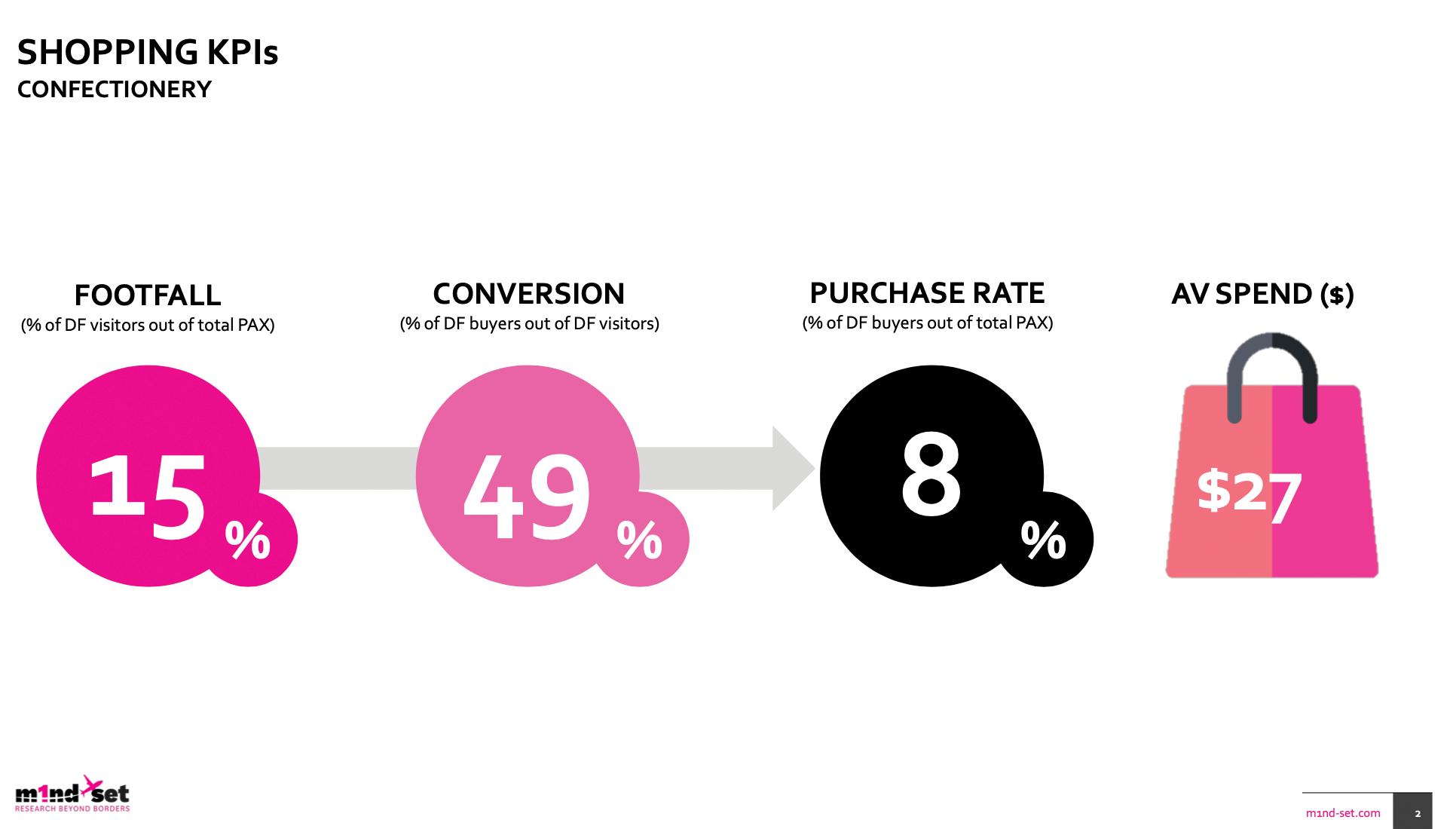
As reported by m1nd-set, the average confectionery spend in duty free and travel retail is US$27. The category is fuelled by the convenience driven nature of on-the-go travelers and the self-treat purchase occasion
third of duty free shoppers. It is fuelled by the convenience-driven nature of on-the-go travelers and the self-treat purchase occasion. As noted by m1ndset, the category has a purchase rate of 8% and an average spend of US$27.
“As both impulse-driven and emotionally connected categories, confectionery and snacks remain affordable indulgences, encouraging spending even in cost-conscious environments. Nestlé International Travel Retail (NITR) strategically promotes value-driven formats such as multi-packs, shareable selections and exclusive travel bundles in order to enhance value for the shopper,” comments Frédéric Porchet, General Manager at NITR. “By balancing premium offerings with accessible price points, we continue to drive engagement and maintain shopper conversion despite macroeconomic challenges.”
As shared by Porchet, while pleasure remains a key entry point into con-
fectionery, travelers are increasingly looking for snacks that offer nutritional value, portion control and ethical sourcing.
“Nestlé is responding with innovative formats, including portioned indulgences, as well as a full range of products that have a strong anchor in sustainability,” he adds.
Due to the category’s versatility, accessibility and ability to appeal to all types of traveler need states, leading global food company Otis McAllister believes confectionery products are likely to be purchased regardless of economic downturns. With offices worldwide, the company offers a wide range of services to a client base that includes club stores, traditional and non-traditional retail, food service and more. It also owns brands in rice, canned goods and beverages.
“Shoppers can still indulge in small treats which provide a sense of luxury
without the higher price tag,” shares Marc Panara, Vice President Sales & Operations at Otis McAllister. “It is the most impulse purchased [category] in travel retail, where the consumer is frequently looking to reward, refresh and recharge. Offering a variety of easily accessible products can encourage these spontaneous purchases, helping to counteract a drop in basket size.”
Additionally, confectionery is viewed as a popular gift option. This is especially the case when packaged attractively, which is why the company’s range is focused on travel retail exclusive packaging. “The availability of such products at a range of price points caters to different shopping budgets and can encourage higher volume purchases even if individual spend decreases,” continues Panara.
Right now, Otis McAllister is monitoring the rise of the wafer category globally and expanding its non-choco-
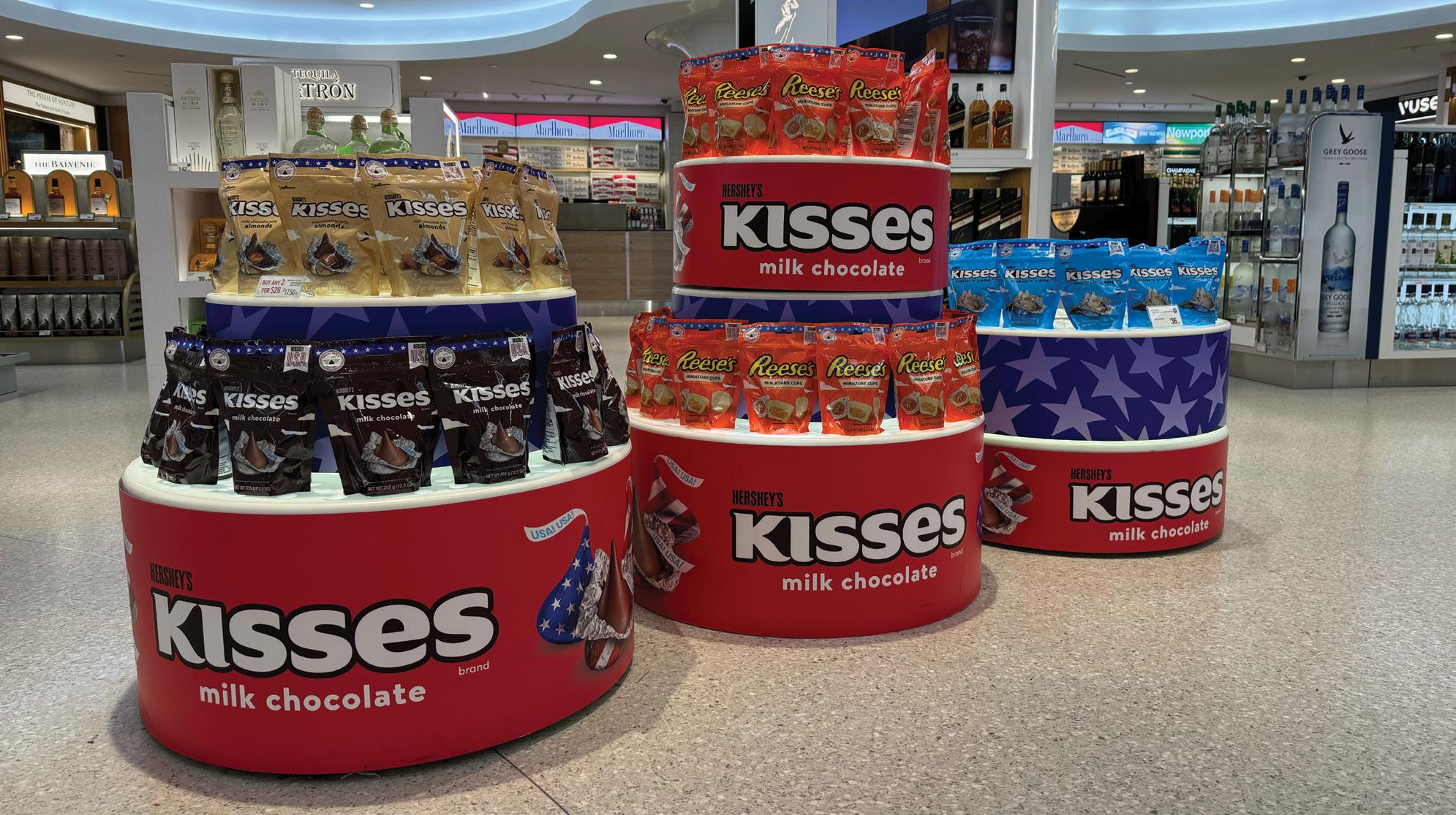
late/sugar range, as well as its snacking, better-for-you and sustainably-sourced options, while keeping in mind the need for differentiated and premium packaging within the channel.
Describing the current state of snacking in travel retail, Panara notes the company has seen an increased demand for convenience in general in which shoppers are looking for grab-and-go items, single-serve packs, portion-controlled snacks and products that are easy to carry. The shift toward mindful snacking he identifies is directed by the new consumer attitude toward conscious eating, sustainability and overall health.
“This rise in demand has coincided with a more mindful consumer seeking health-conscious options. You see more offerings catering to different dietary preferences than you have in the past such as vegan, keto, low in sugar, plantbased, gluten-free etc. The consumer is snacking more than ever today, but it now is more of a balance between indulgent items and better-for-you options.
“Consumers want to enjoy a treat that aligns with their dietary prefer-
ence without overindulging. They make informed choices when it comes to ingredients and nutritional information but just as important is choosing products that align with their values when it comes to sustainability. Because of this, many brands are transforming their packaging to be more eco-friendly, sourcing ingredients responsibly and achieving sustainability certifications along the way. We have seen several of our brands update their typical pouch
Marc Panara at the global food company Otis
says due to the category’s versatility, accessibilty and broad appeal confectionery products are likely to be purchased regardless of economic downturns
bag to a paper-based product,” says Panara.
Consumer behaviors and open communication
According to Porchet, spending patterns in travel retail vary significantly by nationality, influenced by cultural preferences, gifting traditions and price sensitivity. The General Manager states Middle East and Africa have the highest category footfall, conversion and pur-
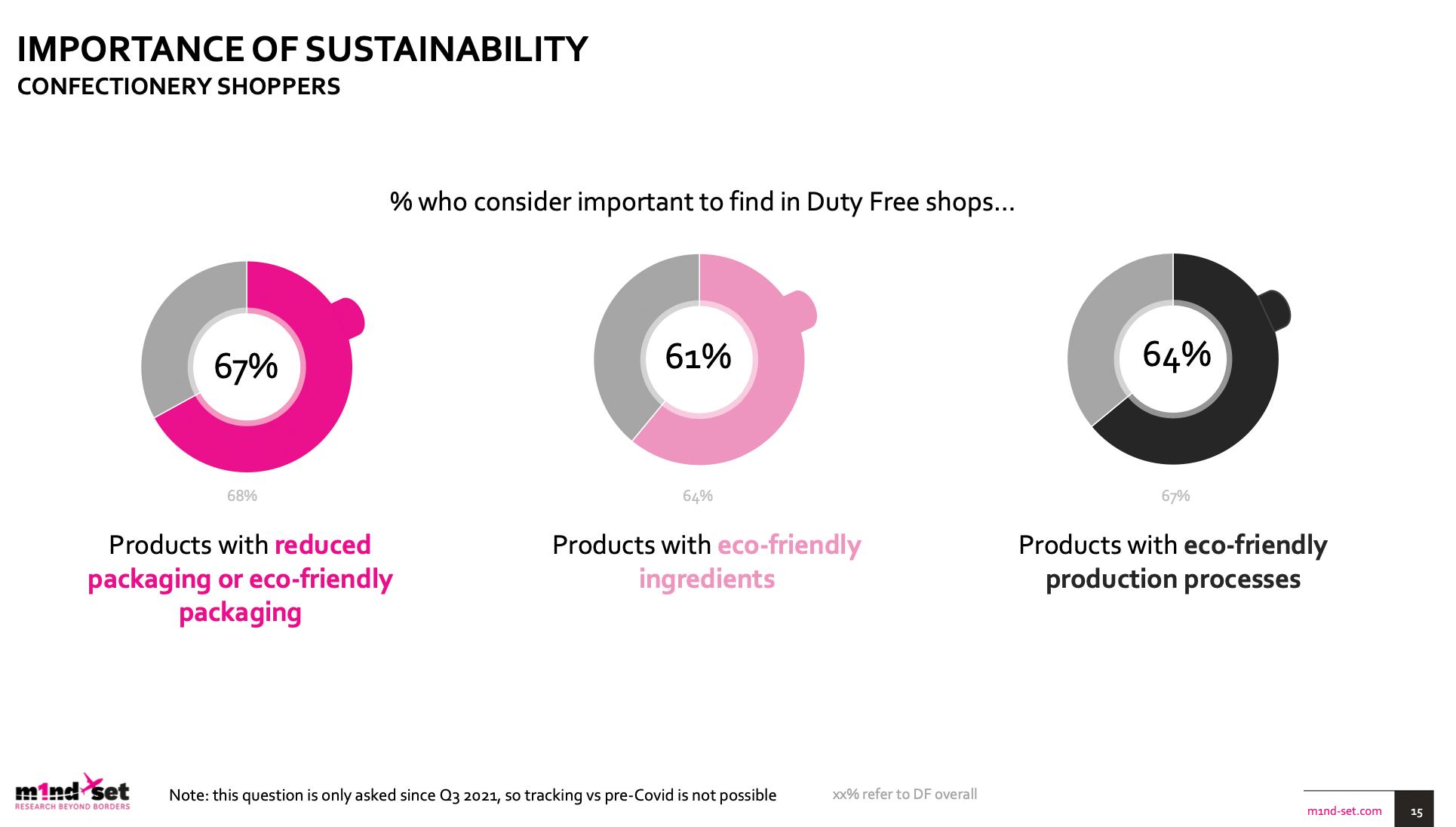
According to m1nd-set, when selecting confectionery items, 67% of duty free shoppers consider it is important to find products with reduced packaging or eco-friendly packaging; 61% consider it is important to find products with eco-friendly ingredients



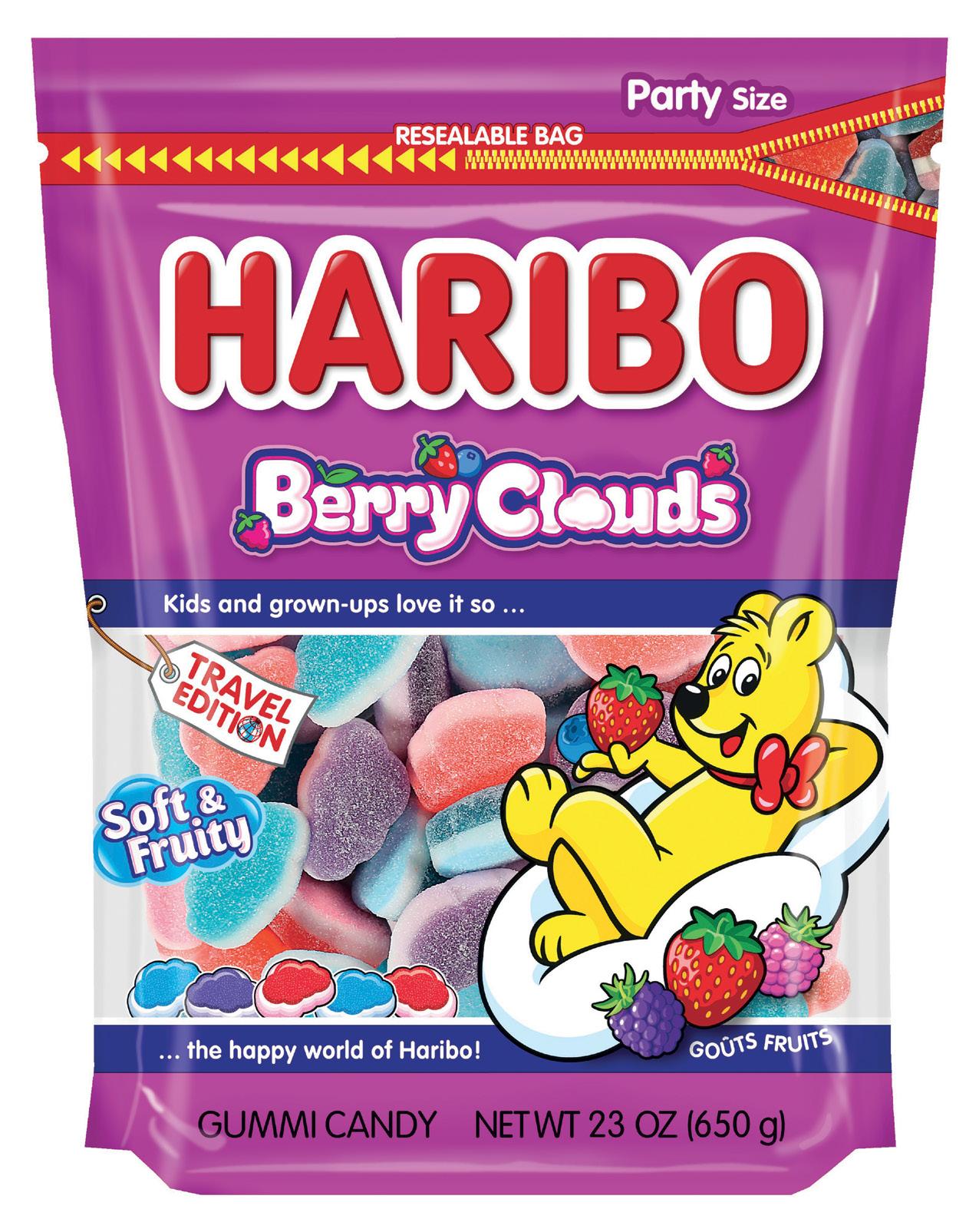
According to Philippe Moryl at Avolta, the retailer is seeing an increase in demand for self-consumption products in diverse formats, with bars and snacking formats tracking well
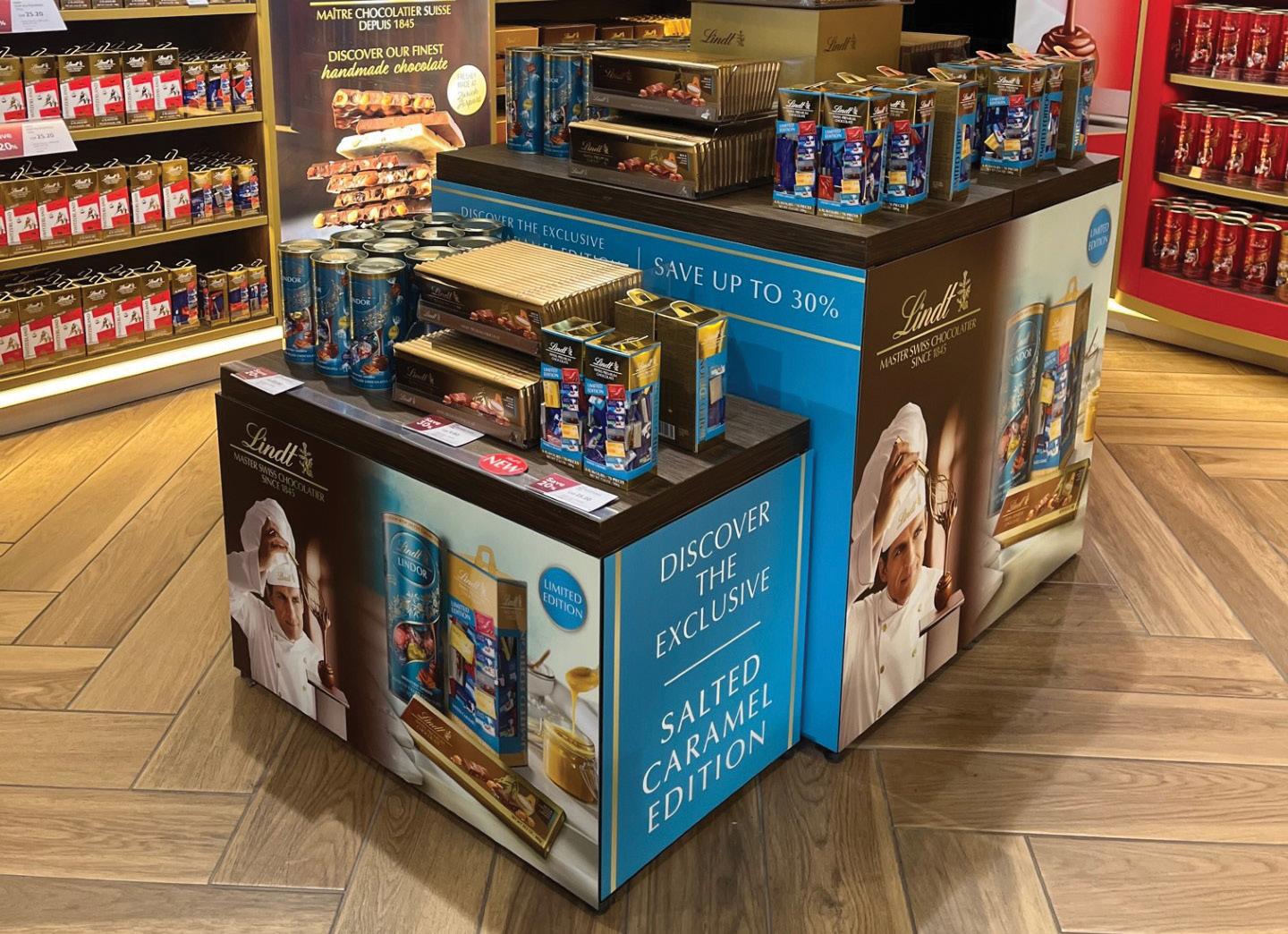
chase rate. There are also regional differences in terms of purchase occasions.
“For example, shoppers in the Americas over index versus global average for selfconsumption, while gifting purchases peak in MEA and sharing in ASPAC,” he says. “Understanding these nuances enables targeted product placement and marketing strategies that will maximize sales and shopper satisfaction.”
A profile of duty free confectionery shoppers in the MEA region by m1ndset shows they are more likely to be male, primarily millennials and Gen X, and traveling in standard class. Across the board, key drivers of confectionery purchases in the channel include value for money (21%), convenience (19%) and ample time to choose (17%). When selecting confectionery items, 67% of duty free shoppers consider it is important to find products with reduced packaging or eco-friendly packaging; 61%
consider it is important to find products with eco-friendly ingredients.
As a result of rising prices – particularly within the chocolate segment – companies now more than ever need to successfully communicate their messaging to the consumer in a timely but effective manner. Panara says this can be highlighted via sustainable packaging, as well as QR codes on pack that exemplify not only how products are sourced, but also how companies are working to lower their carbon footprint. Other information worth communicating: functional, clean ingredients, innovative flavors that highlight the local or regional culture and relevant certifications achieved. He explains, “These types of actions will help [brands] differentiate themselves from competition and other categories.”
On the same wavelength in regards to communication and transparency,

the Mintel 2025 Global Food and Drink Trends Report reads, “As disruptions to the food supply become more frequent, the industry will need to encourage consumers to accept and trust the new origins, ingredients and flavors that will emerge locally and globally.”
Avolta reacts in record time In terms of passenger selection, Avolta’s Global Head of Category, Confectionery & Food, Philippe Moryl, reveals the retailer is experiencing a similar year compared to 2024 during which it
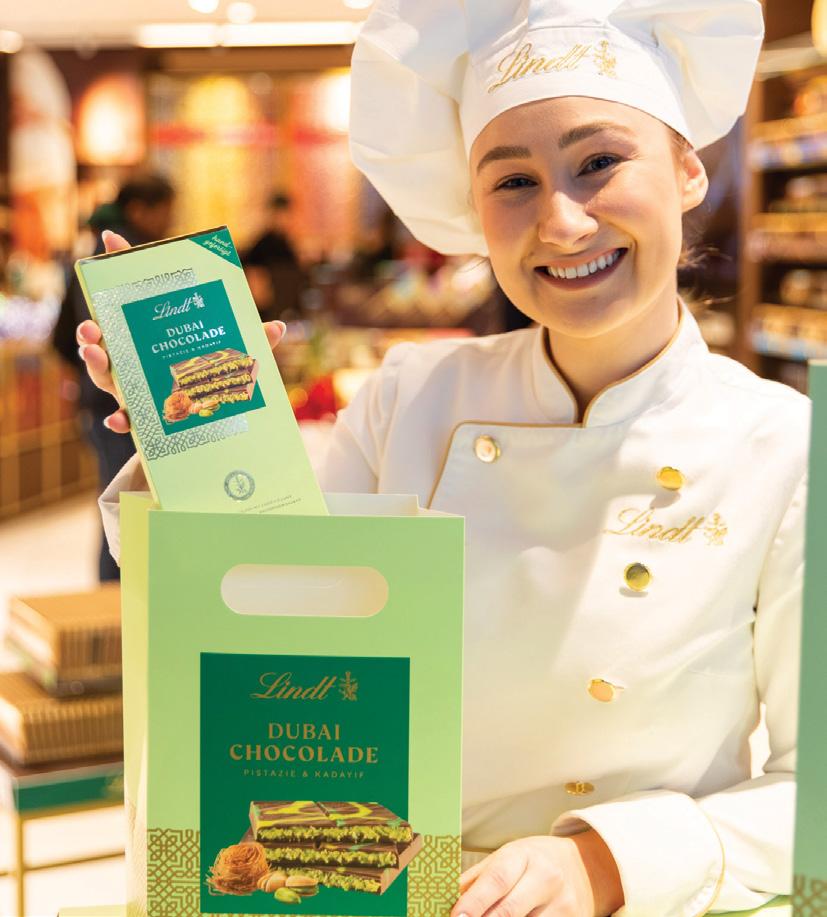
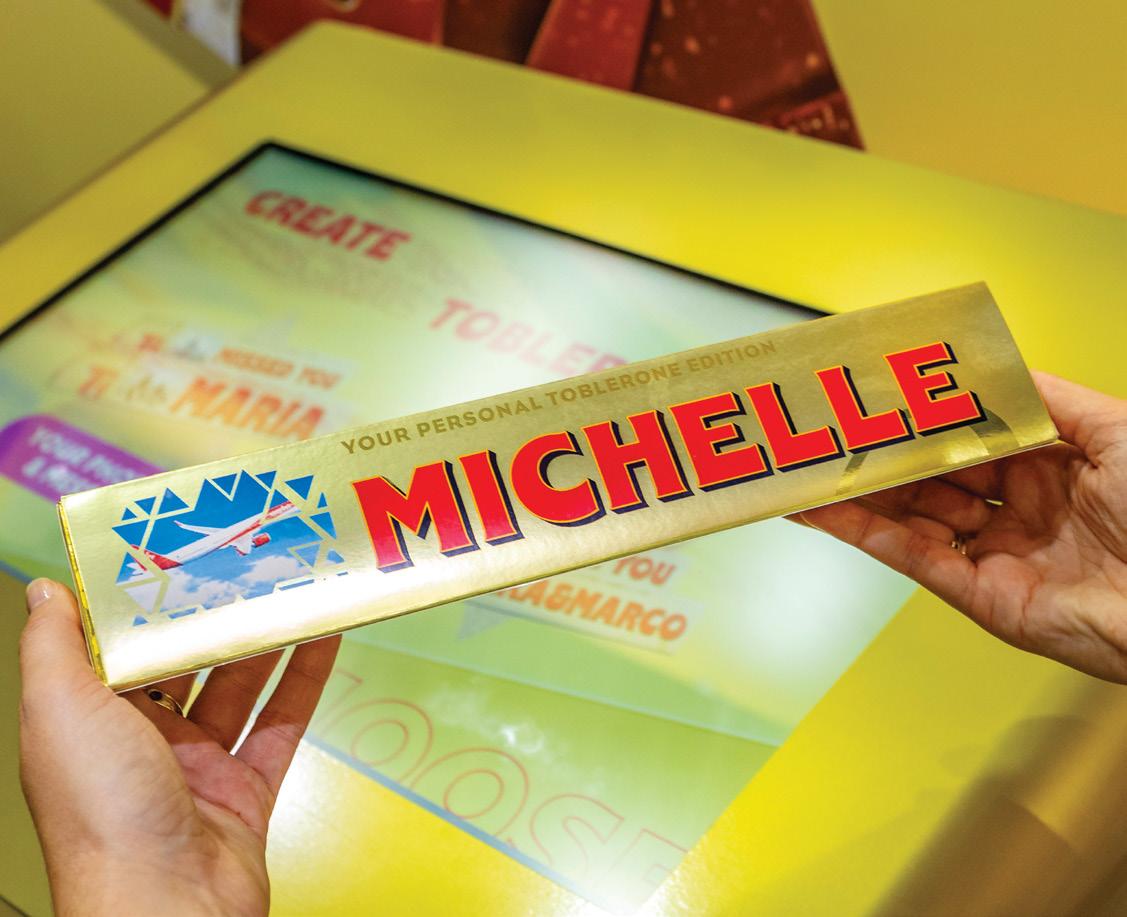
saw a strong performance among local assortments and the premium segment. This confirmed the importance of sense of place among customers. According to Moryl, the retailer is seeing an increase in demand for self-consumption products in diverse formats, with bars and snacking formats tracking well.
He adds, “A new trend which has generated significant consumer interest is Dubai Chocolate, and we expect its success in the Middle East will continue to extend worldwide, with demand remaining very high.” As reported by The Future Laboratory, Dubai Chocolate Bar was included in 2024’s top performing #FoodTok trends.
Speaking about experiential marketing initiatives used to enhance confectionery engagement and impulse purchasing among passengers, Moryl remarks Avolta is always working in close collaboration with its brand partners to offer unique experiences to its customers based on personalization, exclusivity, tastings and gamification.
“The exclusive one-day Lindt Dubai Chocolade
Airport at the end of 2024 offers a great example of the way in which we can react quickly to respond to traveler trends and demands,” explains Moryl. “We were able to offer the much soughtafter Lindt Dubai Chocolate to our customers when the viral ‘Dubai Chocolate’ trend sweeping social media platforms was at its peak.”
Over the last two years, Avolta has been introducing healthier product options to its portfolio and will continue to do so. This will predominantly be seen across its mind.body. soul. store-in-store concepts, where the retailer works with local and global brands to offer health-focused snacks and confectionery.
“We are working with some of the leading premium chocolate brands including Lindt, Venchi, Pancracio and Baratti & Milano, as well as other more local brands to introduce more artisanal and premium confectionery options for our customers. From bespoke limitededition offers, to selections emphasizing a strong sense of place, we have a lot of exciting offers coming up this year,” says Moryl.
As seen on social When asked how social media is influencing experimental flavor innovation and demonstrating food as a form of expression, Seyi Oduwole, Foresight Analyst at The Future Laboratory, replied through platforms like TikTok, food trends can quickly gain momentum, leading to widespread consumer interest and impacting ingredient demand and supply chains. As seen in the case of Dubai Chocolate, the platform has the power to accelerate culinary trends and inspire product development.
“Additionally, social media channels are being utilized by brands to build hype for unique or limited-edition flavors. Social media can be used to tease new flavors, garner public interest, and create a sense of novelty around food products.
“Social media has also facilitated the intersection of food and personal expression. Food-related content and challenges often emphasize creativity and individuality, allowing users to explore and express their identities through culinary experimentation,” says Oduwole.
In this Baggage Report, Global Travel Retail Magazine hears from category players about the importance of circular design, the latest on b-leisure travel in Asia and product development trends
by LAURA SHIRK

The rise of circular design in fashion and travel gear reflects a shift in consumer preferences among the modern traveler toward longevity, durability and responsible consumption. Across the category brands are prioritizing high-quality materials and construction, as well as improved after-sales care to simultaneously champion the planet and the consumer.
“Our bags are known for their lightweight yet durable ripstop nylon, which inherently supports a ‘buy better, use longer’ approach,” comments Keigo Yamazaki, Sales Director at LeSportsac. “Beyond durability, we continuously innovate in sustainability by integrating recycled materials into our collections, improving manufacturing efficiencies and reducing waste. Additionally, our commitment to modular and multi-functional design ensures that consumers can get more use out
of a single bag, reducing the need for frequent replacements.”
To promote a “buy better” mindset, Eastpak products come with a 30-year limited global warranty, meaning the company also ranks repair over replacement. With a brand heritage rooted in crafting military-grade bags in the 1950s, the American lifestyle brand continues to uphold strict quality management standards today. “By focusing on long-lasting performance and repairability, we aim to extend product lifespans and reduce unnecessary waste – offering a responsible alternative to the throwaway culture,” says Isis Buyse, Director, Global Product Eastpak & JanSport – EMEA.
In the case of Victorinox, its 1+10 travel gear warranty ensures that during the first year of ownership the company covers repair expenses, shipping costs, damage through external parties (i.e.
airline handling) or if needed, product replacement. As noted by Victorinox, its Spectra 3.0 collection shell material is composed of up to 65% SORPLAS™, with the rest being virgin polycarbonate. “Despite the high utilization rate of recycled materials, SORPLAS™ meets Victorinox’s strict quality standards and is built to last,” states Gloria Dix, Head of Global Travel Retail & Fragrance Sales at Victorinox. SORPLAS™ is a high-performance recycled polycarbonate developed and provided by Sony Semiconductor Solutions Corporate.
The rise of b-leisure travel
According to Bric’s PR & Communication Officer, Luisa Puggioni, the rise of b-leisure travel – blending business and leisure – has redefined modern travel habits, particularly in Asia. This shift has increased demand for versatile, multi-functional travel gear that
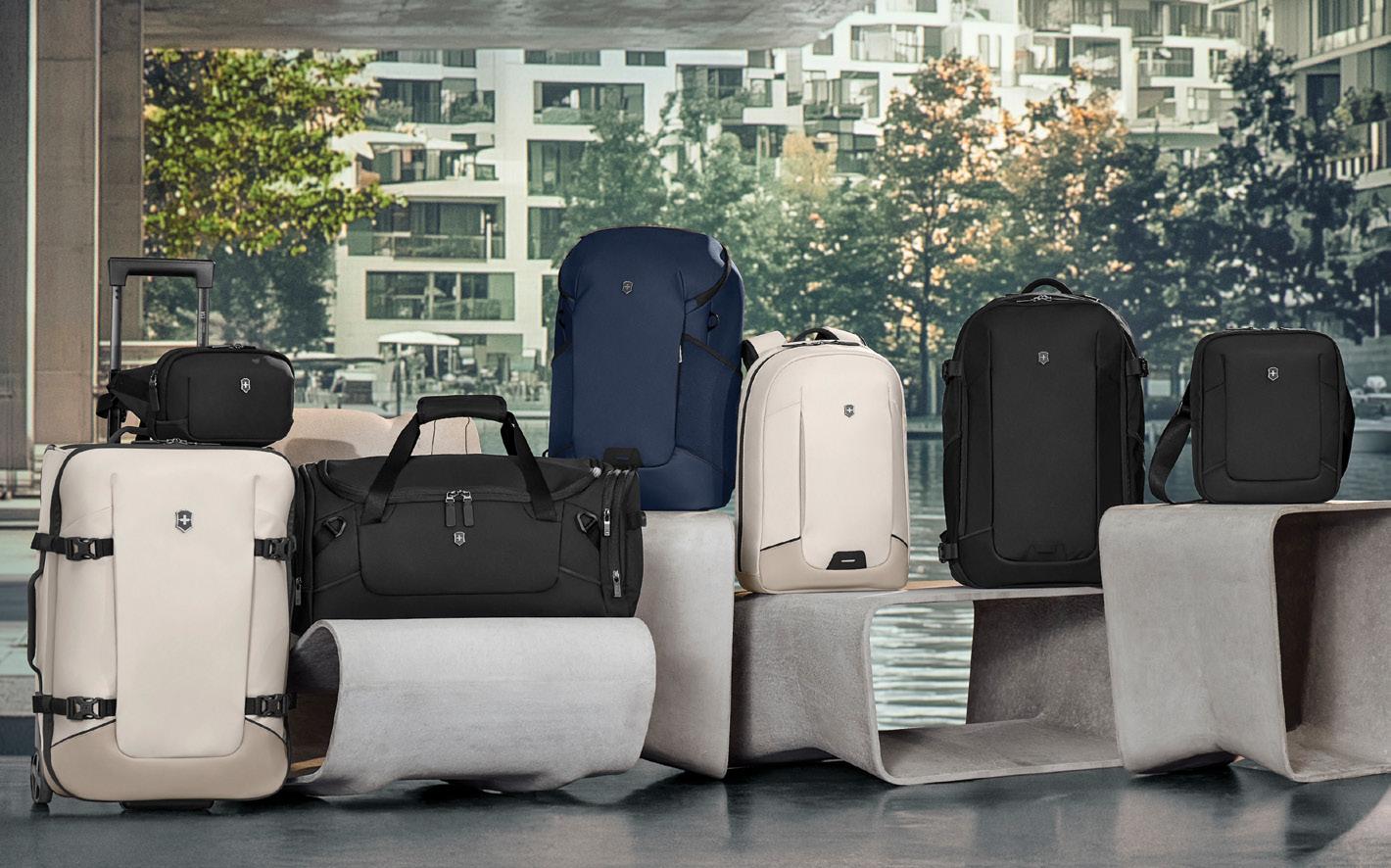
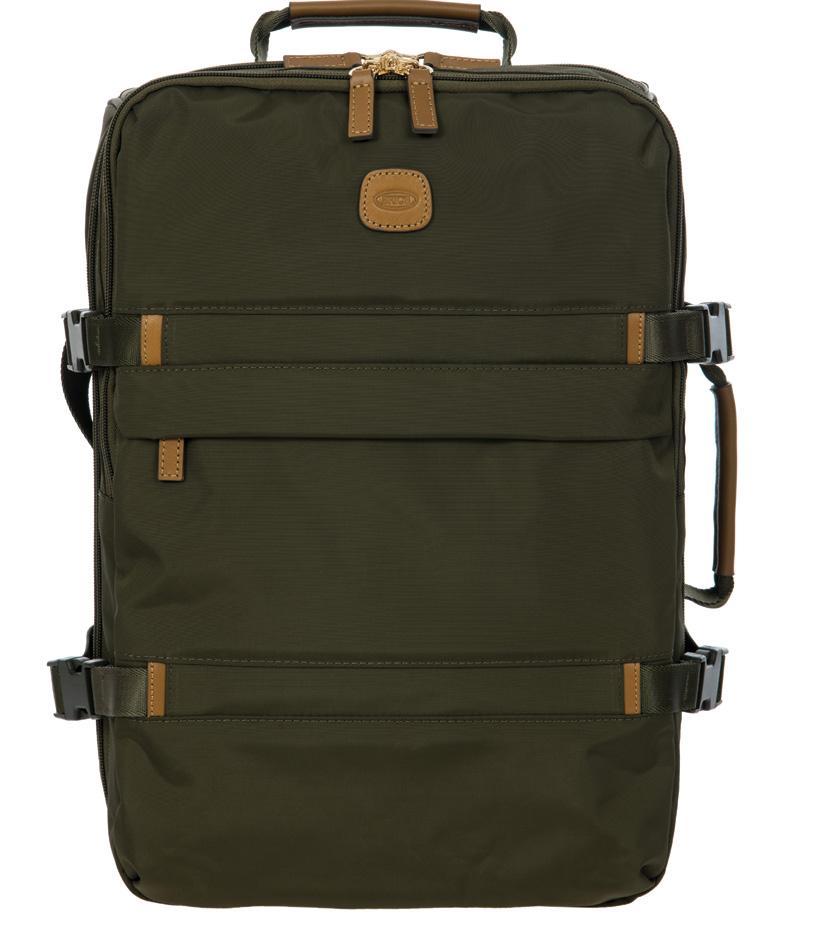
can transition from work to weekend. The Italian company has addressed this trend by designing luggage and bags that combine functionality and elegance. Puggioni explains, “A great example is our X-Collection under seat backpack, designed specifically to fit within the strict carry-on allowances of major airlines, making it ideal for professionals who travel light, but need maximum efficiency. Our collections feature versatile compartments, easy-access pockets and smart organizational solutions to support travelers transitioning from work to leisure.”
With the increase of remote work and flexible schedules, b-leisure travel has gained significant traction globally, but Dix confirms it’s seen more prominently in certain markets. “Professionals now have opportunities to explore new destinations while fulfilling work obligations, marking a significant shift in global tourism dynamics,” she says. Countries like Thailand, Japan, China and India are welcoming working travelers, who are eager to experience rich cultures and diverse landscapes. “The region has seen a substantial rise in this
kind of travel, driven by industries that prioritize frequent business trips and a stronger focus on employee wellbeing,” Dix adds.
Built on the success of its Altmont franchise, Victorinox’s new Altmont Modern collection provides “something more business appropriate” than the rest of the Swiss brand’s Altmont offerings. Backpacks and daypacks in this collection features a removable laptop sleeve (for a 15.6-inch electronic device) that can be used as an integrated item or removed as a standalone product. Plus, lockable zippers mirror Victorinox’s protection promise with dedicated space for a key fob, sound pocket, eyewear holder compartment and business organization. The range also includes reflective accents for increased visibility. According to Dix, this range delivers modular functionality as hybrid journeys that combine business and leisure require seamless transition. Dix shares, “We see a growing audience of young professionals who want to tag a personal trip on the back of business travel, or who cycle into a corporate job but want their bags to be adaptable for after-
hours. The Altmont Modern collection delivers efficient internal organization with durable, long-lasting materials.”
Victorinox’s ALOX NERO offering, which is exclusive to the Asian market, is set to launch in the second half of this year.
Beyond travel gear, Yamazaki says b-leisure is reshaping how people move, especially in Asia, where high-speed travel between urban centers is common. This new wave of travelers is made up of consumers who blend work and personal time and require bags that are both efficient and stylish.
“Our portfolio includes smartly designed backpacks, crossbody bags and weekenders that transition seamlessly from business meetings to casual exploration. Features like multiple compartments, travel-ready pouches and lightweight packable materials cater to the modern traveler’s needs,” says Yamazaki. “Additionally, our ongoing collaborations – including our most recently released partnership with Roberto Cavalli – offer fashionable yet
As a response to travelers seeking baggage that not only serves a practical purpose, but also makes a statement, Eastpak introduced its Resist’r Case – a new hard-shell luggage that fuses highperformance design with strong visual appeal
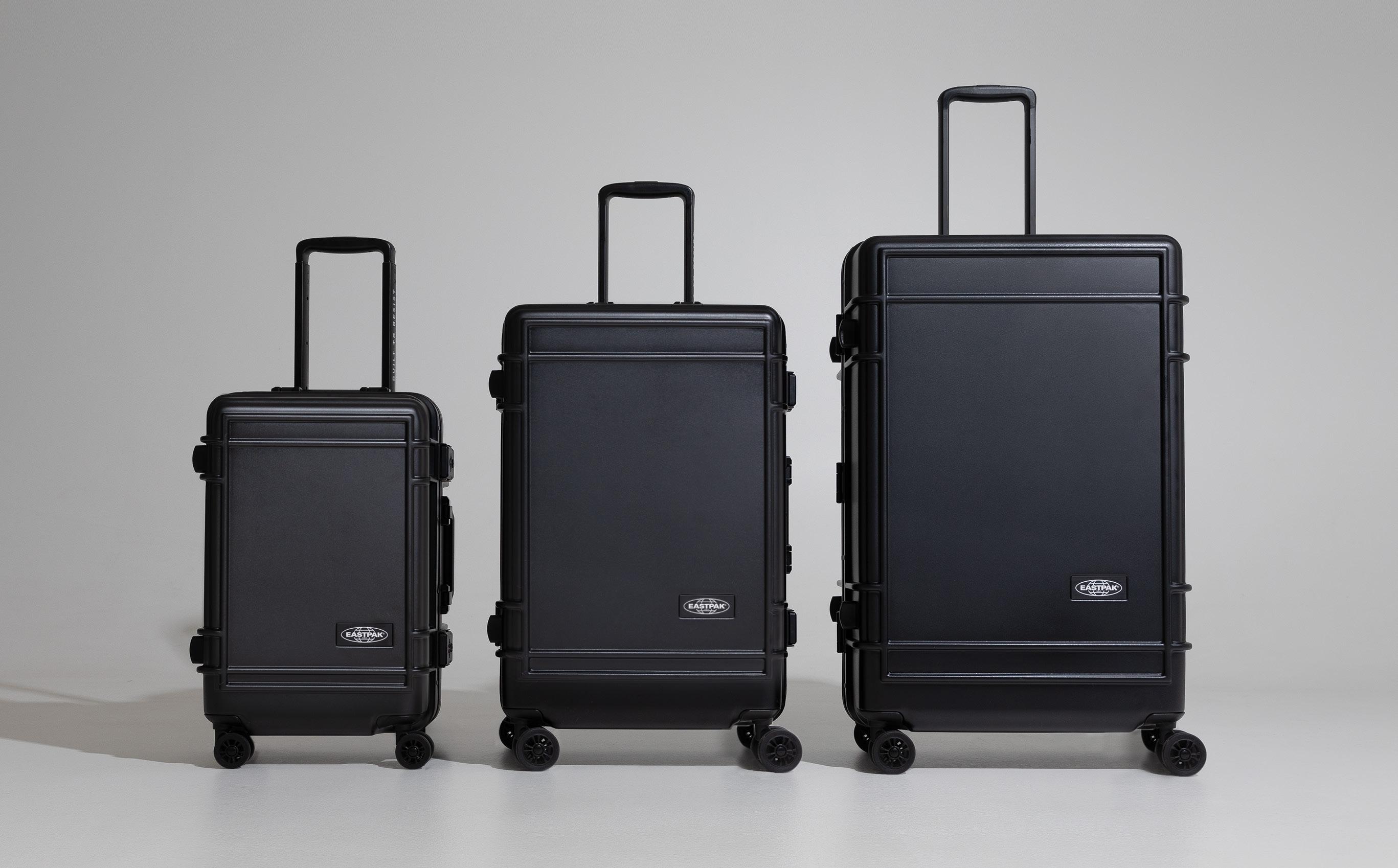
practical options that align with this evolving lifestyle.”
The American handbag, luggage and travel accessories brand will be exhibiting at both TFWA Singapore and TFWA Cannes with Hanse Distribution.
Product design and personalization
Personalization and adaptability also play a role in Asia. “Consumers want something that reflects their style and preferences,” comments Dix. When it comes to product design, she notes, hard side is the preferable option for luggage, with people seeking backpacks that are versatile, compact and a fit for their day-to-day life.
“There is a strong preference in the market for quality products and iconic design, and premium and even luxury players are leading within the market. Across most of our travel gear collection, we offer a unique personalization option inspired by the iconic Swiss Army Knife™. Customers can choose from a variety of colors and engraving
options for the scales, bringing the same beloved customization experience from the Swiss Army Knife™ to our travel gear,” says Dix.
As a response to travelers seeking baggage that not only serves a practical purpose, but also makes a statement, Eastpak introduced its Resist’r Case – a new hard-shell luggage that fuses high-performance design with strong visual appeal. As noted by Buyse, this award-winning case reflects Eastpak’s DNA, which is defined as: built to withstand the demands of travel while offering a bold and stylish look. Buyse remarks, “The Resist’r Case stands out with its robust build and premium materials, ensuring resilience throughout countless journeys. Additionally, its customization potential allows for unique collaborations and personalization – staying true to Eastpak’s heritage of self-expression.”
Right now, Eastpak is working to redefine the travel experience with a stronger focus on hybrid travel packs – designed for different occasions and
travel styles. It is also expanding its Resist’r Case line-up with a new zip version, which will be available in June in four sizes.
For Bric’s, there is a growing appreciation in Asia for its Legacy bag –products that carry a sense of heritage, quality and craftsmanship. The brand celebrates this through designs that balance tradition and innovation. When it comes to personalization, Bric’s Porsche Design collection embraces this trend with customizable stickers for trolleys and interchangeable leather tags. “Furthermore, select backpacks in the collection feature interchangeable zipper pullers in different colors, allowing travelers to add a personal touch to their accessories,” explains Puggioni.
Puggioni says, the company will participate in a key cruise-related event in June, reinforcing its growing presence in the channel. “We are already working with partners such as Harding+ and we see great potential in this market,” she concludes.


Struggling with effective PR at industry events?
We’re trusted by many to provide reliable, e˜ective media coverage with our short term industry event packages. With editorial, interview organisation, media monitoring and ad negotiations, Essential Communications is the industry’s first and leading TR specialist PR agency.

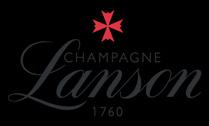





Essential Communications is an award-winning integrated public relations and marketing agency with a proven track record in travel retail/duty freeand international wines & spirits. We prefer plain talking and action to marketing speak and endless hype.
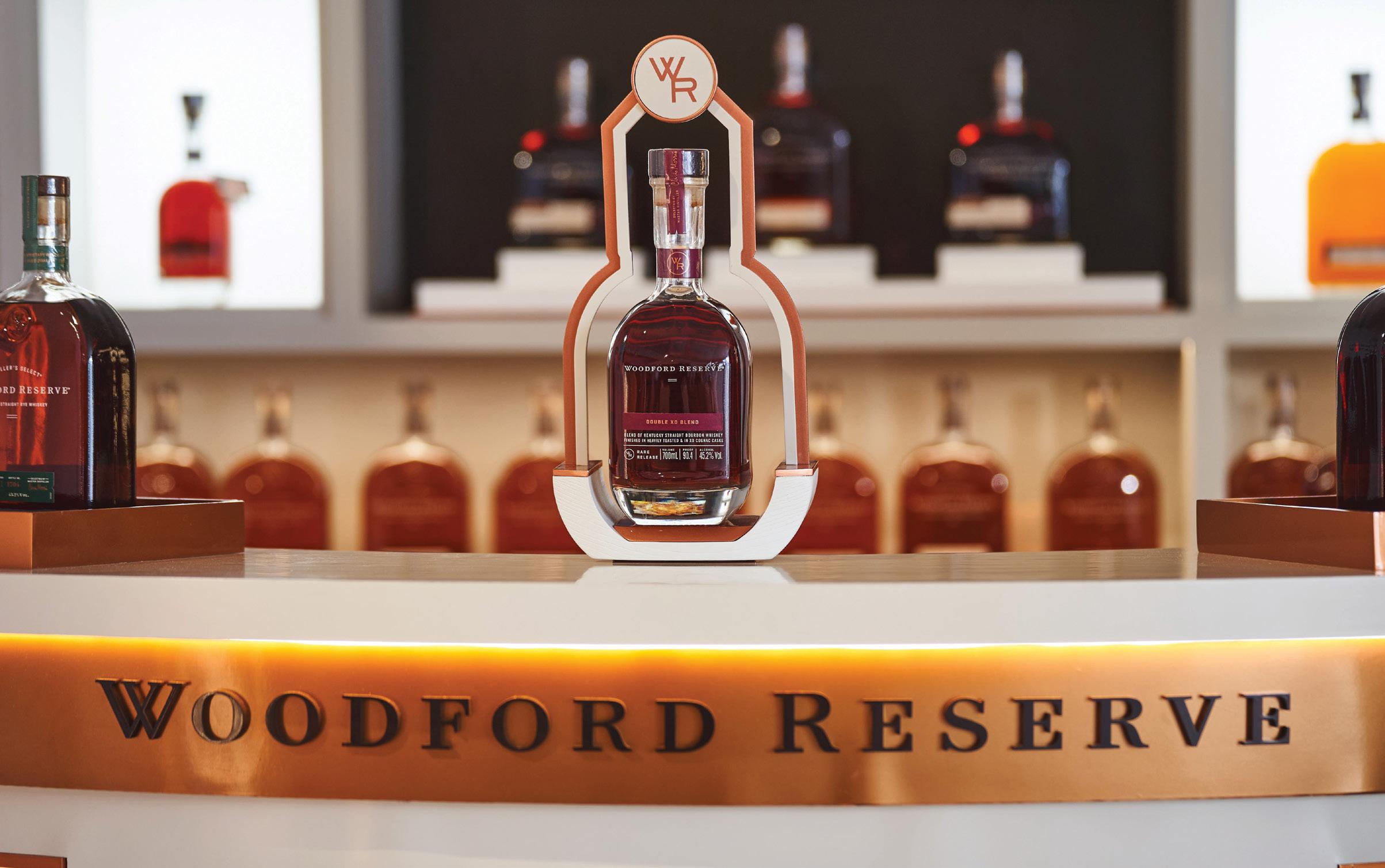
As travel retail rebounds across Asia Pacific, spirits brands are navigating diverse market dynamics through premium offerings, exclusives and innovative approaches to capture the attention of a new generation of consumers with evolving preferences and increasing purchasing power
by WENDY MORLEY
While premiumization continues to drive growth across Asia Pacific (APAC) travel retail, industry leaders point to marketspecific nuances and the rising influence of younger consumers as key factors shaping future strategy.
According to Andrew Cowan, Managing Director at Diageo Global Travel, the premiumization trend varies significantly by market. “Demand for high-quality, premium products
remains strong among discerning Chinese consumers. In India, we’re seeing growing interest in exclusivity and premium offerings, particularly limited editions and unique products,” he says.
For Brown-Forman, emerging markets represent significant opportunities. “We continue to see exciting potential in several emerging Asian markets, such as Vietnam, the Philippines and Malaysia,” explains Anton Skobelev, Commercial Director GTR Brown-Forman. “These markets benefit from a rising middle
class, increasing international travel, and a growing appreciation for premium spirits.”
Global Drinks is experiencing unexpected momentum with its newer offerings. “Global Drinks’ whisky brand MISAKA is performing above expectations due to filling a gap in aged Japanese whisky,” says Harry Kartasis, Managing Director at Global Drinks. “The MISAKA range includes 12yo, 15yo, 18yo and 21yo age expressions, which plays across several price points that didn’t exist.”
Exclusivity remains a key differentiator in the competitive regional landscape. “Travel retail exclusives and limited editions remain a strategic growth driver for us,” states Cowan. “We’ll continue to invest in the market – so watch this space for more in the coming months.”

Brown-Forman views these special offerings as fundamental to the company’s approach. “Travel retail exclusives and limited editions are a key pillar of our portfolio strategy in the Asia Pacific region,” Skobelev notes. “Given the competitive landscape, these offerings play a crucial role in meeting global travel retail shopper desires for discovery, exclusivity, and premiumization while also generating excitement around our brands.”
Jack Daniel’s Single Barrel 100 Proof, a travel retail exclusive, has experienced sustained success and good growth in Asia Pacific, according to Skobelev, adding that Woodford Reserve Double XO, which debuted as a limited edition in 2022, has seen expanded availability as a global travel retail exclusive following positive consumer response.
All three companies highlight changing preferences among younger Asian trav-
elers, who seek more meaningful brand interactions. “We’re seeing a clear shift towards experience-led shopping, with younger consumers placing more value on discovery, storytelling, and emotional engagement,” Cowan explains. “This aligns perfectly with our approach – one that goes far beyond product and point of sale.”
Brown-Forman observes similar patterns. “Travelers across Asian markets, particularly millennials and legal drinking age+ Gen Z consumers, seek more than just a product – they want experiences, authenticity and a sense of purpose in what they consume,” says Skobelev. “This generation is increasingly drawn to ‘better for me’ choices, as well as exclusive, craft-driven products that emphasize quality and storytelling.”
Consumption habits are evolving among these demographics. “While established categories like single malt Scotch continue to resonate, we’re seeing a strong appetite for explora-
Diageo’s AI-powered “What’s Your Whisky” tool enhances travel retail engagement by guiding consumers to personalized whisky profiles, blending digital innovation with storytelling –ideal for connecting with younger travelers
tion – whether through different whisky styles or evolving consumption habits,” Skobelev continues, saying younger consumers are more open to mixability, enjoying their spirits in cocktails and long drinks and favoring more social, shared occasions.
The balance between traditional and emerging categories is shifting. “Gin was once a rapidly growing category, but its expansion has slowed in Asia. We are seeing multiple de-listings across some well-known gin brands,” Kartasis notes.
For whisky, the landscape is nuanced. “The whisky market, particularly bourbon, experienced a boom during and after the pandemic, but has since cooled,” he adds. “However, premium whisky categories continue to attract consumers.”
Asian spirits are gaining traction both regionally and globally. “The diversity of Asian spirits, including Sochu and Umeshu, is gaining traction not just in the region but globally,” says Kartasis, who expects this trend to continue.
Brown-Forman is focusing particularly on its flagship brand across the region. “We continue to see a wealth of potential for the Jack Daniel’s trademark, and we’re investing in our presence across the region,” says Skobelev. “A key product in our Jack Daniel’s Super Premium+ portfolio is Jack Daniel’s Single Barrel, which continues to resonate strongly with Asian travelers while meeting global travel retail shopper desires for premiumization.”
For Diageo, the expanding Johnnie Walker portfolio remains central to company strategy. “We’re especially excited about extending the successful Johnnie Walker Black Ruby launch to APAC this year,” Cowan says. “It highlights the exceptional flavor of Black Label while appealing to a new generation of drinkers – particularly those who may not yet have explored Scotch.”
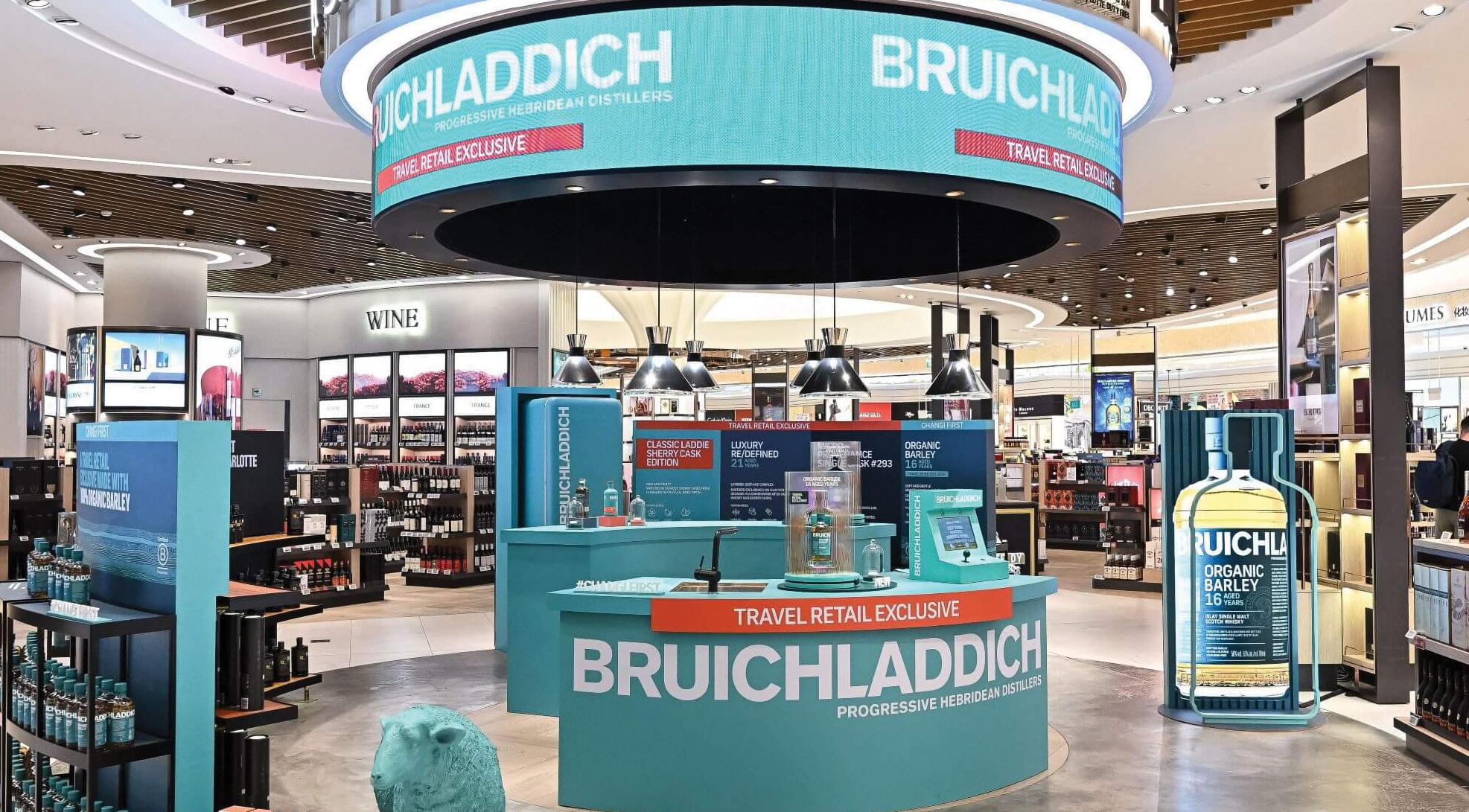

When it comes to the biggest factor shaping the spirits category in Asia travel retail in 2025, it is agreed the returning traveler tops the list. Overall traveler figures in Asia Pacific exceeded 2019 levels last year (source: ACI) and this is expected to continue. However, it is shared knowledge that the preferences and priorities of these returning travelers have changed and brands must learn to adapt to succeed.
Key consumer-driven trends across the spirits category of premiumization, exclusivity and craftsmanship show no signs of slowing down. Global Travel Retail Magazine connects with leading names in the channel to discuss emerging segments, evolving trends and new developments
by LAURA SHIRK
“The speed and scale of Chinese outbound travel recovery will remain pivotal across all premium spirits categories in 2025. Encouragingly, the Lunar New Year period saw a strong resurgence in Chinese travel, aided by visa policy changes that have eased movement across Southeast Asia – Singapore being a prime beneficiary,” says Alice Hoffman, Marketing Director Global Travel Retail at Rémy Cointreau. “This rebound is fuelling a positive trajectory for luxury spirits demand in key travel retail hubs.”
According to Hoffman, the leading consumer-driven trends of premiumization, exclusivity and craftsmanship show no signs of slowing down. “Affluent travelers continue to seek high-quality, limited edition products, often tied to unique provenance and storytelling. This is reinforced by the rise of experiential retail, where consumers expect immersive, educational and engaging brand interactions before purchase,” she explains.
Rémy Cointreau has a series of highprofile promotions planned for 2025, each tailored to showcase its premium portfolio and create memorable brand experiences for passengers. The company debuted its new global travel retail exclusive single malt, Bruichladdich Organic Barley 16 Aged Years, in March
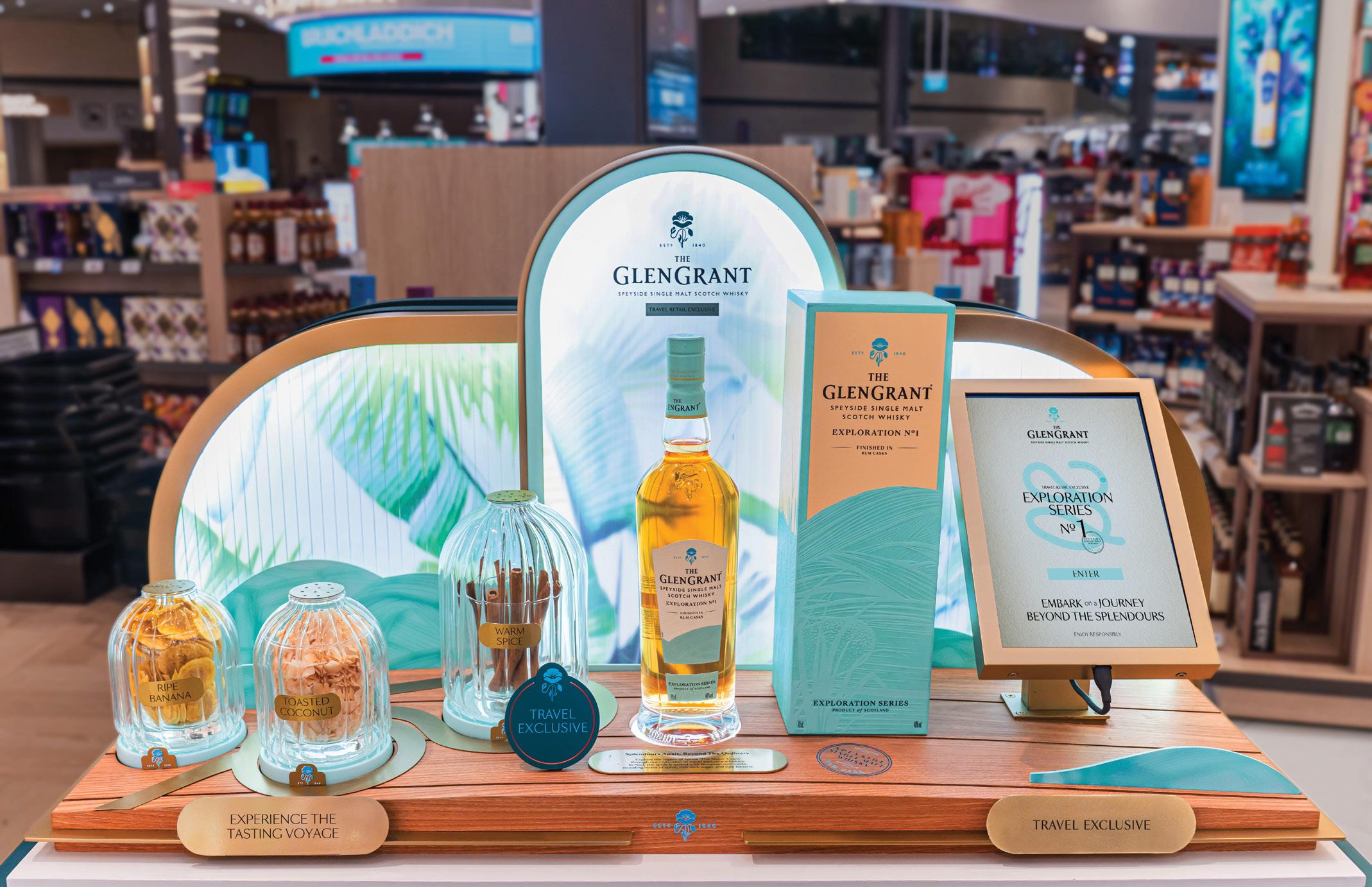
at Singapore Changi Airport in partnership with Lotte Duty Free. Rolling out now across key hubs in Asia Pacific, the introduction saw the support of a “Not Your Classic” activation at Changi which featured a Bruichladdich Tasting Bar pop-up, a life-size sheep model, experiential merchandising displays and an interactive jumping game.
Describing the returning traveler as also more diverse, Biancamaria Sansone, Marketing & CCM Director at Campari Group Global Travel Retail, notes the company is witnessing strong growth in female and younger travelers exploring the category, particularly whisky, premium ready-to-drinks and agave-based spirits. The group is also seeing a robust premiumization trend among Indian travelers in Asia.
“The diversity of the returning traveler in Asia brings new dynamics to the market. Looking at outbound travel, the recovery of Chinese travelers is continu-
ing, and we are seeing a surge in Indian travelers, due to the country’s rapidly growing middle class. Travel hotspots in Asia include Japan and Southeast Asia, as travelers seek to connect with different cultures and experiences,” shares Sansone.
While Chinese travelers are spending more mindfully than before COVID-19, Sansone says, they are developing a taste for premium imported spirits, cocktails and more diverse flavors.
“We connect with diverse travelers by tailoring our offerings across the region. Our current focus is on the launch of The Glen Grant Exploration No.1 – the first in a collection of limited release single malt Scotch whiskies,” comments Sansone. “This unveiling marks our first avant-première launch in global travel retail, a reflection of the growing importance of the channel to Campari Group.”
The Glen Grant Exploration No.1 is available at 37 premium Asia Pacific airport touchpoints across eight key countries. The collection celebrates
James ‘The Major’ Grant’s worldly quests to uncover flavors through experimentation with diverse cask finishes. Sansone adds, “We are supporting the launch with our largest omnichannel marketing strategy to date. The Glen Grant Exploration No.1 will seamlessly engage travelers through bespoke flavor discovery experiences, engaging tastings and digital partnerships.”
Taking place from April to June, Campari Group Global Travel Retail’s hero animation at Hong Kong International Airport centers on an aroma discovery experience. The activation in Hong Kong will be complemented by a dynamic KOL (key opinion leader) press trip in the city and in Singapore, a planned strategic partnership with ride-hailing company, Grab, to engage travelers on their way to the airport.
Nationality-driven preferences and emerging segments When it comes to emerging trends across the category, gifting and shar-

ing remain key for both the whisky and cognac segments across nationalities and demographics. Campari Group Global Travel Retail sees strong traction when it curates bespoke offerings in this space. “This includes festive releases at Chinese New Year, dialling up exclusivity through limited editions and travel exclusives and offering personalization services,” says Sansone.
As shared by Hoffman, in cognac, nationality-driven preferences remain a key consideration. Rémy Cointreau’s Lunar New Year and limited edition coffrets have been “exceptionally well” received this year, reinforcing the importance of regionally relevant exclusives. Looking ahead, it will continue to expand its sense of place strategy, offer-
ing location-inspired releases in line with different brands from its portfolio to strengthen the emotional connection between the product and the consumer.
The continued growth and exploration of emerging segments like premium tequila give Asia travelers the opportunity to discover new premium brands. Proximo Spirits has expanded its 1800 tequila range across Asia travel retail, giving passengers the opportunity to try the world’s most awarded tequila. “Singapore and Indonesia are among the first regional markets to see 1800 GuachiMonton, our luxury añejo tequila aged in American and French oak barrels and finished in orange tequila liqueur casks; this launch points to the region’s appetite for luxury tequila
products,” says Roy Summers, Head of Global Travel Retail at Proximo Spirits.
Proximo Spirits recently launched its Bushmills World Wood Series of malt whiskies in global travel retail in India. The channel exclusive series encourages passengers to explore whiskeys that offer “unparalleled depth, unique flavors and a refined craftsmanship that embodies the heritage of Bushmills.” According to Summers, the range has been specially designed with the travel retail shopper in mind, offering something for both whisky explorers and enthusiasts, and perfect for gifting. To build its presence in this rapidly growing market, the company worked with airport retail partners in Hyderabad, Delhi and Mumbai on the release.
According to Serdal Ersoy, Sales Director, Asia Pacific, Middle East & Global Travel Retail at Yoshino Spirits, Japanese whisky continues to attract strong consumer interest for both personal consumption and gifting, driving steady growth in Asia’s travel retail sector. Ersoy shares several key factors that will shape the category in 2025:
1. Demand for exclusivity, craftsmanship and innovation
• Collectors and enthusiasts actively seek limited editions and travel exclusives, while adventurous consumers are eager to explore new flavors and aromas
• Japanese whisky is renowned for its unique aging techniques, with brands continuously innovating through different types of wood cask maturation
• South Korean buyers are drawn to well-branded Japanese whisky with unique finishes, particularly those with a story rooted in craftsmanship
• Southeast Asian travelers are increasingly interested in Japanese whisky as a status symbol, opting for exclusives they can showcase socially
2. Supply constraints and interest in discovery
• The global demand for Japanese whisky has led to supply constraints, making aged expressions increasingly scarce and expensive
• Although previously authenticity concerns led many consumers to prefer well-established brands, thanks
to evolving regulations and increased transparency, consumers are now open to discovering new brands, particularly those that offer innovative cask finishes and unique flavor profiles
3. Gifting appeal
• The Asian market places significant value on whisky as a prestigious gift. Limited edition releases, elegant packaging and personalized offerings enhance Japanese whisky’s appeal as a high-end gifting choice
• Festive occasions like Lunar New Year, Golden Week and Mid-Autumn Festival significantly drive sales
Discussing how Yoshino Spirits is activating Japanese whisky through bespoke displays and promotions in Asia, Ersoy notes the company is strengthening the presence of Kamiki and its other Japanese whisky brands via in-store activations, tasting events and educational sessions that feature its production techniques, specifically Cedar and Sakura cask finishing.
“Japanese whisky continues to be one of the most vibrant and highly sought-after categories in Asia travel retail,” Ersoy affirms. “As consumer preferences evolve, maintaining authenticity, embracing innovation and reinforcing premium positioning will be key to sustained success. At Yoshino Spirits, we remain dedicated to offering exceptional Japanese whisky experiences through craftsmanship, innovative products and retail activations.”
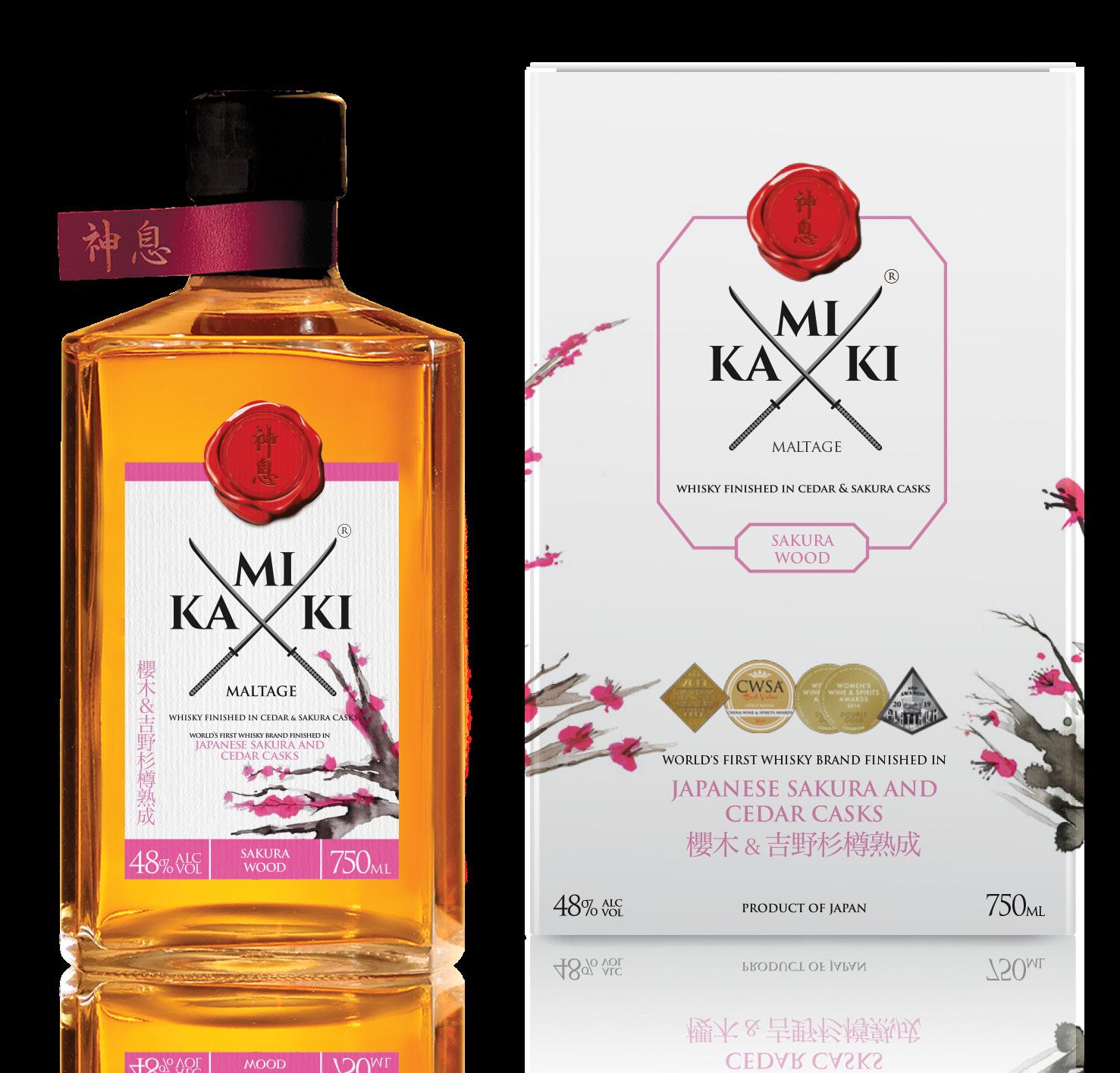
Yoshino Spirits is strengthening the presence of Kamiki and its other Japanese whisky brands via in-store activations, tasting events and educational sessions that feature its production techniques, specifically Cedar and Sakura cask finishing
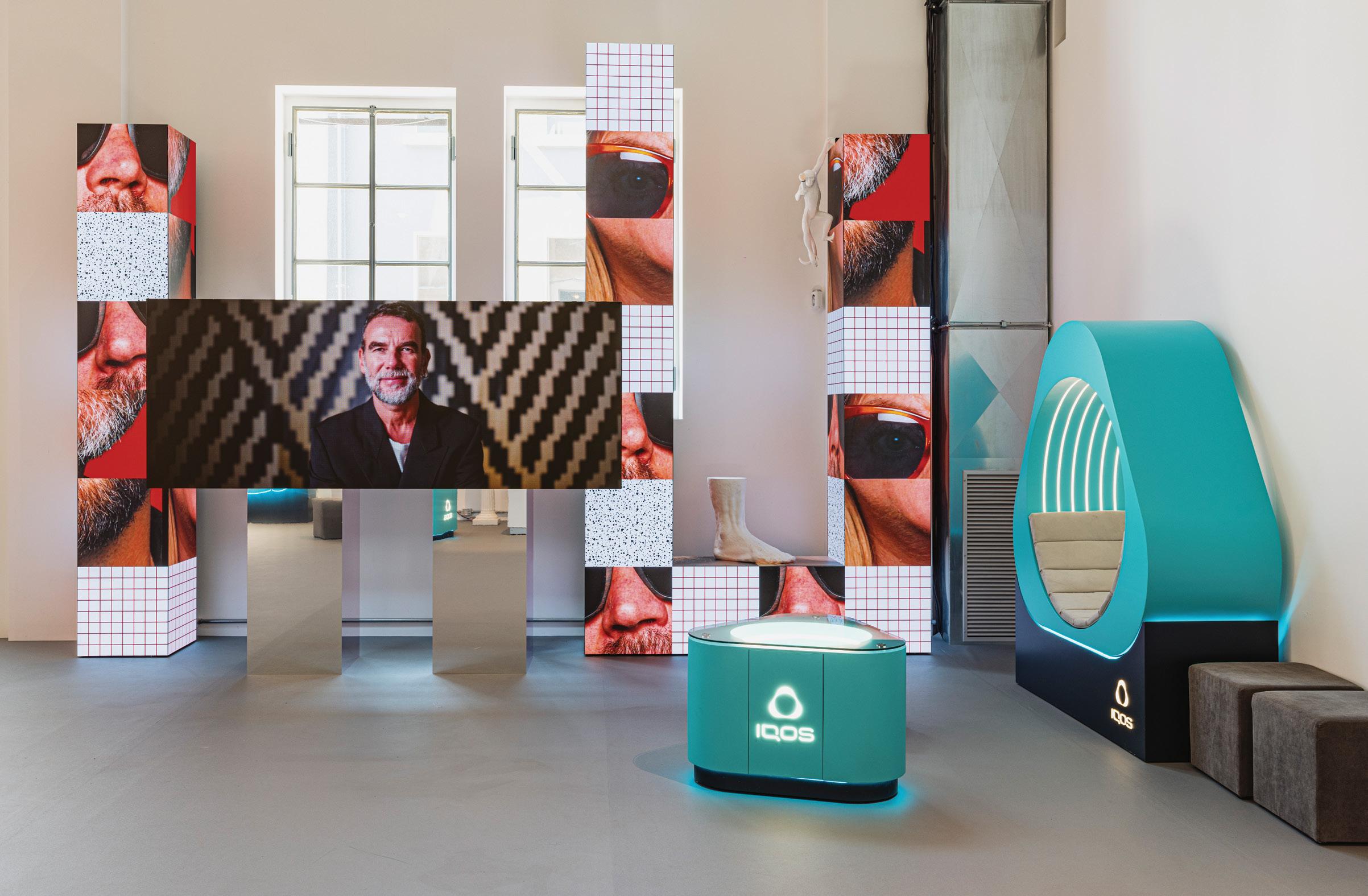
Philip Morris International (PMI) revealed a collaborative installation and interactive platform, IQOS Curious X, as part of Milan Design Week, created in partnership with Italian design firm SELETTI. Global Travel Retail Magazine was on location at Milan Design Week to take part
by ALISON FARRINGTON
The Curious X Sensorium Piazza installation launched in April at the Salone de Mobile design fair and intends to challenge the status quo to realize something truly unexpected for a community of more than 32 million adult smokers who have made the choice to move away from cigarettes.
The Curious X Sensorium Piazza is a bold reimagination of the traditional Italian Piazza – a multi-sensory space where people meet, converse and connect. The installation bridges the physical world into an unexpected digital dimension where art and technology
intertwine to create meaningful and extraordinary interactions, inspired by and featuring the people who visit its space.
The project also marks the debut of the new experiential platform, IQOS Curious X, intended to deliver inspiring experiences to the brand’s ever-growing community of adult tobacco consumers, and this will be brought to life through a yearlong collaboration with SELETTI Curiosity, the engine of creativity and innovation according to the company, is at the heart of the journey experienced by the over 32 million users of IQOS globally.

“Our collaboration with SELETTI is driven by the shared belief that curiosity paves the way to ground-breaking creativity which inspires us to connect, explore new possibilities beyond the limits and challenge the status quo. Being forever curious at IQOS is what ultimately enables our quest for the continuous development of better smoke-free alternatives versus smoking,” said Stefano Volpetti, PMI’s President of Smoke-Free Products & Chief Consumer Officer.
In conversation with Global Travel Retail Magazine at the Milan event, Volpetti said, “It’s always important to look


back at our journey of how we started from a vision of realizing a smoke-free future. That was completely challenging the status quo, and this notion of challenging the status quo has brought us to the success of today – we have 32 million adult smokers that switched to IQOS, two thirds of which left cigarettes behind completely.”
It’s clear that smoke-free alternatives like IQOS are a better choice for adults that want to continue to use nicotine, explained Volpetti. “This notion of something that has never been done before, something that challenges the status quo offers us an opportunity to go deeper [as a brand] and you try to understand where is the genesis of it all. It’s this incredible curiosity for a company to completely reinvent a category, but also curiosity from the smokers to completely change their routine,” he added.
“For PMI, the IQOS Curious X project represents a statement of centrality in its pursuit of curiosity, and it’s from this theme that progress and innovation stems,” said Volpetti.
From the global travel retail market perspective, Beste Ermaner, Vice President Global Travel Retail at PMI, told the publication this project is all about brand building for IQOS and leveraging “GTR’s window to the world” opportunity.
“The IQOS Curious X project will serve both our domestic customers and travelers in global travel retail. It opens a fantastic opportunity, in terms of brand building and delivering a compelling consumer experience,” stated Ermaner.
This project is about how PMI is building its multi-category business in the channel. “We are the leaders of heat-not-burn with IQOS, and that is our biggest smoke-free product category worldwide. However, consumers are evolving, their needs are evolving and there is no longer just one product that can fulfill their needs, so we know we have to offer them a variety of options –for those consumers who wish to switch out from cigarettes,” she continued.
Ermaner noted the importance of PMI’s multi-category portfolio in order to offer adult nicotine consumers a
choice of smoke-free products: IQOS for heat-not-burn, ZYN for the nicotine pouch offer, VEEV for the e-vapor category. “For example, nicotine pouches are the fastest-growing product category in travel retail,” she added.
Consumers are extremely open to explore in the travel retail channel, explained Ermaner. “New products, new experiences, like the name of our new platform – they are curious! When traveling, consumers are at the peak of their curiosity in terms of exploring. Plus, it’s important to remember, the travel retail environment is a much more premium environment. So, we are also offering a premium experience for consumers.”
Ermaner said global travel retail offers scale and an ability for deployment at speed to amplify awareness of both new products in general, also the new brand platform. “IQOS Curious X is a great opportunity to connect with consumers looking for a unique experience, and we will be deploying it wherever we can, further amplifying the consumer awareness,” she concluded.
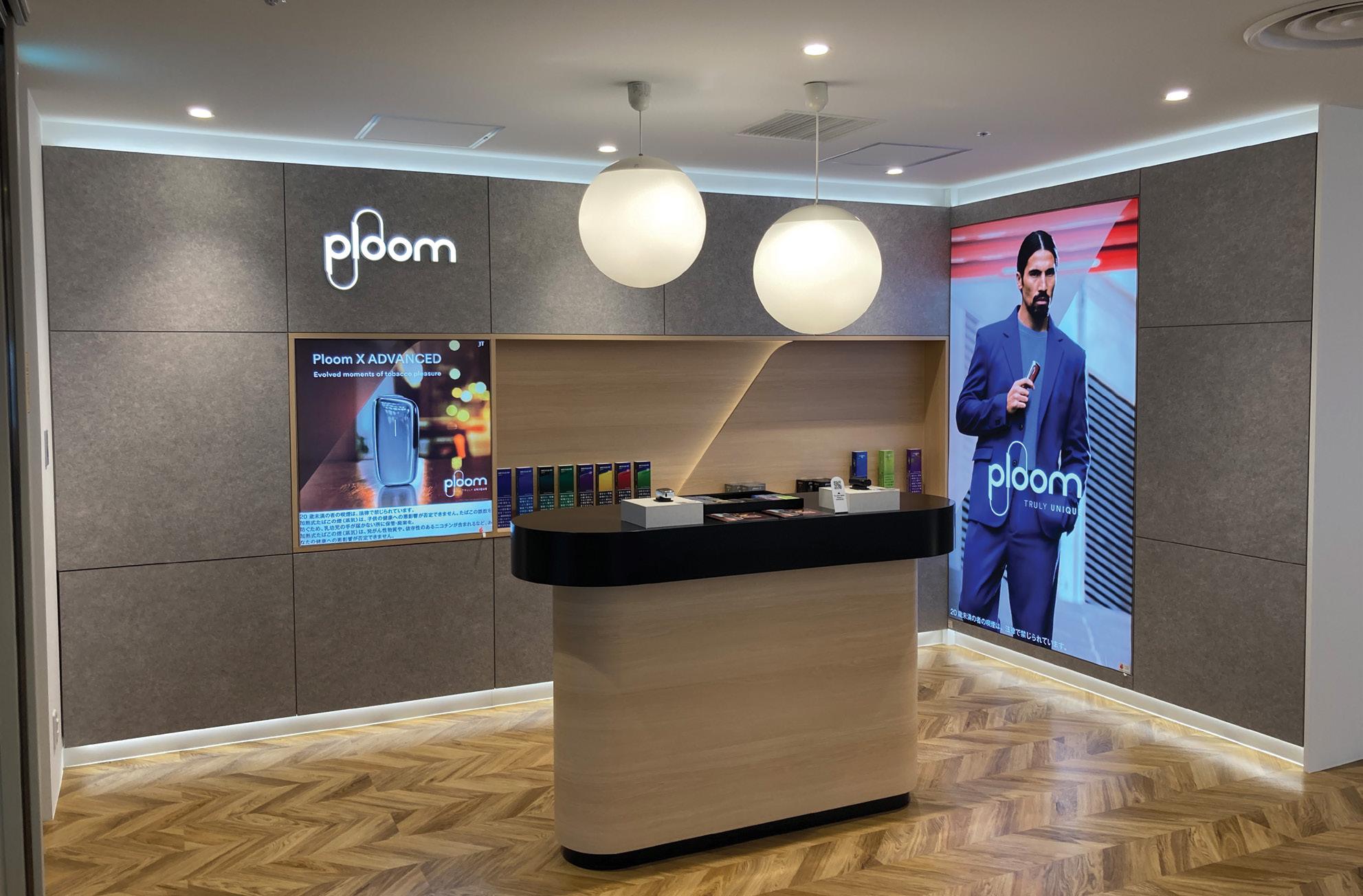
JT International (JTI) on its innovative brand Ploom and how the company’s vision extends further with the growth of its reduced-risk product category; plus, Mevius wins big with a strong festive season
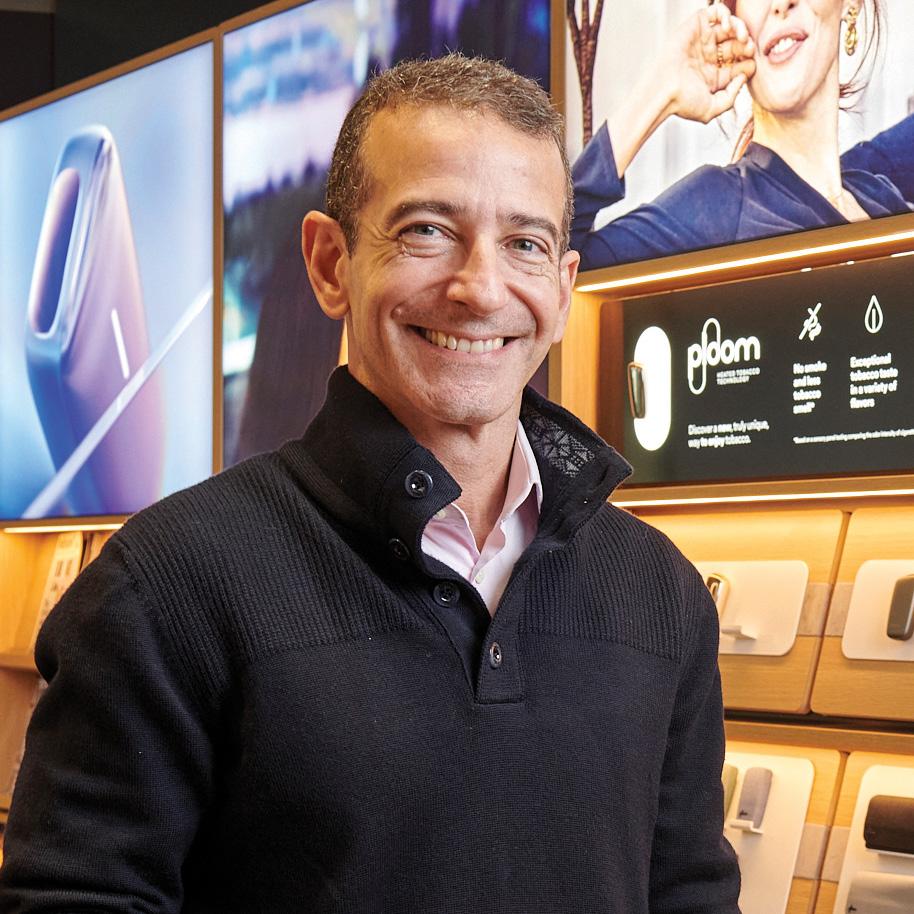
International tobacco and vaping company JTI is described as already making waves at major international airports including Geneva, Zurich, Milan, Rome, Athens and Madrid. According to Global Travel Retail General Manager, Claudio Ferreira, one of its latest launches is
by LAURA SHIRK
the limited edition Ploom device and accessories at Rome Fiumicino Airport. The line was created from an exclusive collaboration with renowned French designer Ora ïto.
“Combining groundbreaking technology with artistic sophistication, the special edition Ploom and its accessories redefine the consumer experience, offering something truly unique for modern adult travelers. The campaign delivers a fresh and exciting consumer experience, showcasing JTI’s commitment to bringing innovation to the travel retail market,” shares Ferreira.
Ploom is a brand of tobacco heating devices that integrates both traditional and electronic cigarettes. With its journey into new travel retail markets well underway, JTI is planning to expand the brand to other regions including Asia.
Growing the reducedrisk product category
Speaking about diversifying JTI’s portfolio to respond to developing consumer preferences among its adult consumer base, Ferreira says as the owner of some of the world’s most well-known brands, JTI needs to remain flexible in adapting to changes by offering more convenient packaging options, exclusive promotions and immersive shopping experiences.
JTI offers a multi-category portfolio with continued emphasis on combustibles (cigarettes and roll-your-own), which remain the backbone of the category. The company has a strong portfolio of leading brands in Asia centered around Mevius, the leading tobacco brand in Japan. As noted by Ferreira, JTI’s consumer-centric offerings that

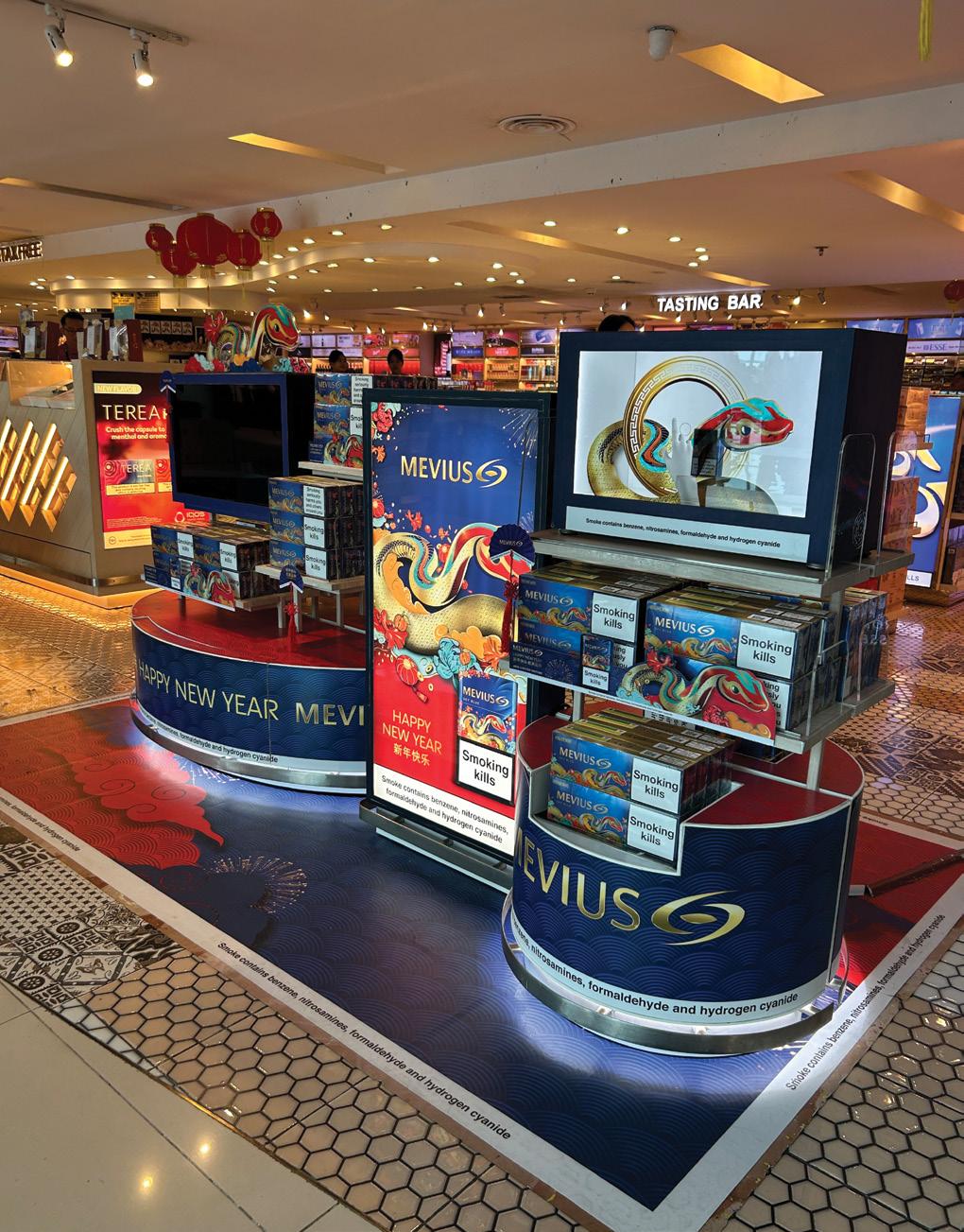
are well-received by adult consumers in Asia include innovation launches, Flavor on Demand and Super Slims segments like Mevius E-Series, Tokyo Craft Ice, Option Fizzy Twist, Freezy Dew and Summer Sling.
“Our vision extends further with the growth of our reduced-risk product (RRP) category, and Ploom is an excellent example of how we’re rethinking innovation to meet consumer needs,” he says. “We focus our investment and innovation efforts on providing our consumers with a wide range of alternative products that have the potential to reduce the risks associated with smoking and are marketed responsibly.”
There is a growing interest in the demand for reduced-risk products such as heated tobacco, as displayed by the uptake of Ploom, as well as RRP as a destination category. This is reflected by the increasing share of sales. “This trend is driven by increased awareness among consumers seeking alternatives to traditional combustible cigarettes with a potential to reduce the risks associ-
The growing demand for reduced-risk products such as heated tobacco is driven by increased awareness among adult consumers seeking alternatives to traditional combustible cigarettes
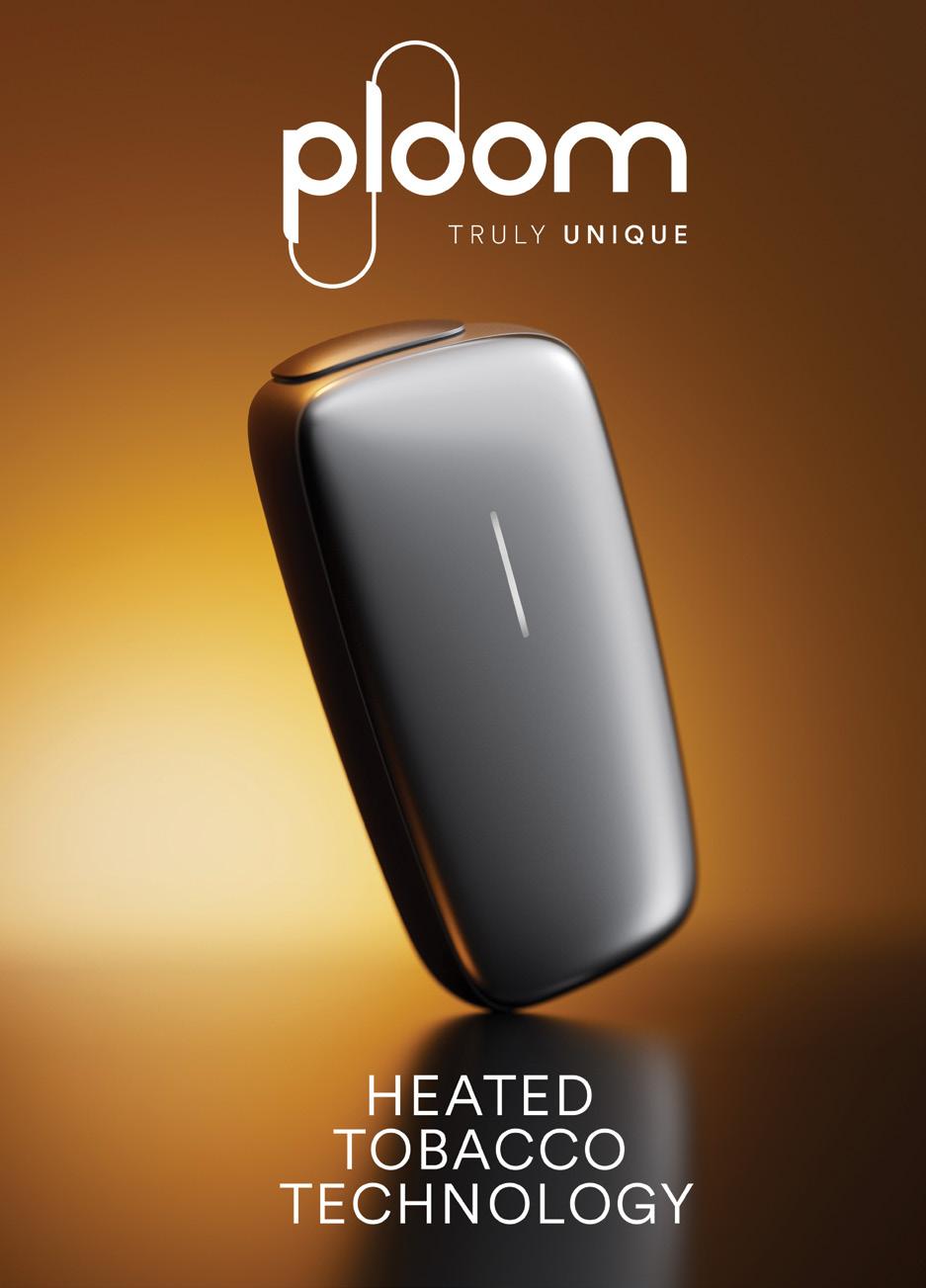
ated with smoking,” Ferreira explains. While Ploom remains the primary focus of its RRP portfolio, JTI is also excited to enhance its offering of reduced-risk products in connection to its nicotine pouch brand, Nordic Spirit, in European travel retail markets.
When browsing duty free travelers often seek convenience and exclusivity. In many Asian countries, gifting is intertwined into the culture, especially during festive seasons. Throughout January, JTI witnessed an “outstanding response” to the launch of its Mevius Chinese New Year Limited Edition Pack, with more than 70% of allocated stock sold in Jakarta, Indonesia. The company celebrated the Year of the Snake by engaging consumers in a dynamic series of campaigns that brought the festive spirit to life.
On the relevance of the channel for tobacco, particularly when it comes to
duty free serving as a major contributor to illicit trade, it is affirmed that duty free is transparent, highly controlled and one of the most securely managed in the world. Both the manufacturers and retailers have rigorous security controls and supply chain procedures in place. Despite initiatives such as the “Duty Free: Trusted, Transparent, Secure” campaign, the travel retail industry is facing threat from illicit manufacturers that have the potential to cause economic and reputational damage.
“Together, with other duty free industry representatives, we continue to raise awareness and collaborate with customs and law enforcement agencies around the world to ensure criminal activities such as illicit trade have no place in it,” states Ferreira. “With such high standards of control and compliance in the duty free channel, we believe the tobacco category will continue to remain a most relevant category in the context of global travel retail.”
VINTAGE 2022 - PROSECCO DOC

TFWA SINGAPORE 2025 11-15 MAY 2025
HALL: BASEMENT 2, STAND: 2-M9




















Our Spectra 3.0. Durable and stylish Carry-on. Front-opening compartment for priorty access to essentials. The ideal choice.